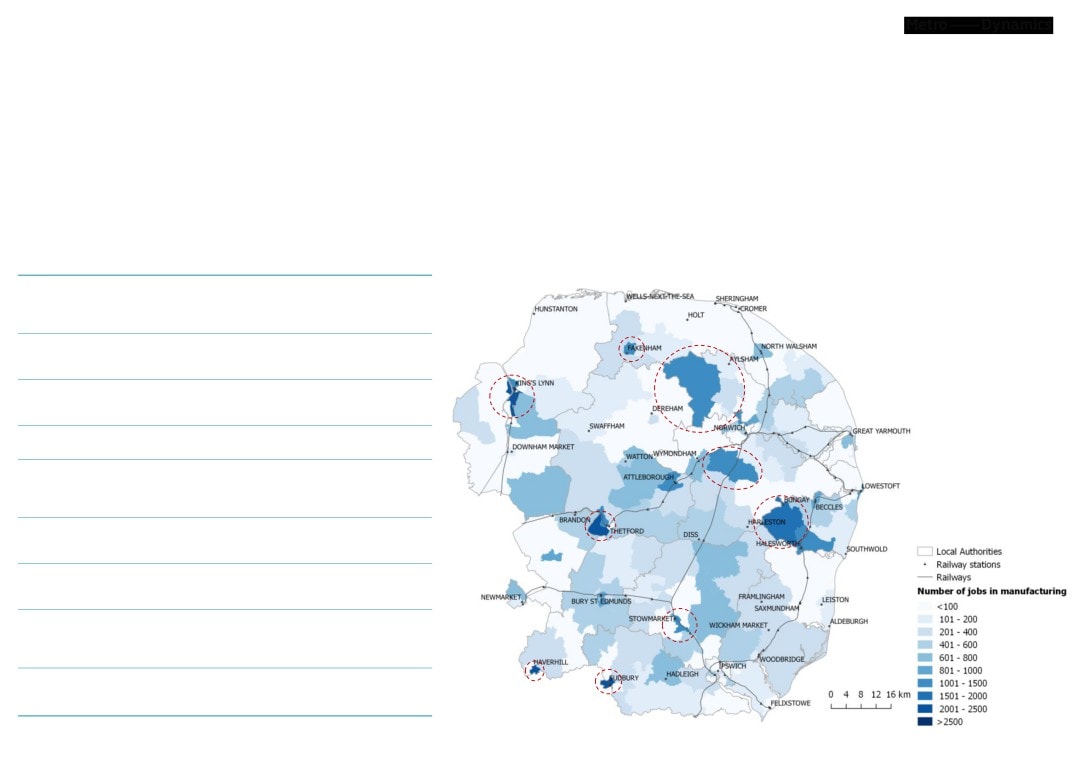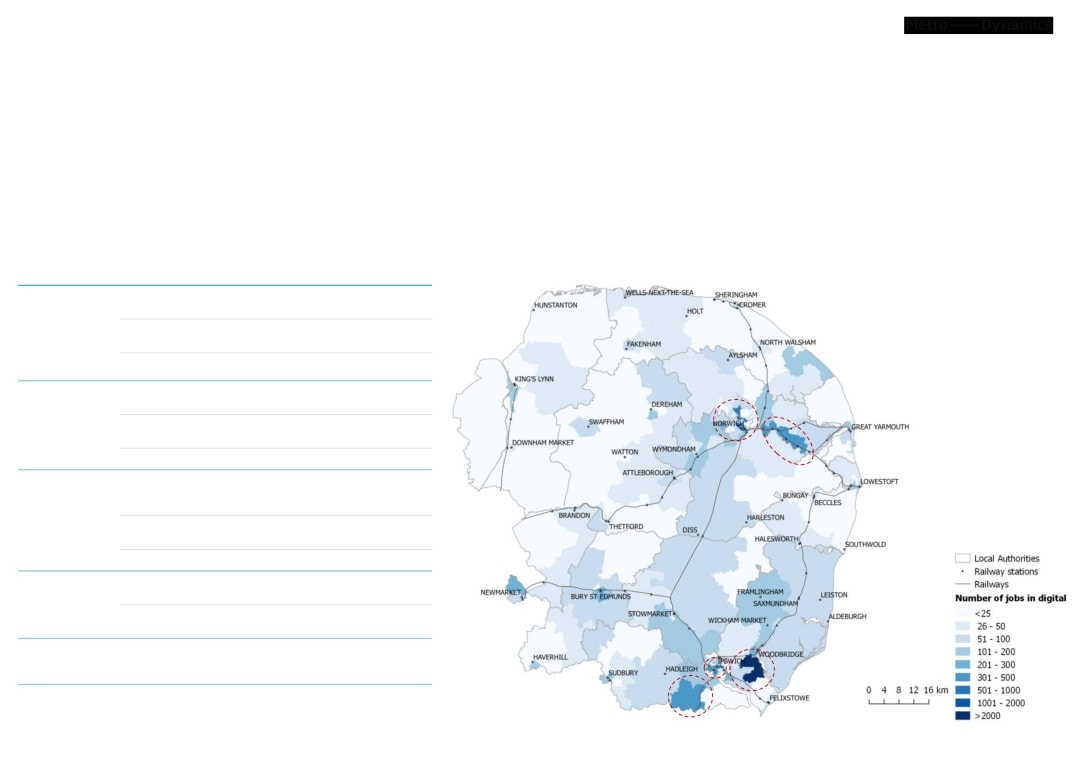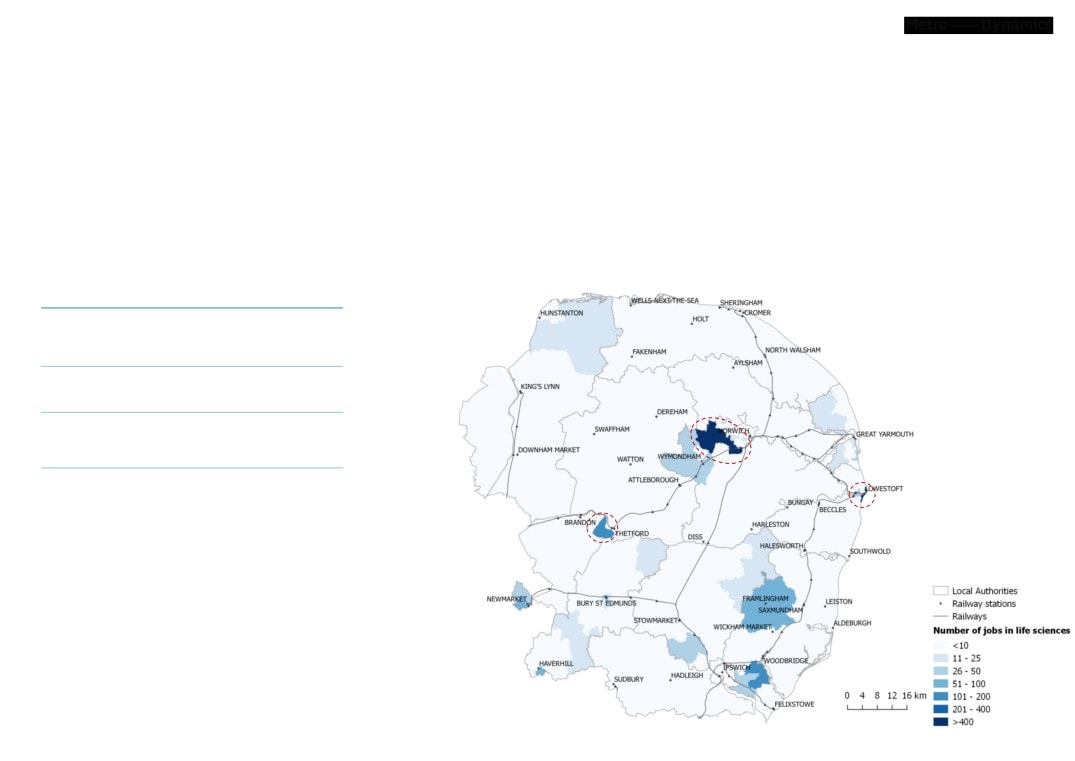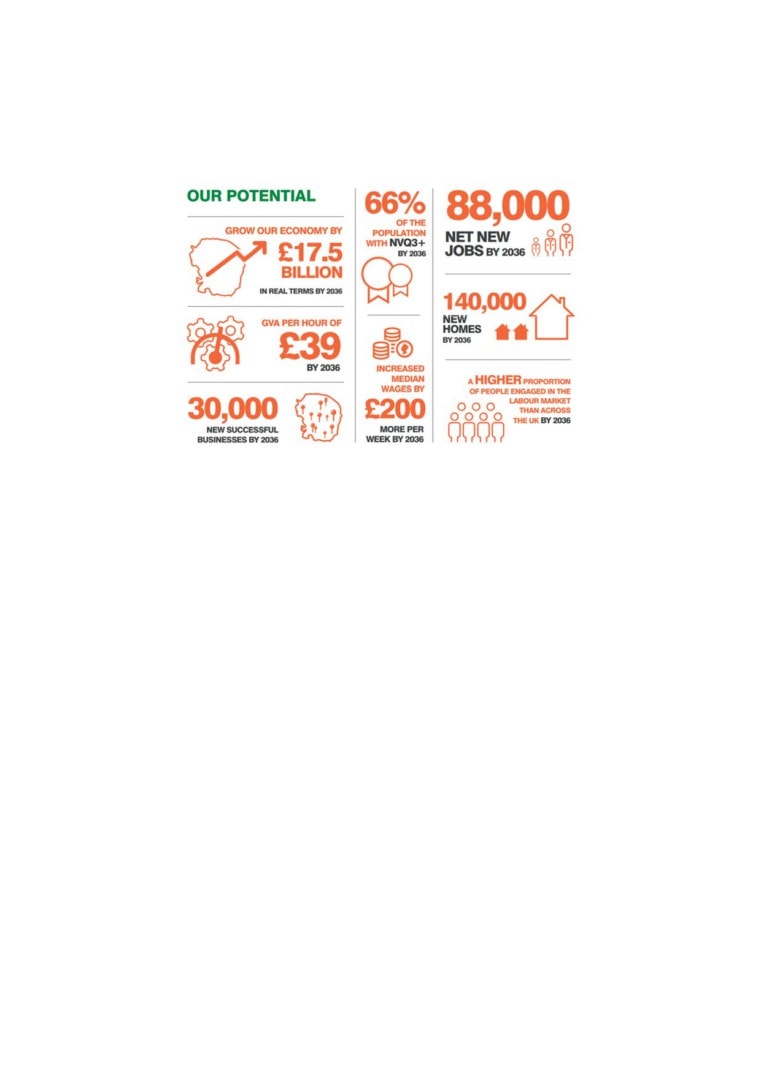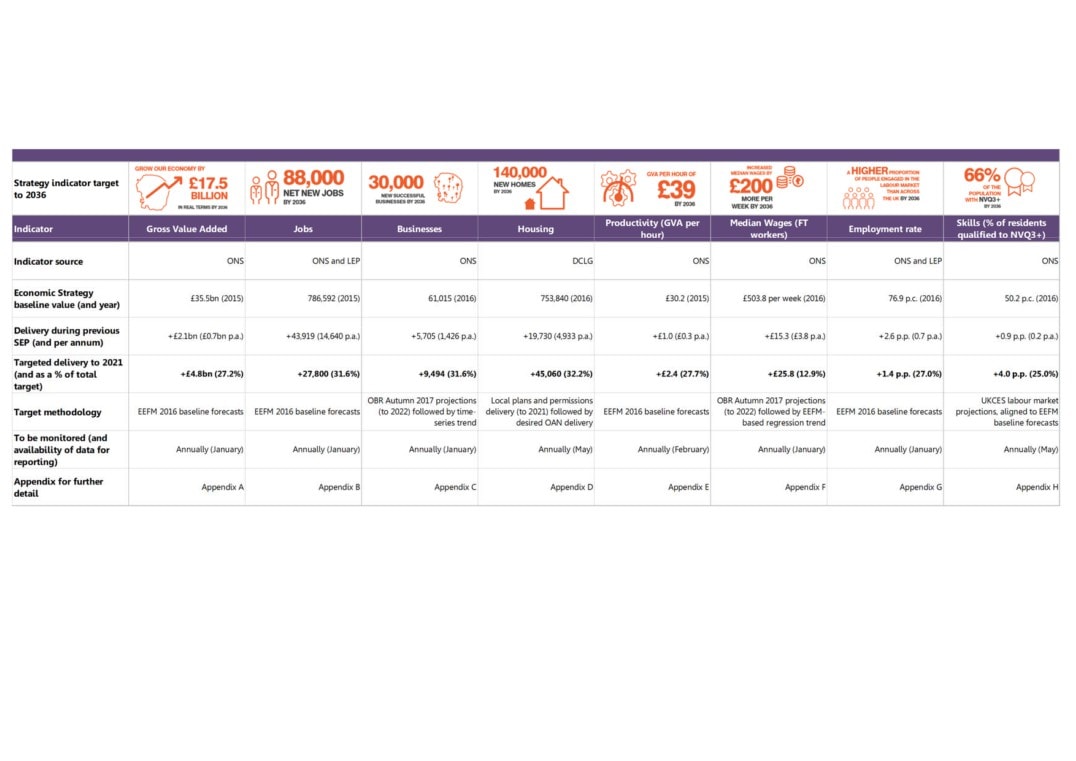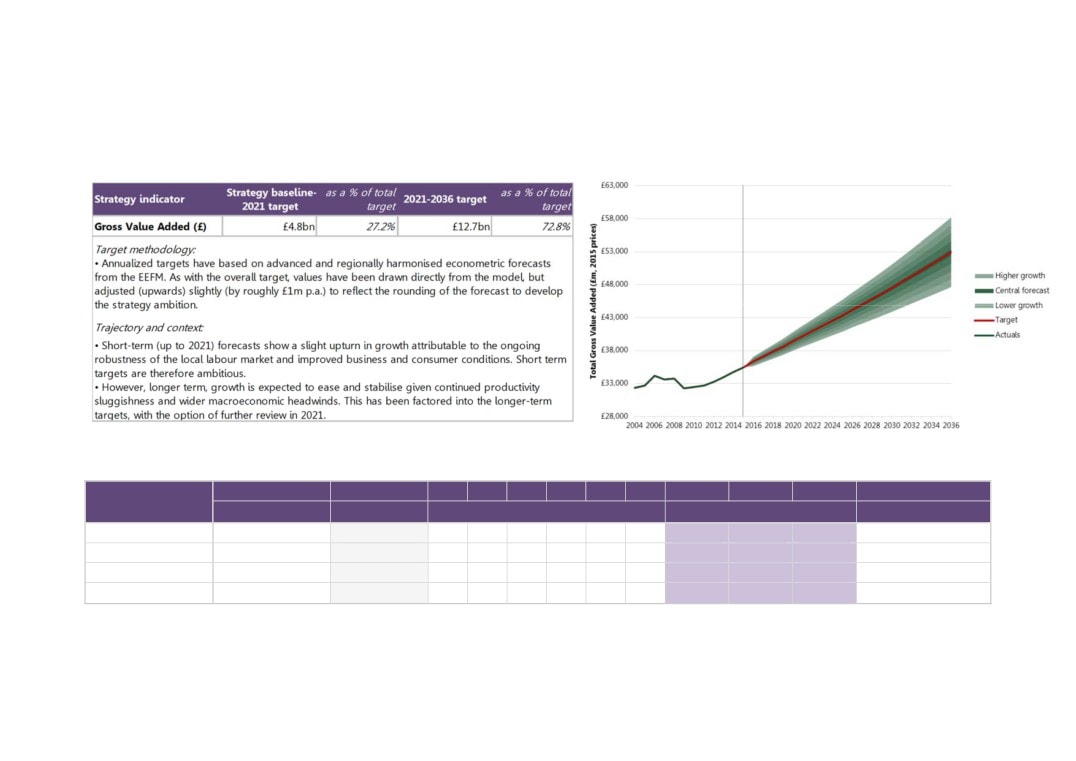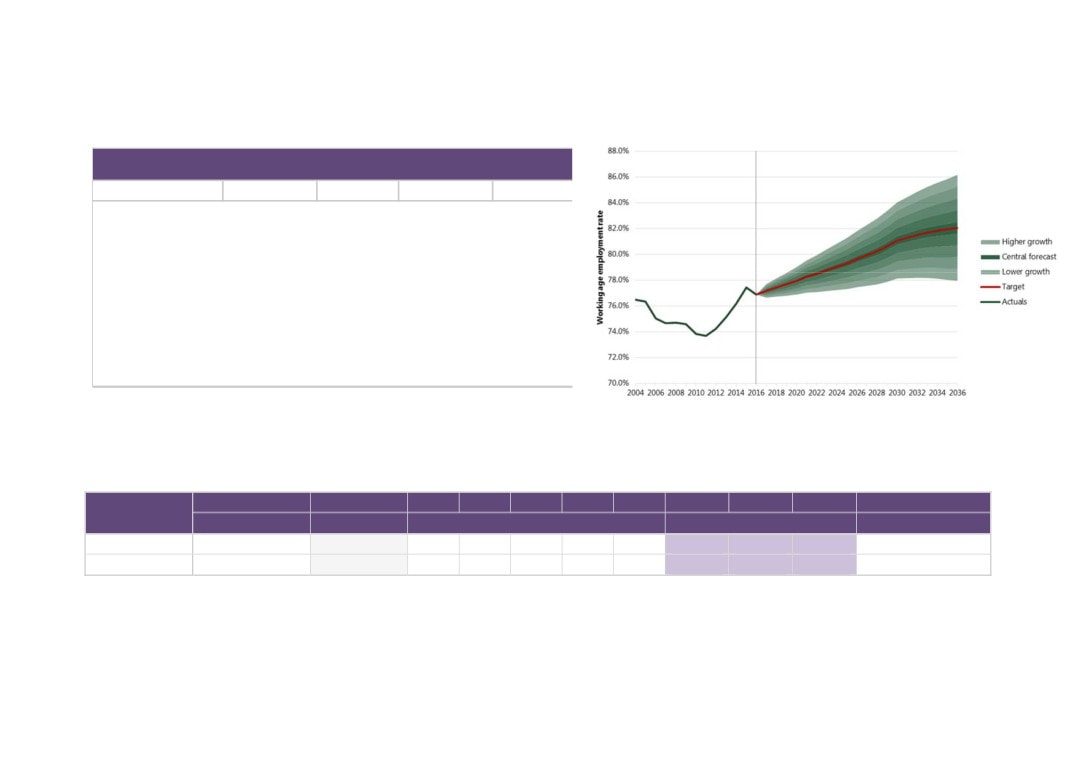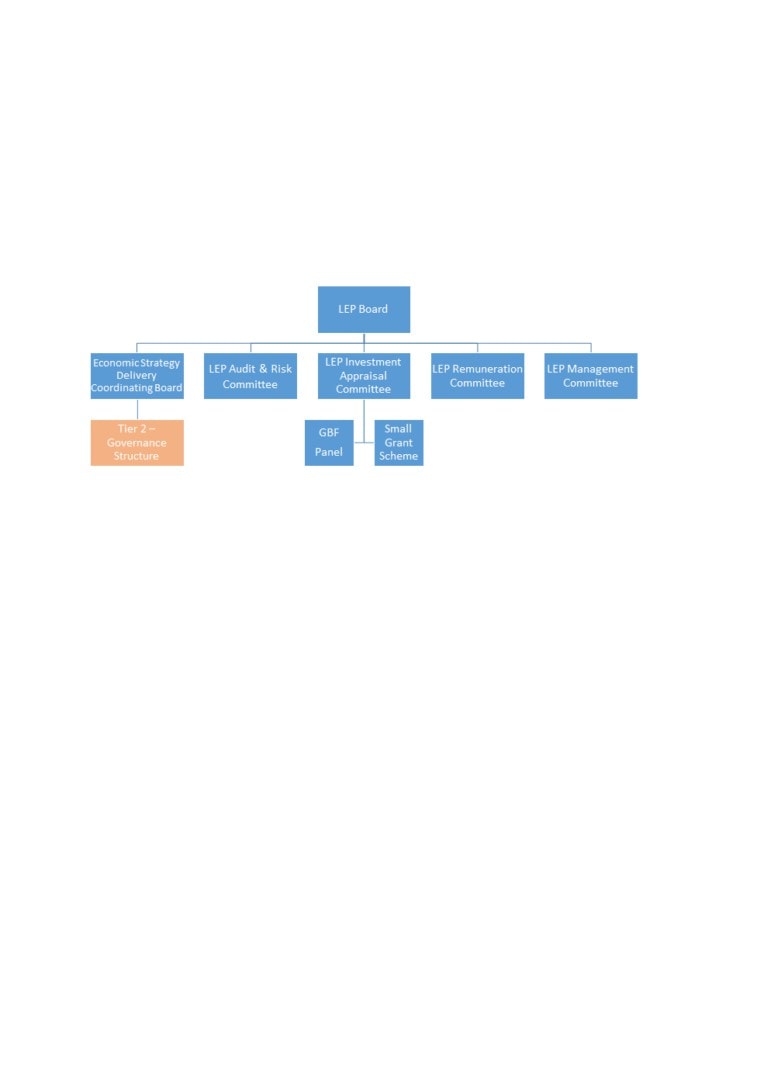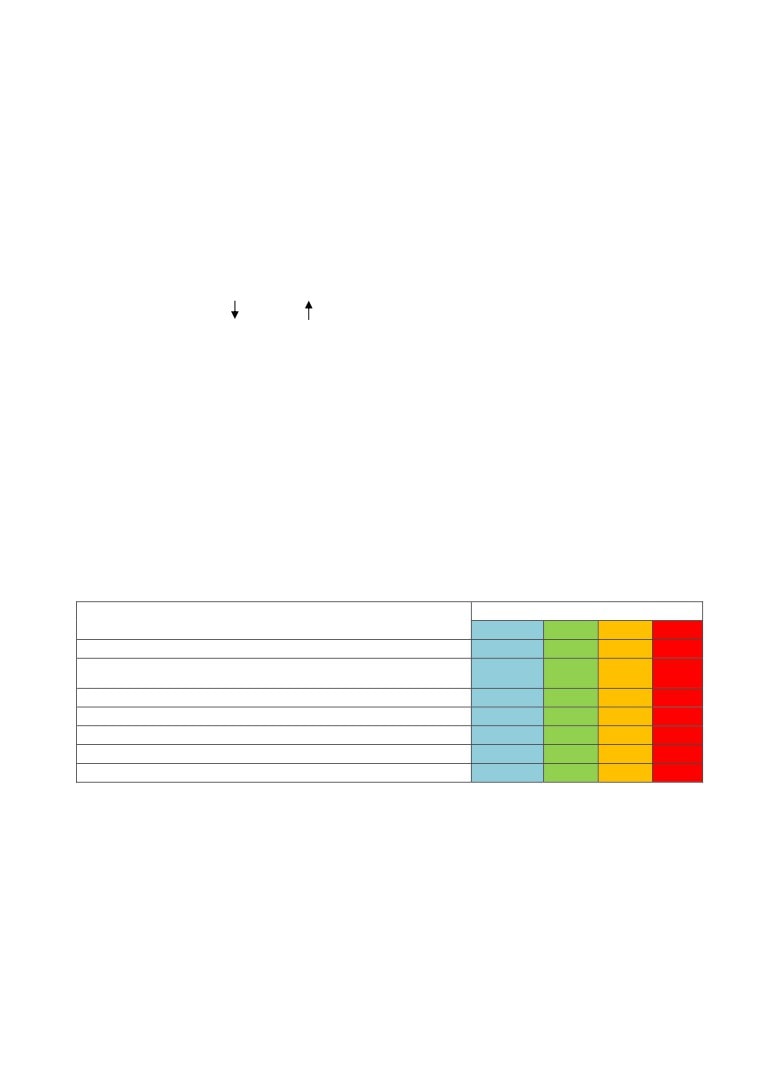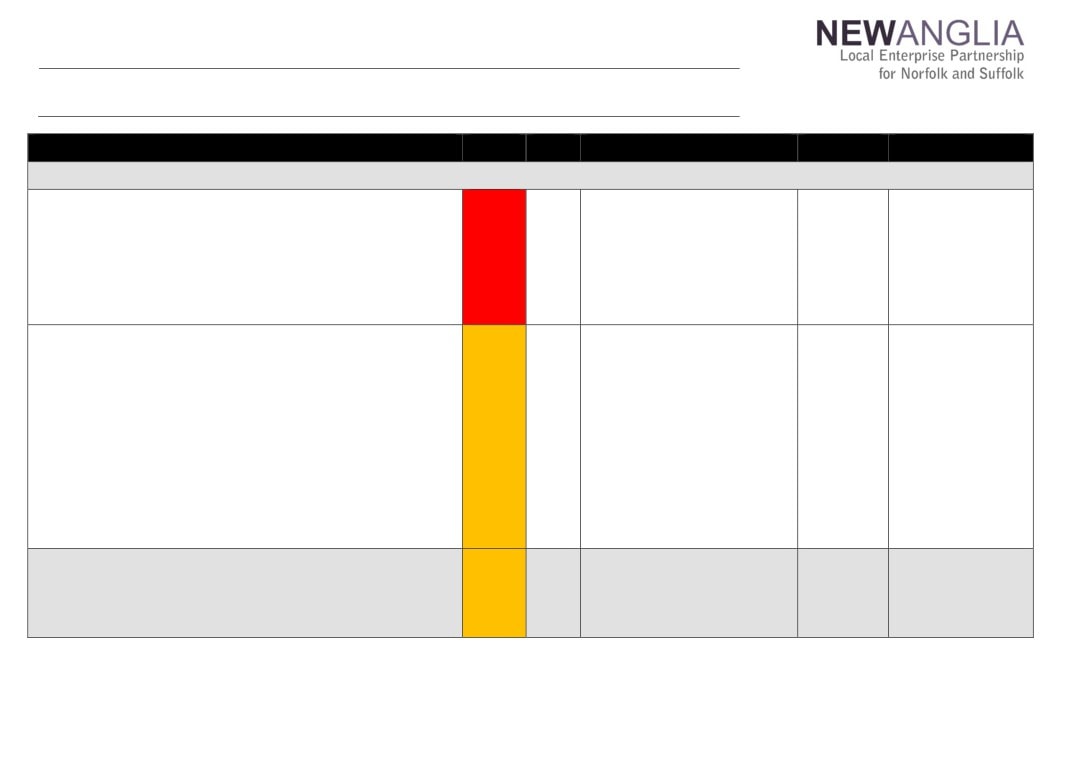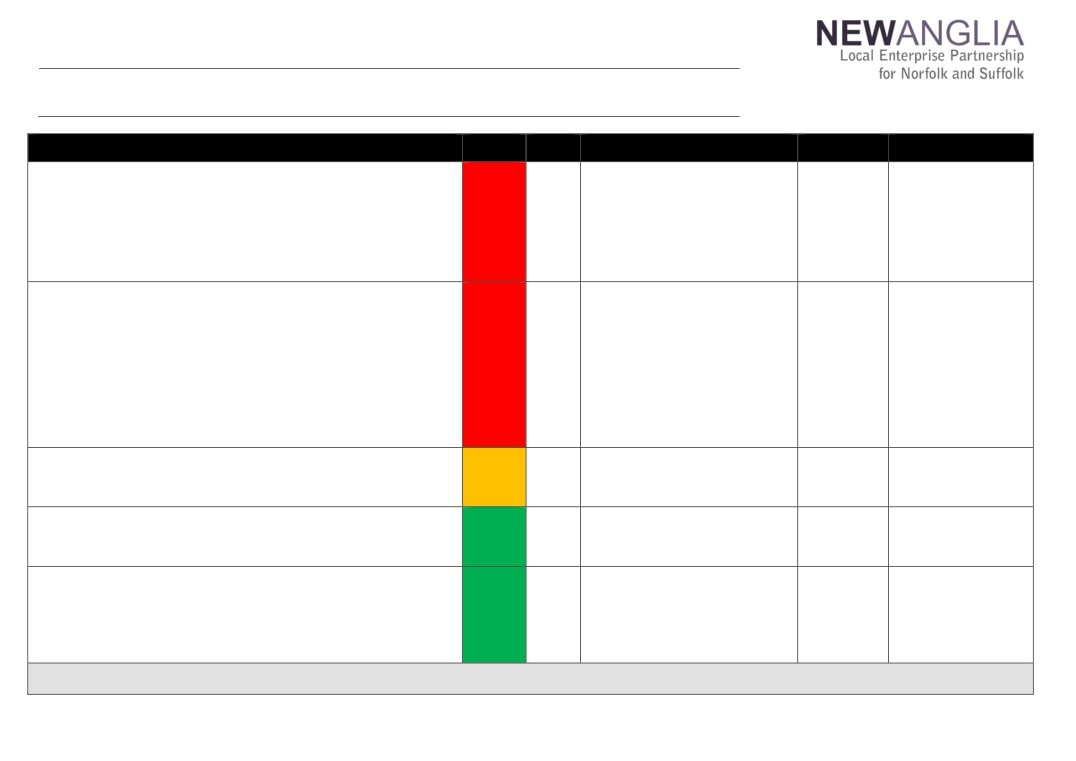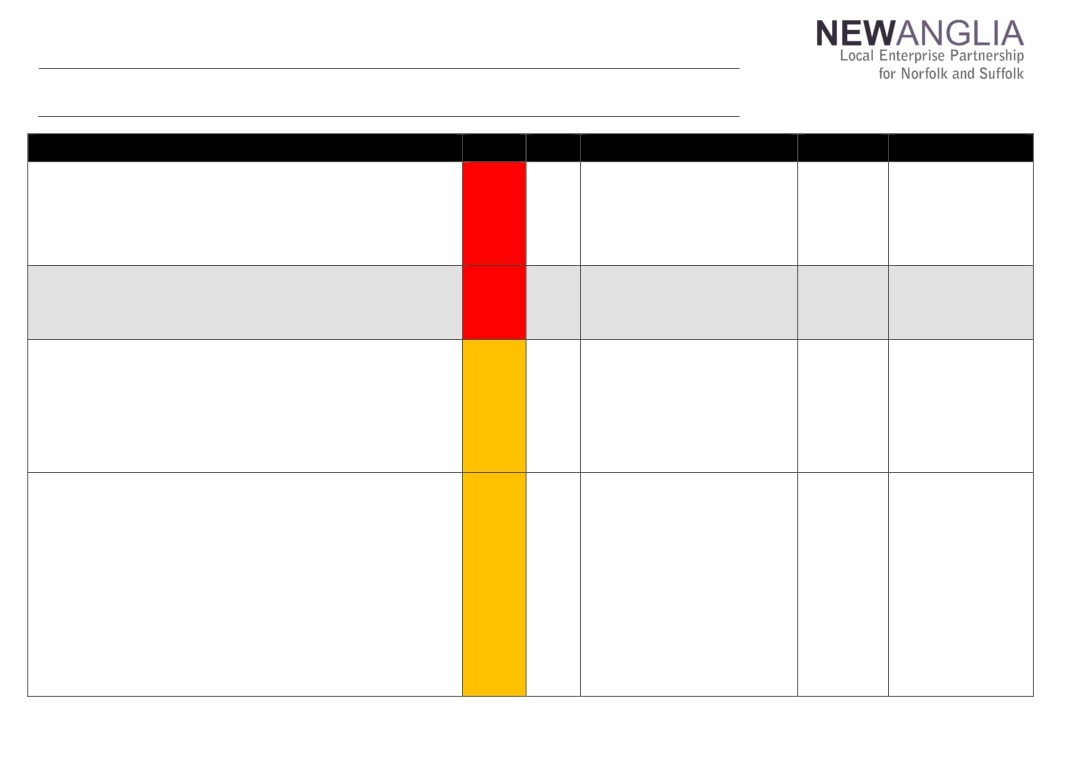New Anglia Local Enterprise Partnership Board Meeting
Wednesday 21st February 2018
10.00am to 12.30pm
Marble Hall, Surrey Street, Norwich, Norfolk
Agenda
No.
Item
Duration
1.
Welcome
20 mins
2.
Apologies
3.
Declarations of Interest
4.
Welcome from Lindsey Rix
5.
Actions / Minutes from the last meeting
Forward looking
60 mins
6.
Brexit Analysis
For Discussion
7.
Economic Indicator Trajectories and Targets
For Discussion
Governance and delivery
70 mins
8.
Governance Review
For Approval
9.
24 Month Operation Plan Review
Update
10.
New Anglia LEP ERDF Bid
For Approval
11.
Sub-National Transport Forum
For Approval
Chief Executive’s report
12.
Update
including PwC and Mary Ney Review Implementation Plan
13.
Finance Report including Confidential Appendices
Update
14.
Any Other Business
Date and time of next meeting: 21st March 2018. 10am-12.30pm
Venue: The Jockey Club, Newmarket, Suffolk
1
New Anglia Board Meeting Minutes (Unconfirmed)
17th January 2018
Present:
Cllr David Ellesmere (DE)
Ipswich Borough Council
Doug Field (DF)
East of England Coop
Cllr John Griffiths (JG)
St Edmundsbury Borough Council
Cllr Cliff Jordan (CJ)
Norfolk County Council
Dominic Keen (DK)
High Growth Robotics
Steve Oliver (SO)
MLM Group
Cllr Andrew Proctor (AP)
Broadland District Council
Prof David Richardson (DR)
UEA
Lindsey Rix (LR)
Aviva
Sandy Ruddock (SR)
Scarlett & Mustard
Dr Nikos Savvas (NS)
West Suffolk College
Cllr Alan Waters
Norwich City Council
Jeanette Wheeler (JW)
Birketts
Tim Whitley (TW)
BT
In Attendance:
Cllr Richard Smith (RS)
Suffolk County Council (For Colin Noble)
Shan Lloyd (SL)
BEIS
Chris Dashper (CD)
New Anglia LEP
Iain Dunnett (ID)
New Anglia LEP
Chris Starkie (CS)
New Anglia LEP
Helen Wilton (HW)
New Anglia LEP
Tracey Jessop (TJ)
Norfolk County Council
Sue Roper (SuR)
Suffolk County Council
Johnathan Reynolds (JR)
Orbis (For Item 4)
Page 1 of 6
3
Actions from the meeting: (17.01.18)
Capital Growth Programme Projects
Identify whether other LEPS have received requests for investment in flood defence schemes.
CD
Chief Executive’s Report
For CS to produce a paper on the impact of GCGP changes
CS
1
Welcome from the Chairman
Doug Field (DF) welcomed everyone to the meeting and thanked Jonathan Reynolds and Orbis for
hosting the meeting. He welcomed Richard Smith who is deputising for Colin Noble.
2
Apologies
Apologies were received from:
Cllr Colin Noble
3
Declarations of Interest
The board were reminded that declarations of interest are required as part of LEP scrutiny and must be
submitted to the LEP office at the earliest convenience.
Declarations relevant to this meeting:
Item 7: Capital Growth Programme Projects
Projects for Approval
David Richardson and Steve Oliver
Projects for Deferral
Nikos Savvas, Richard Smith, Cliff Jordan, Sue Roper and Tracy Jessop
Projects for Rejection
David Richardson, Richard Smith, Cliff Jordan, Sue Roper and Tracy Jessop
Item 9: Integrated Health and Employment Service Proposal
Cliff Jordan & Tracy Jessop
Item 10:Growing Places Fund investment The Malthouse
David Ellesmere and Steve Oliver
Item 11: New Anglia Capital
Doug Field declared an interest in the investments in MBASO and Novofarina
Chris Starkie (CS) reminded Board members that the new Declaration of Interest form supplied by
Government needed to be completed and returned by the next Board meeting on 21st February as it must
be published on the LEP web site by 28th February in order for the LEP to remain compliant.
In the future any declarations made at the Board meetings will be transposed onto Board member’s forms
as well as recorded in the minutes. Any changes identified between Board meetings should be advised
to Charley Purves and forms will be updated accordingly.
Lindsey Rix (LR) asked about the process should a Board member participate in the investment approval
process and subsequently became involved in the contract. CS advised that the LEP should be notified
at the earliest opportunity either directly to the Office Manager or at the next Board Meeting and the
relevant Declaration of Interest form would be updated accordingly.
4
Welcome from Orbis Energy
Johnathan Reynolds welcomed Board members to Orbis Energy and provided an overview of
the organisation covering the range of work carried out, its achievements over the past 9 years
and provided examples of some of the programmes in which it has been involved. The
presentation included details of the importance of the UK and the East in the world renewable
energy market. Johnathan then left the meeting.
5
Minutes of the last meeting 22nd November 2018
Actions from last meeting updated as follows:
LEP Governance Review
Page 2 of 6
4
To express preferences over committee roles to LiR by 1st December - Complete - a table of
ALL
proposed committee members will be circulated prior to next Board.
Business Investment Proposal - Confidential
NK
To receive more detail on the skills spending within the proposal - details are available at the
meeting or on request.
May Ney Review Including Standards of Conduct
HM
To receive details of where the policies can be accessed - complete
Board Forward Plan
ALL
To provide feedback on the plan and propose any additional items - complete
Business Performance Reports
To receive a proposal on the Eastern Agi-Tech initiative by email - On hold due to the winding
CS
up of GCGP and awaiting clarification about their financial position.
6
Aims and Objectives for the Year
Chris Starkie (CS) provided a presentation on the strategic aims and objectives for the LEP for
2018.
Board members discussed the importance of promoting the East as a brand and Dominic Keen
(DK) felt that more could be done to champion local business success stories.
David Ellesmere (DE) asked how New Anglia compared to other high performing LEPs and
whether it was proactively looking to identify best practise elsewhere. CS confirmed that New
Anglia was actively involved in the LEP network and was also increasing its involvement in
ADEPT.
Sandy Ruddock (SR) noted that the region had many micro and start-up businesses who would
benefit from support from the LEP which needed to be promoted as the go-to organisation for
small businesses.
DF asked CS what he viewed as the 3 key aims to be achieved in the next 12 months. CS
stated that he wanted the Board to have confidence in the LEP’s internal processes, to
continue to promote local business successes and to have secured a local industrial strategy.
Steve Oliver (SO) asked that the LEP’s aims include social mobility and social inclusion.
The Board agreed:
To note the content of the presentation
7
Capital Growth Programme Projects
DF proposed breaking this item into the various bid groupings namely those which were
proposed to be approved, deferred or rejected. It was agreed that meeting attendees would
register their interest in each group individually.
Chris Dashper (CD) took the majority of the paper as read and reviewed the key points of the
proposal.
He explained that the projects had also been considered by the Investment Appraisal
Committee.
Approved Projects
David Richardson (DR) and SO declared an interest in this item and left the room
CD proposed that the Board approve the award of Growth Deal grant funding to the Bacton to
Walcott Coastal Management Scheme and to the Cefas Research Centre.
This was approved by the Board
DR & SO returned to the room.
Deferred Projects
Nikos Savvas (NS), Richard Smith (RS), Cliff Jordan (CJ), Sue Roper (SuR), Tracy Jessop (TJ)
declared an interest in this item and left the room.
CD advised that further work would be carried out on these projects and some would be
included in a later round of funding as appropriate.
LR noted that the Board should have a holistic view of future projects in order to properly
assess which were the best projects in which to invest the limited funds available so that
investments were not solely made in those projects presented first.
Page 3 of 6
5
The meeting discussed the issue of whether flood defences should be funded locally or
nationally. SR asked if other LEPs had received requests to fund similar projects.
CD asked for approval to defer the projects as listed. This was agreed by the meeting.
Rejected Projects
DR declared an interest in this item and left the room. NS returned to the room.
RS, CJ, SuR and TJ also declared an interest in this item and therefore remained outside the
room.
CD reviewed the list of rejected projects detailing the rationale behind the decisions.
SO asked whether any could be referred to New Anglia Capital. CD advised that Liquid 11
could possibly apply for New Anglia Capital but would be more suitable for Growing Business
Fund.
CD asked for approval to reject the projects as listed. This was agreed by the meeting.
DR, RS, CJ, SuR and TJ returned to the meeting.
The Board agreed:
To note the contents of the report
To approve the award of Growth Deal grant funding to the following projects in table 1:
Bacton to Walcott Coastal Management Scheme
Cefas Research Centre
To approve the recommended decision option for each of the projects in tables 1, 2 and
3. (Table 2: Recommended to defer and Table 3: Recommended to reject)
CD to Identify whether other LEPS have received requests for investment in flood
CD
defence schemes.
8
New Anglia Voluntary Community Sector Programme Extension
Iain Dunnett (ID) took the majority of the paper as read and reviewed the key points of the
paper including the history of the fund and its achievements to date.
DE expressed his support highlighting the importance of multi-year grants for organisations in
order to assure future funding. He noted that this should be based on performance over a 1
year deal rather than the size of the organisation.
DE also queried how performance was rated proposing using the length of unemployment prior
to entering employment as one criteria.
ID advised that the criteria would be reviewed as part of the re-scoping of the fund.
The meetings agreed to the proposal.
NS and SO offered to sit on the Funds Appraisal Panel.
The Board agreed:
To note the content of the proposal
To agree the re-scoping of the criteria for the fund as described in the paper.
To agree that the LEP makes the further commitment of a £250,000 grant from the
Growing Places Fund for 2018/19 and to agree to review further commitments for two
years beyond 2018 at an appropriate stage.
To agree that NS and SO would sit on the Funds Appraisal Panel.
9
Integrated Health and Employment Service Proposal
CJ & TJ declared an interest in this item and left the room.
Iain Dunnett (ID) took the majority of the paper as read and reviewed the key points of the
paper.
RS expressed support for the project noting that there was a similar scheme in Suffolk and CD
confirmed that the LEP were already in discussion with them.
CS proposed that the funding be agreed subject to the funding being matched as detailed in
the proposal.
The meeting discussed the benefits of the project.
Page 4 of 6
6
The Board agreed:
To note the content of the proposal
To support the overall purpose of the proposal against the key LEP objectives of
employability and skills.
To provide matching finance at a rate of £120k per annum for three years to the project
to assist in leveraging over £2million of European Social Funds (ESF). This is
dependent on other matched funding being secured.
10
Growing Places Fund investment The Malthouse - Confidential
DE & SO declared an interest in this item and left the room.
ID took the majority of the paper as read and highlighted the key points of the proposal. He
explained that the LEPs Investment Appraisal Committee have reviewed an initial appraisal
and a full appraisal of the development, including an externally completed assessment of the
loan application. These reviews included an assessment of the development for strategic fit
from an economic perspective and the financial aspects.
LR noted that if the further £900k is raised from another party then the point of the LEP having
first charge would be renegotiated at the Investment Appraisal Committee.
DF noted that a discussion was required at a future date as to how the board balances fairness
& transparency in similar investments.
The Board agreed:
To note the content of the proposal.
To approve a recommendation made by the LEPs Investment Appraisal Committee that
an offer of a £600,000 loan is made to the current owner of the Ipswich Malthouse for its
redevelopment into bespoke business units.
11
New Anglia Capital
DF declared an interest in the investments MBASO and Novofarina and took no further part in
the discussion.
CD advised the meeting that this was the bi-annual report as requested by the Board and took
the majority of the paper as read and asked the Board for questions.
The Board reviewed the approach to risk with DE noting that some investments will naturally
fail but that the portfolio should be assessed as a whole.
CS noted that the jobs created by NAC were generally high value jobs with a lower cost per job
than that in the Growing Business Fund.
The Board agreed:
To note the content of the report.
12
Chief Executive’s report including PwC and Mary Ney Review Implementation Plan
CS took the majority of the paper as read and provided an update on the following items:
Mary Ney Review - CS noted that the Board is compliant with the Mary Ney recommendations
on the issuing and publication of papers and minutes however this process is still being rolled
out to the relevant sub-committees. This will be achieved by 28th February 2018.
Government Dashboard - The proposed dashboard was circulated to attendees. CS
requested approval for the dashboard and asked whether the Board wanted to see the report
on a regular basis. Board agreed to the Dashboard and confirmed that there was no
requirement to include it in Board papers. Improvements to Board reporting are being
progressed in line with the timeframes included in the PwC report.
Unilever - The meeting discussed the current situation. Jeanette Wheeler (JW) noted that the
recent press stories had provided a negative view of the state of investment in the region and
Page 5 of 6
7
that more positive promotion was required. CS agreed noting that the LEP had to balance
sensitivity to job losses and the promotion of other investments.
COO Recruitment - short listing has begun with first interviews scheduled to take place before
the end of January.
CGCP - CS reviewed the issues raised by the changes to GCGP including the impact of
possible changes to the boarders of the LEPS. CS offered to produce a paper on the subject
detailing known facts and potential impacts. JW requested details of the impact of changes on
LEP programmes and investments.
The Board agreed:
To note the content of the report
To endorse the Dashboard
For CS to produce a paper on the impact of GCGP changes
CS
13
Finance Report
CS took the majority of the papers as read and asked for questions from the Board.
The Board agreed:
To note the content of the report.
14
Appointment of New Director
Andrew Proctor (AP) & LR met to interview two candidates and proposed Jonathan Reynolds
as the new board member.
The Board agreed:
To approve the appointment
16
Any Other Business
It was agreed that Item 16 would be completed prior to Item 15 given the latter’s confidential
nature.
Tim Whitley (TW) advised that Adastral Park is hosting the Innovate UK Conference on 27th
January to which Board Members were invited.
TJ updated the meeting on the position with Carillion advising that the Council had been in
discussion with Highways England and received confirmation that contingency plans were in
place and no projects in the East would be impacted by the collapse.
NS advised that on 16th April East of England Education providers would be hosting a
promotional event and requested promotion from the LEP.
15
Remuneration Committee - Confidential
Non Board Members left the meeting.
The confidential minutes of the Remuneration committee were presented by DF. The minutes
contained a salary recommendation for the Chief Executive Officer (CEO) and a salary banding
for the Chief Operating Officer (COO). There was also details of the performance management
process for the CEO.
The Board agreed:
To note the content of the minutes for the Remuneration Committee
To agree the recommendations made by the Remuneration Committee
Next meeting:
Date and time of next meeting: 21st February, 2018. 10am-12.30pm
Venue: The Marble Hall, Surry Street, Norwich, NR1 3NG
Page 6 of 6
8
Actions from New Anglia LEP Board Meetings
Date
Item
Action
Update
Actioned By
Status
17/01/2018
Capital Growth Programme
Identify whether other LEPS have received requests for investment in flood
CD
On-Going
Projects
defence schemes.
17/01/2018
Chief Executive’s Report
For CS to produce a paper on the impact of GCGP changes
CS
Completed
22/11/2017
Business Performance
To receive a proposal on the Eastern Agi-Tech initiative by email.
On hold pending clarification on the situation at
CS
On Hold
Reports
GCGP
25/10/2017
Implementing the Economic
To be advised of the retention rate of jobs created through the VCS Challenge
NCF provided three case studies of projects
ID
Completed
Strategy
Fund
supported by the VCSE Challenge Fund with figures
for job creation and retention. Across the Access to
Community Trust, Pro Corda and Museum of EA
Life a total of 21 people have found employment
and have been retained in those jobs.
25/10/2017
Implementing the Economic
Investigate whether any Co-Ops have applied for the VCS Challenge Fund
The number of Coops/ social enterprises supported
CD/ID
Completed
Strategy
by the Vcse fund was 6
20/09/2017
Business Performance
To receive a future report on the approach to NAC investments
Included in the January half-yearly update
CD
Completed
Reports
9
New Anglia Local Enterprise Partnership Board
Wednesday 21st February 2018
Agenda Item 6
Brexit Analysis for Norfolk and Suffolk
Author: Alexander Riley / Lisa Roberts
Summary
This paper provides a summary of the report that has been produced by Metro Dynamics on
the potential impacts of Brexit for Norfolk and Suffolk.
Patrick White from Metro Dynamics is attending the Board meeting and will present the
conclusions of the research and draw out some of the most important findings by sector.
The report also highlights measures the LEP and partners are taking to minimise the
challenges and maximize the opportunities of Brexit.
Recommendation
The board is asked to:
Support the recommendations in the report
Support the activities the LEP is undertaking to mitigate the challenges and take
advantage of the opportunities of Brexit and identify additional activities or areas of
focus
Background
The LEP, Norfolk County Council and Suffolk County Council commissioned consultants Metro
Dynamics to assess the potential impact of Brexit on the region’s economy, focusing on the
potential challenges and opportunities across different economic sectors and identifying
individual companies that might be significantly affected.
The attached report has been developed as a result of this work and this paper provides a high-
level summary of the key points.
Main Report
The report presents a detailed analysis of the potential impacts of Brexit on six sectors that are
particularly exposed to Brexit in Norfolk and Suffolk - Agriculture, Manufacturing, Construction,
Offshore wind energy, Digital and Life Sciences.
The report considers the impact of Brexit specifically on the workforce, trade, regulations and
funding for each of these sectors.
It also poses a set of challenges and opportunities for Norfolk and Suffolk in relation to Brexit,
identifying a key role for the LEP and partners in supporting local businesses and institutions to
secure the skills and funding needed to grow, internationalise and innovate - in line with the
Government’s Industrial Strategy.
1
11
The report also proposes that the LEP, as well as local authorities, should be more proactive in
engaging with businesses pre and post-Brexit to ensure that they are well-placed to address
any future challenges.
It concludes with a set of policy recommendations to help inform the LEP and local authorities
on the strategic approach that they might take in the period ahead.
Key recommendations of the report include:
Develop a local industrial strategy to further reinforce the sectoral specialisms that
Norfolk and Suffolk have, and to ensure that central Government is fully aware of the
contribution that those specialisations make to the national economy.
Review and focus the LEP’s Growth Hub, Innovation Hubs and skills deal activity to
more proactively reach out to those businesses which could have opportunities for
growth and/or be more challenged by Brexit.
Focus and strengthen place marketing and inward investment in order to reach out to
the people that need to be attracted and retained as well as the investment needed to
drive productivity.
Attract large scale private sector investment in infrastructure and development, requiring
places to further focus their investment marketing activity and develop a very strong
place based story and proposition.
Collaborate with other regions and sectors elsewhere where there is a common interest
in reaching out to new markets or designing new products.
New Anglia LEP Activity
In order to respond to the recommendations, the LEP executive has developed an initial eight
point Brexit action plan outlining our approach to taking forward the recommendations in the
report, in line with the implementation of our Economic Strategy.
1.
Local Industrial Strategy. The LEP will use the opportunity to develop a Local
Industrial Strategy to reinforce the sectoral specialisms of Norfolk and Suffolk, building
on the work of the Science and Innovation Audit and wider evidence base. We are
actively pursuing the opportunity with Government to be a pilot area.
2.
Developing our sector and innovation strengths. As part of this process we are
working with the national Knowledge Transfer Network and Smart Specialisation Hub to
improve the way innovation and sectoral specialisms are mapped nationally. The
limitations of the data that is used means strengths within Norfolk and Suffolk sectors
are not recognised nationally. We are also working with them on developing a cluster
evidence pack which will support our cluster development. We will pilot this with the
view for it to be scaled up across the UK. This will place us is a good position to respond
to the Industrial Strategy Strengths in Places fund when it is launched later this year.
3.
Driving Inward Investment and place marketing. The LEP is leading on the
development of a shared inward investment strategy which is due to be presented to the
LEP Board in May. This strategy will aim to enable integrated inward investment and
business location offer and will include activity around building a stronger place offer
and proposition to help attract new infrastructure investment and non-EU Foreign Direct
Investment.
4.
Gathering intelligence. James Allen joins the LEP Executive team later this month
from the CBI. His role includes building business intelligence which includes working
with local partners on impacts of Brexit on businesses. This intelligence is regularly fed
into Government.
5.
Championing local business. The LEP is developing a range of case studies which
championing local "trail-blazers" and actively promote them through national, regional
and local opportunities. These will be presented in a range of ways including videos,
blogs, leaflets and report interviews.
2
12
6. Improved targeting of support. The new Business Growth Programme is being
refined to better align with the new Economic Strategy and enabling the LEP’s Growth
Hub to focus on more complex problems such as the challenges posed by rule changes
caused by Brexit and skills shortages and also concentrate on higher growth
businesses.
7. Supporting exporters. The LEP working with the Growth Hub, Chambers and
Department of International Trade are exploring how collectively we can enhance the
international trade service for our businesses which have the greatest potential for
overseas trade.
8. Collaborating with other parts of the UK. The LEP is actively looking at ways to help
identify opportunities to collaborate with other parts of the country where there are
common interest or complementary strengths which will open opportunities to new
markets and new products. Examples include the Local Energy East Strategy and
Energy Hub and Nuclear Sector Deal.
Recommendation
The Board is asked to:
Support the recommendations in the attached report
Support the activities the LEP is undertaking to mitigate the challenges and take
advantage of the opportunities of Brexit and identify additional activities or areas of
focus
3
13
The potential implications of
Brexit for Norfolk and Suffolk
Threats and opportunities of Brexit for key economic
sectors
November 2017
15
Contents
1. Introduction
2
2. Sectoral impacts of Brexit on Norfolk and Suffolk
4
Agriculture
4
Manufacturing
8
Construction
12
Offshore wind energy
15
Digital
19
Life sciences
23
3. Concluding remarks
26
4. Policy recommendations
28
References
29
16
1. Introduction
Introduction
The councils of Norfolk and Suffolk, together with New Anglia LEP, have
▪ Trade - including future arrangements after the expected departure of the UK
commissioned Metro Dynamics to assess the potential impact of Brexit on the
from the European Single Market.
region’s economy, focusing on the potential challenges and opportunities across
▪ Regulations - in regards to the many EU directives incorporated into UK law.
different economic sectors and identifying individual companies that might be
significantly affected.
▪ Funding and Investment - including the role of European funds and subsidies
and the capacity to continue to attract foreign private investment.
This report presents the findings of a detailed analysis of the potential impacts of
Brexit on six economic sectors that are particularly exposed to Brexit in Norfolk and
Our approach has been to identify local economic strengths, based on an analysis of
Suffolk, as agreed with the Steering Group. It is part of a broader research process,
Norfolk and Suffolk’s employment patterns and companies, to sit alongside analysis
undertaken over several stages and in close consultation with our clients. This
of the sectoral impacts of Brexit, which are often reflective of national trends.
process is illustrated in the diagram on the next page.
Although considerable uncertainty remains on the specific outcomes of Brexit, this
Following a background analysis of the key economic and policy implications of
report identified a set of challenges and opportunities for Norfolk and Suffolk,
Brexit at the national level based on recent studies and the Government’s position,
including:
we produced a high-level assessment of potential impacts in Norfolk and Suffolk on
▪ Retaining the current EU workforce, both low and highly skilled, who are key to
19 different sectors. These were drawn from the strategic sectors identified in the
the future success of some of Norfolk and Suffolk most important sectors, such as
Norfolk and Suffolk Strategy and other prominent sectors in the Norfolk and Suffolk
agriculture, manufacturing, construction and life sciences.
economy. Building on the findings of this work, we agreed with the Steering Group a
set of six sectors for a more detailed analysis: Agriculture, Manufacturing,
▪ New opportunities to uplift the economy, using innovation and technology to
Construction, Offshore wind energy, Digital and Life sciences. The analysis was
upskill the workforce and create better paid jobs.
complemented by research into significant Norfolk and Suffolk companies operating
in these sectors.
▪ The need for companies to adjust to new trade arrangements and potential tariffs
and other barriers, while using the opportunity to increase the UK share of their
Naturally, the impact of Brexit is not limited to the chosen sectors. As such, the final
supply chains and open their products to new markets worldwide.
six sectors and the extent to which they were aggregated (for instance by choosing
to focus on Offshore wind rather than the wide energy sector more broadly), were
▪ The importance of ensuring continued funding for research and development and
selected on the basis of: (1) their particular significance to the Norfolk and Suffolk
innovation, as well as alternative sources of funding for agriculture and farming
economy (both in terms of employment and value added); (2) the likelihood of their
businesses that often rely on EU subsidies.
being highly impacted by Brexit; and (3) their strategic importance to Norfolk and
▪ The need to continue to be attractive to foreign investment.
Suffolk. This was determined in consultation with the Steering Group.
The LEP could have a key role in this process, supporting local businesses and
The analysis presented here focuses on these six sectors and considers potential
institutions in securing the necessary skills and funding to continue to grow,
challenges and opportunities brought about by the impact of Brexit on:
internationalise and innovate, in line with the National Industrial Strategy.
▪ Workforce - including the EU labour force and the potential impacts of Brexit on
immigration patterns.
17
1. Introduction
The purpose of this project
Identify the impacts of Brexit on Norfolk and Suffolk’s economic sectors and businesses
Assessment of the key
economic and policy
implications of Brexit
Norfolk and Suffolk
Economic Strategy
Strong and strategic
evidence base
sectors
High-level analysis of Brexit
impacts on 19 Norfolk and
Suffolk’s strategic and strong
sectors
Input from
Select key impact sectors
Steering Group
Detailed analysis of 6 high-
This report
impact economic sectors
Companies
database
Identifying the business
base
18
2. Sectoral impacts of Brexit in Norfolk and Suffolk
Agriculture
Table 1: Crop hectarage in East of England as a percentage
Agriculture is a crucial sector in the economy of Norfolk and Suffolk. The region is not only strong in
of total hectarage in England (2016)
in crop farming and animal production, but also in the strong supply chains these agricultural
sectors provide to other local sectors of specialism, particularly manufacturing of food, beverages
East of England: percentage
and machinery.
Crop
of total national hectarage
The last official data shows that 16,160 Norfolk and Suffolk residents work in Agriculture, forestry
Wheat
28.0
and fishing, which amounts to 2.2% of the region’s workforce, a much higher share than the 0.8%
in England (ONS, 2011). Even when farm agriculture activities are excluded, Agriculture, forestry
Barley
21.4
and fishing composes 2.8% of the GVA produced in Norfolk and Suffolk, compared to a figure of
0.7% for the whole of England excluding London (ONS, 2015). Important sub-sectors for Norfolk
Oilseed rape
24.7
and Suffolk include the production of sugar, malt, poultry and pork, and potatoes.
For the broader East of England region, the Department for Environment, Food and Rural Affairs
Sugar beet
65.6
estimates a total of 40,698 jobs in agriculture, including short-term and seasonal workers. This
region accounts for 13.4% of farming jobs in England, and, as Table 1 shows, sugar beet and
Potatoes
32.3
potatoes are the of two most significant crops. In fact, the East of England grows 32.3% of
England’s total potato crop and 65.6% of England’s sugar beet crop (Defra, 2017).
Field grown vegetables
28.8
Sugar beet production is particularly important in Norfolk and Suffolk as the LEP area is home to
three of the largest sugar manufacturing facilities in the UK: Wissington, Bury St. Edmunds and
Cantley. According to British Sugar (2017), these facilities employ 335, 230 and 180 workers
respectively and together make use of over 1,900 suppliers growing sugar beet across the wider
Table 2: Large Agriculture companies in Norfolk and
region.
Suffolk (examples)
Company
Location
Growing cereals for the production of malt is also significant in Norfolk and Suffolk, due to the
area’s favourable growing conditions (NFU, 2016b) and links to the regional specialisation in
Cofco International UK
The Havens, Ipswich
beverage manufacturing. Furthermore, East Anglia has the second largest number of pigs in
Hutchinson Group
Hunstanton
England.
Banham Group
Attleborough
In Agriculture, forestry and fishing, 10% of workers in the UK are EU nationals (36,000) according
Heathpatch
Semer, Ipswich,
to data from the Annual Population Survey (ONS, 2017). It is important to note that the sample
used in this survey does not account for short-term or seasonal workers.
Traditional Norfolk Poultry
Shropham, Attleborough
Lawson Partners
Stadbroke
H.G. Gladwell & Sons
Copdock, Ipswich
19
2. Sectoral impacts of Brexit in Norfolk and Suffolk
Brexit impact on Agriculture
Trade
Regulations
The agricultural sector is likely to be significantly impacted by Brexit, as it is highly
EU rules regarding marketing standards and product safety apply for products sold
reliant on trade with EU countries. In 2016, 73.3% of UK exports of agricultural
on the EU market, even for non-EU imports, so continued adherence to these is
products were to the EU (ONS, 2017). According to the CBI (2016), this is likely to
essential (NFU, 2016a). Regulatory stability and certainty will be necessary to ease
continue due to the difficulty of transporting perishable goods, which would impede
trade in agricultural products (CBI, 2016).
trade further afield.
However, changes to EU regulations may bring positives by allowing the UK to
Given this dependence, UK agricultural exports would be particularly vulnerable to
establish its own domestic regulatory policy (ibid.). For example, in an article by the
the introduction of trade barriers such as tariffs. On average, tariffs are 36% on
Managing Director of British Sugar, Paul Kenwood (2017) writes that Brexit provides
dairy products, 20% on animal products and 10% for fruit and vegetables. This
the chance to design a sugar policy which benefits the UK’s domestic industry. The
would reduce competitiveness vis-a-vis EU countries. As the agricultural sector in
EU-imposed quota system has previously controlled the quantity of sugar produced in
Norfolk and Suffolk is intrinsically linked to other sectors, most notably food and
and sold by the UK (British Sugar, 2017), so that, for instance, when there was a
drink manufacturing, trade barriers to agricultural products could have deleterious
surplus crop in 2015, it could not be sold on the UK, EU or world markets (Kenwood,
effects on interconnected sectors (CBI, 2016).
2017). In October 2017, this quota system will be revoked (British Sugar Beet
Review, 2017).
To mitigate this, Paul Kenwood (2017), the Managing Director of British Sugar, has
stated that he would wish for any tariffs which act as barriers to trade with Ireland,
In the case of regulatory changes to the wider agricultural sector, new policies will
France and Italy to be matched by reciprocal tariffs to protect the thriving British
need to ensure that favourable access between the UK and EU markets is
sugar beet industry.
maintained.
Despite the relative dependency of the UK agricultural system on the EU, the
sector could become more open looking. Brexit offers the UK the opportunity to
expand its exports globally. This optimism is shared by British Sugar (2017),
particularly given the removal of the quota system, as will be discussed in the
following section.
20
2. Sectoral impacts of Brexit in Norfolk and Suffolk
Brexit impact on Agriculture
Workforce
Funding and investment
A restriction on the free movement of people in the EU is highly likely to affect the
The main source of funding for the agricultural sector comes from the Common
agricultural sector in Norfolk and Suffolk.
Agricultural Policy (CAP), which has become central to the agricultural sector in the
UK. The aim of CAP is to address the failure of agricultural markets in delivering fair
Agriculture is a labour-intensive sector which is reliant upon both full-time and
incomes to farmers by helping farmers deal with market volatility and to buffer them
seasonal EU labour. Between April 2016 and March 2017, 10% of the workforce
against shocks.
(36,000 people) were non-UK EU nationals (ONS, 2017). This figure is unlikely to
In 2015 alone, farmers in the UK received €3.084 billion in direct payments (NFU,
account for temporary and seasonal workers, as it is from the Annual Population
2016a). On average, these payments contribute 55% of the total income from farming
Survey, which uses a sample of UK residents.
(CBI, 2016). CAP payments enable farmers to meet the higher cost associated with
higher welfare and environmental standards, without which many farms would be
UK agriculture’s reliance on seasonal EU labour derives from many farms’ inability
unable to survive (NFU, 2016a).
to recruit sufficient domestic workers (NFU, 2016a). According to the National
Farmer’s Union Deputy President Minette Batters, “…80,000 seasonal workers
Alongside CAP subsidies, the UK was allocated €5.2 billion for rural development
plant, pick, grade and pack over nine million tonnes and 300 types of fruit,
projects between 2014 and 2020 (NFU, 2016a). These funds are used to support
vegetable and flower crops in Britain every year” (NFU, 2017). This underlines the
increased farm productivity, micro/small enterprises and farm diversification, rural
extent to which the official estimate of 36,000 EU workers diverges from the
tourism, rural services, cultural and heritage activities, and forestry productivity, and
will no longer be available after the current funding round ends in 2020.
number of seasonal workers in reality.
This reliance on EU labour applies to Norfolk and Suffolk. Across the region,
thousands of Eastern European workers pick fruit, vegetables and salads. A
supply of both seasonal and permanent workers is similarly important to poultry
and pig farming (NFU, 2017).
Without access to a ready supply of relatively cheap EU labour and absent desire
among UK nationals for agricultural work, farms may find it difficult to locate
sufficient work for the season. Labour shortages may reduce the production and
growth of UK farms, necessitating increased imports and price rises (Smithson Hill,
2017).
21
2. Sectoral impacts of Brexit in Norfolk and Suffolk
Table 3: Top Manufacturing sub-sectors in employment
(Norfolk and Suffolk, 2015)
Manufacturing
Main SIC-2 sub-sectors
Number of jobs
Food products
13,681
Norfolk and Suffolk has a wide and diverse manufacturing sector employing over 61,000 workers.
Fabricated metal products
6,820
Manufacture of food products is by far the largest sub-sector, employing 13,681 people. Half of
these jobs are concentrated in production and processing of poultry meat (detailed analysis on
Machinery and equipment
6,452
page 9), an area of high employment growth and specialization in Norfolk and Suffolk. Firms
Rubber and plastic products
5,883
operating in the area include Bernard Matthews, Tulip and 2 Sisters Food Group. Manufacturing of
beverages is also an area of high local specialisation that employs over 2,000 people in Norfolk
Printing/reproduction of recorded media
3,122
and Suffolk. Most of these jobs are in beer manufacturing, with Adnams based in Southwold and
Motor vehicles
2,833
Greene King in St Edmundsbury. In addition, Aspalls, based in Mid Suffolk, drives local strength in
the production of cider, Muntons, a major malt exporter, is based in Stowmarket, and Britvic,
Chemicals and chemical products
2,707
located in Norwich, is an important soft drinks manufacturer. Other significant food products
produced in the region include prepared meals, cocoa and chocolate, condiments and animal
Furniture
2,584
feeds. Finally, the manufacture of sugar also has a large workforce in the area through the British
Wood products
2,456
Sugar manufacturing facilities in Wissington, Bury St. Edmunds and Cantley.
Beverages
2,272
Other important sub-sectors in terms of employment include the manufacture of fabricated metal
products, machinery and equipment, and rubber and plastic products - all with more than 5,000
Total Manufacturing
61,017
jobs in Norfolk and Suffolk. The manufacture of metal products primarily involves metal structures
for industrial use, structures and elements for the construction industry and machining. Machinery
and equipment includes non-domestic cooling and ventilation equipment and agricultural and
forestry machinery. Plastic and rubber manufacture encompasses a broad range of products,
Table 4: Large Manufacturing companies in Norfolk and
including packing goods and plastic elements for construction.
Suffolk (examples)
Other manufacturing sub-sectors with more than 2,000 jobs in Norfolk and Suffolk include the
Company
Location
printing and reproduction of recorded media, manufacture of motor vehicles (eg. Hethel
Engineering Centre), chemicals, and furniture and wood products. Finally, the manufacture of
Greene King
Bury St Edmunds
pharmaceuticals is also an important sector for Norfolk and Suffolk. Although not amongst the top
Forfarmers UK
Bury St Edmunds
manufacturing sub-sectors in terms of employment (with just below 1,000 jobs), the concentration
Baxter Healthcare
Thetford
of pharmaceutical jobs in Norfolk and Suffolk is 17% higher than in Great Britain. This sector is key
for innovation in manufacturing based on high-skilled and high-wage jobs. Pharmaceutical
Bosch Lawn And Garden
Stowmarket
companies in Norfolk and Suffolk include Baxter Healthcare, in Thetford, and Genzyme, in
Direct Table Foods
Little Saxham
Haverhill.
British Sugar
Wissington; Bury St. Ed.; Cantley
Palm Paper
King’s Lynn
Bernard Matthews
Norwich
Tulip
Stadbroke
22
2 Sister Group
Thetford
2. Sectoral impacts of Brexit in Norfolk and Suffolk
Manufacturing
Figure 1 maps the spatial distribution of manufacturing jobs in Norfolk and Suffolk.
Overall, it shows that jobs in the manufacturing sector are fairly dispersed across the
whole area of Norfolk and Suffolk. Nonetheless, the following areas have particularly
high concentrations of jobs in manufacturing:
No.
SIC-2 sub-
Figure 1: Spatial distribution of manufacturing jobs in Norfolk and Suffolk (2015)
Geographic area
jobs
sectors
Example companies
Paper and paper
Palm Paper, Cooper
King’s Lynn and
products;
Roller Bearings
1
surrounding
3,752
machinery and
Company, A T
area
equipment
Promotions
Pharmaceuticals;
Baxter Healthcare, Trox
2
Thetford
3,216
fabricated metal;
UK, Advanced Air (UK),
8
rubber and plastic
Camvac
A144 between
3
Bungay and
2,816
Food products
Cleveleys Foods
Halesworth
1
7
Silk Industries, 4 BG
4
Sudbury
2,135
Textiles
Group, Walters Holdings
Pharmaceuticals;
computer,
Genzyme, IFF, Herbert
5
Haverhill (East)
2,125
9
electronic and
Group
optical products
Chemicals and
Stowmarket
PPG Industries (UK),
6
1,417
chemical products;
2
3
(South East,)
Muntons
beverages
Between
7
Dereham and
1,324
Beverages
Broadland Wineries
Aylsham
Machinery and
equipment;
8
Fakenham
1,256
PMC Harvesters, P4
6
electrical
equipment
Hethel
Lotus, MSF
5
9
Engineering
1,185
Motor vehicles
Technologies, Multimac
4
Centre
23
2. Sectoral impacts of Brexit in Norfolk and Suffolk
Poultry and meat processing
Within food production, Norfolk and Suffolk have particular strengths in the processing and
preserving of poultry meat, and the production of meat and poultry meat products. Together,
these sectors employ nearly 8,000 people in the region. These jobs are mainly located in the
following areas:
Figure 2: Spatial distribution of poultry/meat manufacturing jobs in Norfolk and
Number of
Geographic area
Example companies
jobs (2015)
Suffolk (2015)
Area South East from
1
Bungay and
1,589
Cleveleys Foods
Halesworth
Attleborough and
2
871
Banham Poultry
surrounding area
Between Dereham and
3
862
Bernard Matthews
Aylsham
Waveney Valley
4
Lowestoft Harbour
543
Smokehouse
3
5
Thetford
526
2 Sisters Food Group
Outskirts of Bury St
6
502
Direct Table
Edmunds
2
4
Table 5: Top poultry/meat manufacturing sub-sectors in
employment (Norfolk and Suffolk, 2015)
5
1
Number of jobs
Main SIC-5 detailed sectors
(2015)
Processing and preserving poultry meat
4,347
6
Production of meat and poultry meat
3,041
products
Processing and preserving meat
471
Total Poultry And Meat Processing
7,859
24
2. Sectoral impacts of Brexit in Norfolk and Suffolk
Brexit impact on Manufacturing
Regulations
Trade
Manufactured products account for 89.8% of total goods exports and 91.0% of
The EU determines many manufacturing regulations and laws which are
total goods imports in the UK, and UK-EU trade is substantial. In 2016, the EU
standardised across EU member states. EU laws and regulations apply to many
share of exports in manufactured products was 47.7%, whilst the EU share of
different legislative areas, including product safety, employment, health and safety,
imports was 57.7% (ONS, 2017). Manufactured goods move along complex
and environmental and consumer protection (EEF, 2016b). Regulatory compliance is
central to trade and investment agreements, particularly as many EU laws (for
supply chains which operate across the EU. The UK is reliant on exports to the
EU, and the interdependency of companies along the supply chain in the single
example those concerning labour markets and health and safety) have been
market means that the any imposition of tariffs would increase costs for
integrated into domestic law (ibid.). For instance, exports of manufactured goods are
manufacturers (CBI, 2016).
subject to various regulations and standards, which facilitates their easy trade
between EU countries (CBI, 2016). In order to continue trading in the EU, UK
The fall of the value of the pound post-Brexit has impacted trade of manufactured
manufacturers would have to conform to EU product safety and product standards
goods in different ways, and sterling appears set to remain weak. Firstly, this has
(EEF, 2016b). Therefore, it is recommended that the UK continue to comply with
increased the cost of imported manufactured products (Tait Walker, 2016).
certain legislations, such as employment and health and safety regulations, in order
Auditors Creaseys believe that this may boost the UK domestic market, as
to maintain stability. However, the UK may opt for a more flexible legislative and
companies are forced to source nationally. Secondly, the weak pound cheapens
regulatory framework, which is independent of the EU (ibid.).
exports, making UK exports more competitive.
The pharmaceutical sub-sector is highly regulated by the EU, consisting of both
The UK pharmaceuticals sector trades a lot with the EU. A total of 44% of UK
regulations, guidelines to be followed by national governments, and directives, which
exports are to the EU. Supply chains in pharmaceuticals operate across borders,
are integrated into domestic law (Bird and Bird LLP, 2017). Prevalent at multiple
which has raised fears of trade barriers at various stages of production. In the EU,
stages of production, the EU has harmonised regulation in the following areas:
there are no import tariffs on pharmaceuticals; however, tariffs exist on raw
clinical trials, pharmacovigilance, joint procurement, marketing authorisations, data
materials and machinery, which, if imposed, would increase production costs
flows and intellectual property (ibid., Simmons and Simmons LLP, 2017). Continued
(CBI, 2016). It is unclear whether the UK will be able to negotiate favourable
regulatory alignment would enable UK medicines to be sold in the EU. It is
terms of trade for these items (Simmons and Simmons LLP, 2017).
particularly important that manufacturing standards and safety regulations are
consistent (PwC, 2016b), as non-compliance would affect UK pharmaceutical
Concerning poultry and meat processing, less than 25% of British meat is
companies’ competitiveness if their products were perceived to be of lower standard
exported (Global Meat News, 2016); however the EU is the UK’s most important
than those produced in the EU (Norton Rose Fulbright, 2016a). Outside of the EU,
export market. In 2016, exports of preserved meat and meat products to the EU
the freedom of pharmaceutical companies to assert intellectual property rights could
comprised 78.1% of total exports (ONS, 2017). For poultry, it is primarily ‘dark
prevent parallel importation into the UK (Bird and Bird LLP, 2017).
meat’ (thighs and legs) that is exported, while ‘white meat’ (breast and wings)
serves the domestic market (FWI, 2016). Estimates suggest that tariffs would fall
Similarly, EU regulations dictate the terms of trade in poultry and meat processing.
between €187-1,283 per tonne of poultry meat or €1,024-2,765 per tonne of
The majority of export health certificates and trade agreements have an EU
processed poultry meat. Given the disparity in domestic demand for ‘dark’ and
dimension (Jean-Pierre Garnier, Head of Exports at AHDB Beef and Lamb, Global
‘white’ meat, a fall in exports of dark meat precipitated by the imposition of tariffs
Meat News, 2016). The UK has health certification agreements with over 100
would result in its overproduction, severely damaging poultry manufacturers’
countries (FWI, 2016), demonstrating the importance of EU regulation for trade
profitability (ADBH, 2016). A failure to impose tariffs or quotas on imports or form
globally, not only with other EU member states. As with manufacturing, it is deemed
free trade agreements with other countries may flood the domestic market with
preferential for regulatory compliance to be maintained in order to ease trade.
cheaper global imports (ibid.), further damaging the domestic industry.
25
2. Sectoral impacts of Brexit in Norfolk and Suffolk
Brexit impact on Manufacturing
Funding and Investment
Workforce
As with agriculture, manufacturing is reliant on EU labour. Sector-wide in the UK,
EU funding is integral to maintaining a dynamic and innovative manufacturing sector
between April 2016 and March 2017, 10.9% of the workforce (318,000 people)
in the UK. In 2015, the majority (68%) of Research and Development expenditure in
were non-UK EU nationals (ONS, 2017). A survey conducted by CBI in 2016
the UK was channelled to manufacturing (CBI, 2016). A number of specific schemes
found that nearly two-thirds of manufacturing companies surveyed anticipated
have benefitted the sector and driven innovation. Between 2007 and 2013, €7 billion
recruitment problems in the immediate future.
was granted to the UK as part of the EU Framework Programme 7 (FP7), €1.2 billion
of which was used to support around 10,000 companies (with the majority used for
Underlying the need for EU workers in manufacturing in the UK is a long-standing
skills gap, rooted in disparities between the skills provided by education/training
education/training) (EEF, 2016b). Under Horizon 2020, the UK was the second
and those required by employers (EEF, 2016a). A report presented at the
largest recipient of funding of all EU countries, totalling €1.8 billion, with 22% directed
National Manufacturing Debate, an annual conference for the manufacturing
to businesses (ibid.). Locally, EU funding has been important, as the Hethel
industry, listed shortages in technical skills, such as robotics, artificial intelligence,
Engineering Centre is funded by the EU Regional Development Fund. Losing
software, data analysis, and electrical/electronic engineering (Cranfield
eligibility for these funds may damage UK manufacturing’s long-term vibrancy and
University, 2017). Responding to these shortages is the common practice of
competitiveness.
moving highly-skilled engineers at short notice across the EU, which may be
threatened by the end to freedom of movement (CBI, 2016).
Foreign investment also maintains the health of the sector. Manufacturing receives a
relatively low share of foreign direct investment (FDI); however, it is vital to boosting
Furthermore, Brexit may result in the movement of manufacturing away from the
UK. The increased reliance upon UK workers could lead to higher wages,
productivity through efficiency improvements and the development of new products.
however as UK workers generally expect to be paid more than their EU
Therefore, lower levels of investment would diminish potential future productivity
counterparts, companies may choose to move their operations abroad where
gains (Beck, 2016). In a letter from the Japanese government to the UK and EU, the
labour costs are lower.
sustainability of inward investment and continued presence of European
headquarters of Japanese companies was called into question (Andy Neely, Head of
The EU workforce is also important in pharmaceuticals. Multinational
the Institute for Manufacturing at Cambridge University, 2016). The impacts of this
pharmaceutical companies in the UK often draw on an international talent base
(PwC, 2016b). Skilled workers, mainly from the EU, are seen to have been key to
have already been felt in the auto industry, which experienced a 30% decrease in
the strength of UK pharmaceutical research and development (Bruegel, 2017b).
investment in 2016 compared to the previous year (Campbell, 2017).
Restricted freedom of movement may encourage companies to relocate to an
alternative EU country with easier access to EU labour, and the UK may become
EU funding has been central to the development of the UK as a centre of
a less attractive destination for highly-educated EU workers (ibid.).
pharmaceutical research and development, particularly given as the UK is the largest
beneficiary of EU funding (Bruegel, 2017b). Key funds for this sector include the
Typically referring to a lower skills set, industries relating to the manufacturing of
Innovative Medicines Initiative and Horizon 2020 (Bird and Bird LLP, 2017). In the
food products rely heavily on EU migrant labour. EU workers represent 30% of
face of funding uncertainty, UK multinationals may move their research projects
the labour force in the food production sector and 60% in the poultry meat
outside the UK to ensure continued access to funding streams or change their lead
industry, according to the British Poultry Council Chief Executive, Richard
Griffiths (Open Britain, 2017). Sourcing these jobs domestically is considered
team (PwC, 2016b). Furthermore, international firms may be reluctant to invest in
problematic due to their perceived undesirability (AHDB Pork, 2016).
research and development projects in the UK (UNESCO, 2016).
The impact of EU funding post-Brexit in poultry and meat processing are likely derive
from the agricultural sector. If CAP payments were removed from farms without a
replacement scheme designed and implemented by the UK government, this could
result in farm closures or lower levels of output, impacting the supply of meat to
26
process.
2. Sectoral impacts of Brexit in Norfolk and Suffolk
Construction
The construction sector is strong and diverse in Norfolk and Suffolk, employing just under
Table 6: Top construction sub-sectors in employment
50,000 people across a wide set of specialisms. Construction activities in Norfolk and Suffolk
(Norfolk and Suffolk, 2015)
are mainly related to the general construction of buildings and infrastructure and to the more
specialized construction and engineering activities of the energy sector, comprising offshore
Main SIC-2 sub-sectors
Number of jobs
wind, oil and gas.
Specialised construction activities
22,183
As shown in Table 6, there are 22,183 jobs in specialized construction activities in Norfolk and
Suffolk. Most of these jobs are related to building construction, including electrical installation
Construction of buildings
12,629
(4,800 jobs), plumbing, heating and AC (3,800 jobs), and joinery and building finishing (both
Architectural and engineering activities;
with roughly 2,600 jobs). Together with construction of buildings (12,629 jobs), these activities
8,781
technical testing and analysis
form the core of the construction industry related to building construction. However, there are
2,300 more specialized construction activities based in the area, focusing on different types of
Civil engineering
6,176
structures and requiring specialized skills or equipment. These include activities related to the
offshore wind, oil and gas energy sector. Derrick Services (specialized in drilling), East Coast
Total Construction
49,769
Pipe and Fittings (piping services and equipment), and CLS Global Solutions (engineering,
project management, fabrication and personnel services), all based in Great Yarmouth, are
examples of companies working in this sector.
Architectural and engineering activities, technical testing and analysis employs 8,781 people in
Table 7: Large construction companies in Norfolk and
Norfolk and Suffolk and also includes activities related both to building construction (e.g.
Suffolk (examples)
architectural and engineering design and consulting activities) and to the offshore energy
Company
Location
sectors (e.g. technical testing and specialised engineering design and consulting). Gardline, a
marine surveying business providing geotechnical services to the offshore wind, oil and gas
R.G. Carter Construction
Drayton, Norwich
sectors, and 3Sun Group, which provides skilled technicians for installation, inspections,
Anglian Windows
Norwich
operation and maintenance of wind turbines, and other services to the oil and gas industry, are
examples of companies in this sector, both based in Great Yarmouth.
One Group Construction
Ipswich
Hopkins and Moore (Developments)
Melton, Woodbridge
Finally, civil engineering activities employ 6,176 people in Norfolk and Suffolk. The principal
activities are construction of roads and motorways and other civil engineering projects such as
Derrick Services (UK)
Great Yarmouth
industrial facilities (except buildings) and outdoor sports and leisure facilities.
East Coast Pipe and Fittings
Great Yarmouth
CLS Global Solutions
Great Yarmouth
Gardline Shipping
Great Yarmouth
3Sun Group
Great Yarmouth
27
2. Sectoral impacts of Brexit in Norfolk and Suffolk
Brexit impact on Construction
Trade
Regulations
Trade is not the most significant aspect of Brexit impact in the construction sector.
Regulatory change following Brexit may be of less concern. According to Burges
According to Sarah McMonagle, director of external affairs at the Federation of
Salmon (2016), EU law has minimal presence in the construction sector. Instead, its
Master Builders, only 25% of construction materials are imported (Allen, 2017).
regulatory framework is a combination of UK and EU-directed legislation.
Nevertheless, the EU is an important trading partner. According to a 2010 study
Areas of regulation where the EU is influential include working conditions, climate and
conducted by the Department of Business Skills and Innovation (Designing
the environment, health and safety, and import standards (CBI, 2016). In many
Buildings, 2017), the EU is the origin of 64% of imports and destination for 63% of
cases, the UK chooses to conform to EU standards. For legislation relating to
exports in building materials. Furthermore, of the top four countries from which
construction materials, continued compliance will be necessary to maintain ease of
the UK imports (Germany, China, Italy and Sweden), three are in the EU
trade (CBI, 2016; Designing Buildings, 2017). It is unlikely that altering construction
(Shepherd and Wedderburn, 2016).
legislation and standards will be a priority (Burges Salmon, 2016).
Loss of access to the single market will have a significant impact on the industry.
In some instances, EU directives have been fully integrated into UK law. The most
If duties or complex restrictions were placed on materials, this may cause
significant of which, according to Burges Salmon (2016), are Construction Design
shortages (Designing Buildings, 2017) or delays in importing and exporting
and Management (CDM) Regulations (CMS, 2016) and Energy Performance of
essential resources (Gateley PLC, 2016). Consequently, materials will become
Buildings (Eversheds-Sutherland, 2016). The repeal or dilution of EU directives is
more expensive, increasing the cost of construction, affecting both construction
possible in the long term (ibid.). Fisher Scoggins Waters (2016) state that if the UK
companies and those who use their services (Paul Manchester, Manchester
were to establish its own domestic policy, this could reduce the costs associated with
Safety Services, Builder and Engineer, year unknown). The weakness of the
complying with EU directives. Deregulation of this type could make the UK seem
pound has already contributed to increased material costs (Scape Group, 2017).
more attractive to investors (Ashfords, 2016).
28
2. Sectoral impacts of Brexit in Norfolk and Suffolk
Brexit impact on Construction
Funding and Investment
Workforce
Construction is considered to be one of the largest beneficiaries of EU funding
The construction sector is highly dependent upon the free movement of workers
from the EU. Both unskilled and skilled positions are filled by EU migrants
(Fisher Scoggins Waters, 2016). It is funded both by the European Investment Bank
(Builder and Engineer, year unknown). There are high numbers of non-UK EU
(EIB) and European Investment Fund (EIF) and has access to the European
nationals working in the sector, accounting for 8.8% of the workforce between
Structural Investment Fund (ESIF), European Regional Development Fund (ERDF)
April 2016 and March 2017 (ONS, 2017). RICS (2017) have shown that the
and Joint European Support for Sustainable Investment in City Areas (Jessica). In
sector could lose 176,500 workers should restrictions be placed on freedom of
2015, the EIB and EIF together invested €7.8 billion in UK infrastructure projects
movement.
(CBI, 2016). This is important for construction, as much of the sector is involved in
the engineering, construction and design of infrastructure projects. These institutions
The main reason for the reliance on skilled EU workers, who are typically from
Eastern European countries (Fisher Coggins Waters, 2016), is the failure to
also lent €665.8 to SMEs in 2015 (Designing Buildings, 2017).
recruit from the domestic market due to a skills shortage within the sector
The future sustainability of funding is of vital importance to the sector’s continued
(Eversheds Sutherland, 2016).
success, particularly for infrastructure projects (CBI, 2016) and regeneration projects
Restrictions on migration are likely to have broad implications for the construction
(Ashfords, 2016), and may also impinge on the ability of start-ups to emerge and
sector. Firstly, it may impact wages and costs. The increased demand for skilled
thrive in the market (Designing Buildings, 2017). Existing UK contributions to these
workers may drive up wages, resulting in higher project costs (Eversheds
funds could be directed to infrastructure projects (Ashfords, 2016), however, Fisher
Sutherland, 2016). Monika Slowikowsa, Founder of Golden House
Scoggins Waters (2016) suggest that projects may consequently receive funding for
Developments, predicts that labour costs may rise by 15-20. If labour demand
political reasons rather than based on merit.
supersedes supply, project costs may increase, eventually impacting the
fulfilment of housing targets (Designing Buildings, 2017). Higher material import
In the short-term, the weak pound has attracted international investment (Savills,
costs and labour costs are forecast to cost the sector £570 million (Scape Group,
2017).
2016a), but in the long term, the construction sector will likely suffer from the subdued
private investment climate post-Brexit. Of particular concern is a reduction in foreign
Secondly, it may have implications for the productivity and dynamism of the
investment in commercial and residential development (Norton Rose Fulbright,
sector. A weaker workforce may reduce the capacity of house builders, further
2017a). There is predicted to be a 30-40% decline across the country in commercial
contributing to an increase in costs (Gateley PLC, 2016). Another impact may be
that a lack of skilled labour results in project delays (Eversheds Sutherland,
developments over the next five years (Savills, 2016b). Infrastructure projects will
2016). Uncertainties over workforce numbers have already begun to impact
also be impacted. A study conducted by EY showed that Brexit has reduced the UK’s
companies’ willingness to bid for future projects (CBI, 2016).
long-term attractiveness to foreign investors (Construction News, 2017). Overall, this
will likely cause an economic slump in the industry.
More optimistically, UK workers may benefit from reduced competition for jobs
and access to larger selection of roles within the industry (Builder and Engineer,
year unknown). Without migrant workers to fill vacancies, a skills shortage may
fuel investment in training and upskilling (Ashfords, 2016).
29
2. Sectoral impacts of Brexit in Norfolk and Suffolk
Offshore wind energy
Norfolk and Suffolk have a strong and diverse offshore wind sector, and the region is key to
upholding the UK’s status as the world leader in offshore wind in hosting almost 70% of the
UK’s offshore wind capacity.
Table 8: Large offshore wind energy companies in
There are several offshore wind farms located off the coast of the two counties, including
Norfolk and Suffolk (examples)
Sheringham Shoal (17-23 km north of Sheringham), Scroby Sands (2.5km off coast of Great
Company
Location
Yarmouth) and Greater Gabbard (23km off the coast of Suffolk). The farms create jobs while
under construction and also thereafter in their long-term operation and maintenance.
Scira Offshore Energy
Walshingham
Sheringham Shoal created 50 permanent jobs, whilst Greater Gabbard created 100 permanent
Scroby Sands Operations and
Great Yarmouth
jobs with 95% employed from the local area.
Maintenance Facility
Greater Gabbard Operations Base
Lowestoft
Other projects are currently in the planning and construction phase. Vattenfall are planning to
Gardline Shipping
Great Yarmouth
develop Norfolk Vanguard, which will be one of the largest offshore wind farms in the UK. Its
sister project, Norfolk Boreas, will be of a similar size. It is likely that the two projects combined
(more examples on next page)
will require 160 technicians and managers by the mid-2020s. The Galloper wind farm is
currently under construction, creating up to 700 jobs in the process and leaving 90 permanent
jobs in operations thereafter. Furthermore, Dudgeon wind farm is also currently under
construction and will be fully operational at the end of 2017, employing a further 70 people.
A wider economy surrounds the windfarms. Local companies are present at all stages of the
supply chain, offering a range of support services integral to the functioning of the farms. They
focus mainly on supply, installation, commissioning, operations and maintenance. Typically,
these companies are located in coastal areas so as to be in close proximity to other marine
services, ports and the wind farms themselves. Particular clusters exist in Great Yarmouth and
Lowestoft.
Figure 3 on the following page illustrates the presence of companies across the supply chain.
30
2. Sectoral impacts of Brexit in Norfolk and Suffolk
Offshore wind energy
Figure 3: Location of significant wind energy companies and supply chains in Norfolk and Suffolk
Construction/
Engineering/
Operations
Installation
maintenance
Manufacture/
Construction
Logistics/
Engineering/
Operations
Consultancy
Statoil (Scira Offshore
Supply
/ Installation
Marine
maintenance
Rotos 360
Rotos
360
Energy) Walsingham
Green Spur
Delpro Wind
Engie
James Fisher
Manor
renewables
CHPV
Fabricom
& Sons
Renewable
Offshore
Statoil
Rhenus
Energy
Energy Media
Offshore UK
Engie
Services
Osbit
Fabricom
Global Wind
World Cargo
Railstons
Service
Logistics
Global Wind
Fred Olsen
Fred Olsen
Service
Windcarrier
Windcarrier
GWS
Statoil (Scoby
Seajacks
Statoil (Scoby
4C Offshore
Amec Foster
Sands)
Sands)
Amec Foster
Wheeler
Amec Foster
Wheeler
Wheeler
CLS Global
Solutions
Manufacture/
Construction
Logistics/
Engineering/
Operations
Consultancy
Supply
/ Installation
Marine
maintenance
CTR Secure
DAP UK
GEV Offshore
Nautilus
Services
Associates
3Sun Group
3Sun Group
3Sun Group
Gardline
3Sun Group
Subsea
Greater
Marine
Moughton
Protection
Gabbard
Sciences
Engineering
Systems
Operations
ODE
Pharos
Base
Greater
Marine Sims
Gabbard
Systems
Operations
Base
31
2. Sectoral impacts of Brexit in Norfolk and Suffolk
Brexit impact on Offshore wind energy
Trade
Regulations
The UK is a net importer of energy (CBI, 2016) but leads the world in offshore
Much energy policy has been shaped by the EU, encompassing member states’
wind, therefore the country exports related services. These include cable
competitiveness, and security and environment policies (Chatham House, 2016).
Post-Brexit, the UK will no longer be represented by EU energy bodies (Allen and
installation, equipment repair and construction (Renewable UK, 2016). These
Overy LLP, 2016). The most likely outcome of this for the UK offshore wind sector will
services are exported worldwide to Europe, the USA and Asia - in recent years,
be the necessity for continued adherence to EU regulations absent UK influence over
UK offshore wind sector companies have won 115 contracts to build and service
their formation (RCG, 2016). In the long-term, the UK may choose to determine its
50 offshore wind projects abroad (ibid.). In a report by Renewable UK surveying
own regulations, but this may make the UK less competitive than other EU countries
36 companies (2017), the UK offshore wind sector had won contracts in 18
(ibid.). Regulatory changes are likely to impact business, funding and investment.
countries in 2016.
For instance, some contracts may have particular clauses which necessitate
This sector is considered to have great potential for growth in exports. It presents
continued compliance with EU law. For projects which have secured EU funding, it
an opportunity to form new markets abroad, which will be crucial after Brexit
may be necessary to align regulations, whilst future projects may have problems
(Renewable UK, 2017). The Government has recognised the sector’s promise
acquiring funding due to regulatory mismatches. Changes to rules surrounding
mergers, acquisitions and joint ventures, which are important given overseas
and even invited a delegation of senior Chinese figures to the UK to learn about
investors’ interest in the UK offshore wind sector, would also be significant. It is
offshore wind (Renewable UK, 2016). Post-Brexit, it is anticipated that exports will
possible that the UK will need to adopt rules corresponding to the EU Merger
become more competitive due to the weak pound and the falling cost of offshore
Regulation, otherwise EU-based investors would need to consider the application of
wind technology (Ambrose, 2017).
UK merger control rules as well as those of the EU (Norton Rose Fulbright, 2016b).
However, the UK’s status as an ideal location to access the European offshore
market, as claimed in a UK Trade and Investment (2015) publication, may be
called into question by the removal of the UK from the single market. As with
manufacturing and construction, the increased cost of importing materials and
parts could impact domestic capacity.
32
2. Sectoral impacts of Brexit in Norfolk and Suffolk
Brexit impact on Offshore wind energy
Workforce
Funding and Investment
One of the major existing challenges for the offshore wind sector relates to its
The development of the offshore wind sector in the UK has greatly benefitted from EU
workforce, as there is a shortage of offshore wind farm engineers in the UK
funding. EU funding and European Investment Bank (EIB) loans contribute approximately
(CBI, 2016). The Government’s Offshore Wind Industrial Strategy, published in
£2.5 billion per year to energy-related infrastructure, climate change mitigation, and
2013, identified a lack of skills as a major issue, particularly in engineering,
research and development (Chatham House, 2017). Specifically, EIB funding has made
offshore skills, technician roles and roles specific to the sector, such as
up a significant portion of wind farm construction costs, including the Galloper,
environmental analysis, lifting and helicopter/boat pilots. The general shortage
Sheringham Shoal and Greater Gabbard farms off the coast of Norfolk and Suffolk
of skilled engineers was identified as the driving factor. Other factors include
(Norton Rose Fulbright, 2016b).
competition from other sectors and the low profile of the industry; however, this
Another important source of funding is the European Fund for Strategic Investment
is likely to change as the sector grows.
(EFSI), which invests in energy infrastructure (Watson Farley and Williams, 2016). The
The offshore wind sector encompasses particular sub-sectors of construction
UK has received over €8 billion of EFSI funding, of which around a quarter has been used
and manufacturing, particularly given the importance of engineers, and is
to fund energy projects, including offshore wind projects (Chatham House, 2016).
therefore likely to face similar problems post-Brexit. Furthermore, it is
Furthermore, the European Research Council and Horizon 2020 has funded innovation
reasonable to assume that the skills shortage is likely to persist after the UK
and research and development in the energy sector (Watson Farley and Williams, 2016).
leaves Europe and may be worsened by companies finding it more difficult to
The UK is likely to lose eligibility for these funding streams upon leaving the EU, which
access EU labour.
may hold up the expansion of the sector. Watson Farley and Williams (2016) note that the
UK may be able to access the 12% of EIB funds for renewable energy projects allocated
to non-EU countries, however this does not compensate for lost access to larger funds.
The impact of Brexit on private investment in the sector is uncertain. The investment
climate has remained strong with a number of new developments (Maritime Journal,
2017), such as the £300 million invested by Swedish company Vattenfall in Aberdeen Bay
(Vaughan, 2016). However, Siemens, a major investor in and manufacturer of
components for UK wind farms, has put investment plans on hold (Neslen, 2016),
indicating a loss of confidence in the face of uncertainty. Deterred investment is likely to
be short-term, which can be managed if the government provides the right incentives
(Utilitywise, 2016). In the long-term, issues surrounding policy clarity may impede
investment (Durham Energy Institute, year unknown), indeed Jennifer Webber, Director of
External Affairs at RenewablesUK, considers this the most important factor in
guaranteeing long-term foreign investment (Maritime Journal, 2017).
33
2. Sectoral impacts of Brexit in Norfolk and Suffolk
Digital
Table 9: Top digital sub-sectors in employment (Norfolk
The digital sector employs 18,695 people in Norfolk and Suffolk in a wide set of activities
and Suffolk, 2015)
ranging from electronics manufacturing to publishing and media production. Two sub-sectors
Main SIC-2 sub-sectors
Number of jobs
clearly dominate the digital economy in Norfolk and Suffolk in terms of employment: computer
programming and consulting (6,891 jobs), and telecommunications (4,324 jobs).
Computer programming and consultancy
6,891
Computer programming, consultancy and related activities cover mostly business services
Telecommunications
4,324
activities, such as software development, data storage and management, computer system
design, and other IT support services. Jobs in these activities can be found all across Norfolk
Publishing
2,935
and Suffolk, but there are particular concentrations in Norwich, Ipswich, and the areas
surrounding the two cities, as well as around Bury St. Edmunds.
Manufacture of computer and electronic
2,140
products
Telecommunications, the second largest digital sub-sector, is clearly concentrated around
Adastral Park, 7 miles east of Ipswich, where the main BT research facilities are based. This
Computer repair
1,953
cluster houses roughly 70% of jobs in the telecommunications sector in Norfolk and Suffolk and,
besides BT, is home to major companies such as Cisco, Fujitsu, O2, Huawei and a cluster of
Film, television and music production
1,905
small, high-tech ICT companies. Besides Adastral Park, there are significant concentrations of
telecommunication jobs in Norwich city centre, including Comm-Tech Voice and Data and
Total Digital
18,695
Matrix Telecoms, and along the Brundall Gardens-Cantley Corridor, where companies such as
Aspect International Telecoms are located.
Table 10: Large digital companies in Norfolk and Suffolk
(examples)
Other high employment digital sectors include publishing, the manufacture of electronic
Company
Location
products, computer repair and media production. Most publishing activities relate to the
publishing of business and professional journals, a fast growing sub-sector in Norfolk and
Arrow ECS
Newmarket
Suffolk employing roughly 1,000 people. Other activities include the publishing of newspapers,
Archant Ltd
Norwich
books and software. Publishing activities are mainly concentrated in and around Norwich,
where companies such as Archant are based. The manufacture of computer and electronic
Anovo
Norwich
products and computer repair each employ roughly 2,000 people. Although most of these jobs
Access UK Ltd
Holton St Mary
are relatively evely distributed across Norfolk and Suffolk, there is a significant concentration in
Getech Ltd
Ipswich
Norwich, where companies like Anovo, a French-owned large computer repair business, is
located. Norfolk and Suffolk also have roughly 2,000 jobs in cinemas, film and TV production,
Optimise Media Group
Norwich
and music recording and publishing.
AST Connections Ltd
Great Yarmouth
BT
Ipswich
Trimble UK Ltd
Ipswich
34
2. Sectoral impacts of Brexit in Norfolk and Suffolk
Digital
Figure 5 maps the spatial distribution of digital jobs in Norfolk and Suffolk, with an
emphasis on computer programming, consulting and related activities, and
telecommunications. There are digital jobs across the region, but there are clear
concentrations in the following locations:
Figure 4: Spatial distribution of digital jobs in Norfolk and Suffolk (2015)
Geographic area
Sub-sector
No. jobs
Example companies
Computer
Optimise Media, Systems
609
programming
Powering Healthcare Ltd
Central and
1
outer North
Comm-Tech Voice and
Telecommunications
388
Data, Matrix Telecoms
East Norwich
Other digital
2321
Archant Ltd, Anovo
Computer
Blue Novation Ltd,
143
programming
Coderus,
4
2
Adastral Park
BT Research &
Telecommunications
2741
Development HQ, Huawei
1
Other digital
188
Arqiva Ltd
Trimble UK Ltd,
Computer
810
Manhattan Software
programming
Group Ltd
Central
3
Ipswich
Citytalk Comms Ltd, Zen
Telecommunications
264
Systems Ltd
Other digital
396
Double S Design
Computer
Hoveton &
234
Breakwater IT, Geologix
programming
Wroxham -
4
Cantley
Aspect International
Corridor
Telecommunications
269
Telecoms
Access UK Ltd, Safe
Computer
5
SW Ipswich
299
Computing Ltd, Sch 2014
programming
3
Ltd
2
5
35
2. Sectoral impacts of Brexit in Norfolk and Suffolk
Brexit impact on Digital sectors
Trade
Regulations
The digital sector is by nature borderless (CBI, 2016). However, according to
Regulatory change is a major concern for the digital sector, as it is primarily services-
Julian David, CEO of TechUK, tech businesses are still highly reliant upon the
based (Diginomica, 2017). Some areas of EU regulations and law will remain
important, for instance data protection. It is essential that UK data protection laws
single market (2017). There are few concerns over potential barriers to trading
align with EU and international laws so that UK companies can continue trading and
digital goods. More pertinent is the trade in services, which makes up 81% of
processing EU data and transfer data globally (CBI, 2016). Despite Brexit, it has been
digital sector exports, of which over one third are exported to EU partners
confirmed that, as of early 2018, UK companies will have to abide by the new
(Frontier Economics, 2017). However, WTO tariffs on digital services (and goods)
General Data Protection Regulation, which aims to unify data protection regulation
are relatively low (Diginomica, 2017).
EU-wide (Pinson-Roxburgh, 2017). Failure to comply with data protection laws can
result in compliance costs (Diginomica, 2017).
Arguably more concerning is the sector’s ability to capitalise on the potential of
the Digital Single Market (DSM). This aims to ensure the free movement of
As a distinct sub-sector, the regulatory challenges faced by the telecommunications
people, services and capital, enable access to online activities under fair
industry are quite different to those of the digital sector as a whole. The majority of
competition, and maintain data protection (European Commission, 2017).
telecoms regulations are based on EU law (DXP, 2016). The framework is comprised
Industry professionals hope to maintain access to the Digital Single Market
of directives (which have already been incorporated into UK law), regulations and
recommendations set by the European Commission (EC) (Clifford Chance, 2017).
following Brexit (CBI, 2016), and Brent Hoberman, Co-founder of
Lastminute.com, sees it as fundamental to the success of the sector (McGoogan,
Brexit will have divergent implications for different areas of telecommunications
2016).
regulation and legislation. For instance, Ofcom may choose to deregulate net
neutrality, boosting competition and investment (Taylor Wessing, 2016). Alternatively,
The impact of trade on telecommunications is likely to be relatively low, as
some regulations may be incorporated into UK law. If the UK were to pursue its own
telecoms services are rarely traded (Clifford Chance, 2017) and most providers
data protection legislation, companies with data in the UK and EU will need to comply
serve a domestic customer base (Taylor Wessing, 2016).
with both sets of regulations (DXP, 2017).
36
2. Sectoral impacts of Brexit in Norfolk and Suffolk
Brexit impact on Digital sectors
Workforce
Funding and Investment
According to Frontier Economics (2017), 18% of the workforce are from outside
Investment is integral to the growth of the digital sector. A major challenge for new
the UK, a third of which (6% of the total) are non-UK EU nationals. However, the
digital start-ups is their ability to access capital (Patel, 2016). The European
proportion of foreign workers in digital companies can be high, indeed, up to 70%
Investment Fund (EIF) provides capital for start-ups (Clarks Legal, 2017) by funding
of the workforce of some digital businesses are non-UK nationals (CBI, 2016). As
venture capital firms and private equity funds. Between 2011 and 2015, the EIF gave
with other sectors, the UK digital sector has a shortage of technical skills,
€2.3 billion to UK based funds, which have supported over 27,000 UK companies
resulting in the need to seek talent from abroad (ibid.). Julian David, CEO of
(Patel, 2016). If the EIF ceased investment in the UK, the sector’s dynamism would
TechUK, concludes that access to a global workforce is vital to the sector
suffer.
(TechUK, 2017).
However, private sector investment may remain buoyant. In 2016, UK tech
A relatively low number (4.5% in 2015) of telecommunications workers are non-
companies raised more capital than any other European country (Turner, 2017).
UK EU nationals (ONS, Frontier Economics, 2017). Although small in number,
Investors are positive that there remains significant venture capital in the UK
they are often a valuable group of highly skilled workers, as demonstrated by BT
(McGoogan, 2016). For instance, Index Ventures, Octopus Ventures, Balderton
Chief Executive Gavin Patterson’s concerns about attracting talent (The Register,
Capital and Hoxton Ventures have expressed their continued support for the sector
2017), which is a particular challenge for senior executive positions (TechUK,
despite Brexit (Information Age, 2016).
2017).
Ceasing to be a member of the DSM could impact funding and investment. The
In a list of the ten best countries for computer programming, compiled by UK
European Commission website states that funding will be made available for projects
Business Insider UK (2016), half of the countries were in the EU, not including the
relating to the DSM, however companies in the digital sector may lose their eligibility
UK. This illustrates the shortage of these skills in the UK. Programmers are
for these funds (Clifford Chance, 2017). Moreover, remaining outside of the DSM and
particularly mobile within the digital sector, as computer languages are
deregulating the sector could affect the investment decisions of mobile and
international (Barslund and Busse, 2017), and may choose not to move to the UK
broadband operators (Norton Rose Fulbright, 2017b).
if it became difficult to get a visa.
The telecommunications sector is reliant on EU funding streams. Examples include
EU Research and Innovation funding through Horizon 2020, which supports emerging
technologies such as 5G and the ‘Internet of Things’, the Investment Plan for Europe,
which boosts investment in digital infrastructure, and the European Regional
Development Fund, which facilitates broadband roll-out schemes (Broadband UK,
2017). Absent these funding streams, it is unclear how telecommunications
companies will finance their investments, as higher costs would hinder research and
development (TechUK, 2016). BT Executive Gavin Patterson has voiced his fears
about the threat of reduced funding to research and development (The Register,
2017).
37
2. Sectoral impacts of Brexit in Norfolk and Suffolk
Life Sciences
Life Sciences is a strategic sector for Norfolk and Suffolk. Its main local strengths are in the
Table 11: Top life science sub-sectors in employment
fields of food and health research, plant science, microbiology, animal health, ornithology
(Norfolk and Suffolk, 2015)
and pharmaceutical research. According to the ONS Business Register and Employment
Survey (2015), Norfolk and Suffolk have 2,128 jobs in natural sciences and engineering
Main SIC-5 detailed sectors
Number of jobs
(most related to natural sciences), as well as 143 jobs in biotechnology (Table 9). These
numbers do not include all of Norfolk and Suffolk’s manufacturing companies’ scientific and
Natural sciences and engineering
2,128
R&D activities, for instance the life sciences research carried out by pharmaceutical
companies.
Biotechnology
143
The highest concentration of natural sciences and engineering jobs (604) in Norfolk and
Suffolk is in West Norwich, where the University of East Anglia and the Norwich Research
Total Life sciences
2,271
Park (NRP) are located. The NRP is a campus for world-leading research in food and
health, plant science and microbiology. It is home to research groups such as Earth and Life
Systems Alliance, Food and Health Alliance and Industrial Biotechnology Alliance, and to
institutes such as the Earlham Institute and the John Innes Centre (plant science,
microbiology, and biotechnology applied to agriculture and nutrition), the Sainsbury
Table 12: Large life sciences companies and institutes in
Laboratory (plant diseases), and the recently formed Quadram Institute (food and health
Norfolk and Suffolk (examples)
research and endoscopy), due to open fully in 2018.
Company
Location
There are 410 life sciences jobs located just south of Lowestoft, as the Centre for
John Innes Centre
Norwich Research Park
Environment, Fisheries and Aquaculture (Cefas) is located there. This is the UK’s most
diverse centre for applied marine and freshwater science and research, providing innovative
Quadram Institute
Norwich Research Park
solutions for the aquatic environment, biodiversity and food security.
Earlham Institute
Norwich Research Park
Lower numbers of life science jobs are found in West Thetford (107 jobs) where The British
The Sainsbury Laboratory
Norwich Research Park
Trust for Ornithology is located. There is also a cluster of animal health firms at Newmarket,
Cefas
Lowestoft
and large pharmaceutical companies at Haverhill and Thetford, which benefit from links to
The British Trust for Orinthology
Thetford
the Cambridge life sciences cluster.
38
2. Sectoral impacts of Brexit in Norfolk and Suffolk
Life Sciences
Figure 6 maps the spatial distribution of natural sciences and engineering jobs in
Norfolk and Suffolk. Although this sub-sector includes activities related to physical
sciences and engineering too, these represent a minority of scientific jobs in the
region, and are mostly concentrated in Adastral Park.
Life sciences jobs are concentrated in the following locations:
Figure 5: Spatial distribution of life science jobs in Norfolk and Suffolk (2015)
Geographic area
No. jobs
Example companies
John Innes Centre,
Norwich
Quadram Institute,
1
Research
604
Earlham Institute, The
Park
Sainsbury Laboratory
The Centre for
Lowestoft
2
410
Environment, Fisheries
Harbour
and Aquaculture
The British Trust for
3
Thetford
107
Orinthology
1
2
3
39
2. Sectoral impacts of Brexit in Norfolk and Suffolk
Brexit impact on Life sciences
Workforce
Funding
Global expertise is essential to the vibrancy of the life sciences sector. Scientific
A generous and flexible funding environment is essential for the exploratory,
research and development is intrinsically international in scope and researcher
innovative and research-based life sciences sector. Annually, life sciences
mobility is seen as critical to the global success of UK science (House of Lords,
companies in the UK spend £4.1 billion on research and development (CBI, 2016). As
2016).
a net recipient of EU funding for research and development (Simmons and Simmons
LLP, 2017), British science will struggle to replicate the automatic access to EU
Within UK research institutions, 17% of STEM academics are non-UK EU
Research and Innovation programmes it has enjoyed until now (PwC, 2016b).
nationals (CBI, 2016). As discussed in previous sections, the UK has a shortage
of STEM skills, therefore, EU migration enables the sector to access the skills it
Scientific research and development has benefited greatly from EU funding. Natural
requires from a wider pool of talent (CBI, 2016). Brexit may result in life science
and physical sciences (as well as engineering) receive the highest share of EU
academics moving away from the UK (Simmons and Simmons LLP, 2017), as it
funding of all academic disciplines (The Royal Society, 2017). In 2015, under Horizon
becomes a less attractive destination.
2020, the largest EU Research and Innovation programme, UK university
researchers received the largest share of total projects funded (over 2,000 per year)
Collaboration is also important. Internationally co-authored UK publications are
and the largest share of grants (€1.2 billion, or 16% of the total) (Bruegel, 2017a).
cited more frequently than papers with solely UK-based authors, and 60% of UK
scientific publications are co-authored with EU researchers (Bruegel, 2017a). In
Furthermore, since 2007, the UK has won around 1,400 of 5,000 European Research
absolute terms, the top collaborative partners are Germany, France, Italy and the
Council Grants (Lucas, 2016). It is estimated that the UK will lose €1.5 billion per year
Netherlands (The Royal Society, 2017). A report by the House of Commons
in direct EU funds following Brexit (Bruegel, 2017a). Furthermore, the UK may lose
Science and Technology Committee published in 2016 warned that any
access to collaborative projects with EU partners, as certain funding streams are
restrictions placed on EU immigration would limit collaborative research.
directed solely to cross-border projects, indeed Horizon 2020 grants have done much
to connect scientific researchers across the EU (Prospect, 2017).
40
3. Concluding remarks
Concluding remarks
Although considerable uncertainty remains on the specific outcomes of Brexit while the UK Government negotiates the terms of its departure from the EU, this research
identified a set of challenges and opportunities for six key sectors of Norfolk and Suffolk’s economy. These challenges and opportunities will have different impacts across
different economic sectors and geographical areas. The following points summarize our main conclusions, focusing on Brexit’s impact on workforce, regulations, trade,
funding and investment.
Workforce
▪ Arguably the most significant impact of Brexit in Norfolk and Suffolk will be on the local labour force. There is consensus that non-UK EU nationals currently residing in the
UK should be allowed to stay. But recent evidence suggests that many may wish to relocate, as the UK is perceived to be less desirable. In the long-term, it is highly likely
that migration from the EU will drop. Moreover, Brexit will impact low and high skilled workers in different ways.
▪ Lower skilled EU workers often fill vacancies in agriculture, manufacturing and construction, many of which are seasonal or temporary, and therefore are difficult to fill
domestically. It will be important to retain the current workforce as far as possible.
▪ In the future, there is an opportunity for these sectors to uplift the economy, as innovation could lower labour intensity by transforming a high number of low skilled, low
paid jobs into higher skilled, better paid jobs. For instance, agri-tech is seen to help overcome labour shortages by reducing labour intensity through further mechanisation
and automation (Robert Smith, Russell Smith Farms, Smithson Hill, 2017). The LEP could have a key role in this process, supporting local business in securing the
necessary skills and funding to innovate, in line with the National Industrial Strategy.
▪ Many higher skilled professionals from the EU work in offshore wind, advanced manufacturing, digital (especially computer programming) and life sciences, due to a
shortage of STEM skills in the UK. As with the lower skilled jobs, it is crucial to retain these workers. This may be challenging because, on the one hand, these are highly
mobile workers who can easily find good jobs in other European countries, and, on the other hand, there might be increased costs for businesses to employ overseas
workers (as is currently the case for non-EU workers).
▪ The LEP should support local businesses in retaining their skilled workers, while working with companies and education and training providers to ensure that STEM skills
provision aligns with local skills demand.
Regulations
▪ Leaving the EU provides the UK the opportunity to formulate its own regulatory regime, which in many industries has been EU-directed over the past several decades.
This can be made more in accordance with UK-specific concerns and objectives, and may unlock increased investment. For example, in the digital industry, rules on net
neutrality could be overturned, reducing red tape and consequently boosting competition and investment.
▪ However, the standardisation of regulations across the EU with many EU directives incorporated into UK law means that regulatory alignment and stability will be
important across the sectors to maintain ‘business as usual’, easing trade and ensuring continued access to international funding. Consequently, in order to remain
competitive, the UK is likely to have to continue conforming to many EU laws, policies and regulations.
▪ The relationship between regulation and trade is particularly pertinent in agriculture and manufacturing, including pharmaceuticals and poultry and meat processing, due to
the importance of product safety standards. It is no surprise that companies in these sectors may be anxious about regulatory changes following Brexit. Companies in
Norfolk and Suffolk will need to remain aware of any regulatory changes and how they may impact them.
41
3. Concluding remarks
Concluding remarks (cont.)
Trade
▪
The future environment and conditions for trade after the UK leave the European Single Market are still very uncertain. Negotiations on trade are not expected to start
before December 2017 at best.
▪
Outside of the single market, the introduction of trade barriers, such as tariffs, is likely to impact UK exports, particularly in the agricultural and food production sectors,
where tariffs are typically very high and Norfolk and Suffolk export a good deal of goods to the EU. Given the importance of farming and food production in Norfolk and
Suffolk, this is a key area of concern for the region.
▪
Although most goods produced in Norfolk and Suffolk are sold on the UK market, tariffs will impact entire supply chains, affecting most manufacturing activities as well as
construction, as various components and materials across the supply chain are traded with EU partners. For example, duties or restrictions placed on imports may cause
shortages of materials, increasing costs in construction, which in turn will impact the entire region’s economy. In this context, in is vital for the region that the UK
Government achieves a favourable trade deal with the EU post-2019.
▪
The region will inevitably have to adjust economically. This is both a challenge and an opportunity. There is a clear opportunity to increase the UK share of companies’
supply chains, and open products to new markets worldwide. The lower value of sterling may make UK exports more competitive, but it is important that local companies
innovate and actively enter new markets. As companies often rely on imported inputs in their global supply chains, and because some high-value-added products (such as
pharmaceuticals) are less sensitive to price changes, the recent depreciation in sterling has not generated a significant boost in UK exports (The Economist, 2017). Firms
appear to be using sterling’s weakness to bank increased profits in a time of uncertainty, rather than to move into new markets (ibid.). Exploiting new markets and
cultivating a competitive advantage requires time, innovation and financing. The LEP can play a central role in supporting Norfolk and Suffolk companies in this
endeavour.
▪
The trade of services is important for the digital sector, and whilst any potential tariffs would be low, the inability of the UK digital sector to take advantage of the free
movement of services and capital as part of the Digital Single Market would inhibit the sector.
Funding and investment
▪ EU funding plays a supporting role in all of the important sectors in Norfolk and Suffolk. Across manufacturing, digital and life sciences, EU funding has been integral to
driving the evolution of the sector through research and development, and innovation. EU funding has also been important for investing in large scale infrastructure
projects, indirectly supporting businesses and job growth in the construction and offshore wind sectors.
▪ In agriculture, the Common Agriculture Policy (CAP) heavily subsidises farming, without which many farms would close, severely damaging the rural economy. It is
important that local businesses find alternative sources of funding - from Central Government or elsewhere - once they are no longer eligible for EU funding. The LEP
may play a key role in working with local businesses and supporting them in securing the funding they need to continue to grow and innovate.
▪ Foreign Direct Investment (FDI) is key to raising national productivity, and, by extension, output and wages across all sectors (most significantly in manufacturing). There
is evidence that EU membership has significantly increased FDI - the extent to which FDI will be affected by Brexit depends highly on future trading arrangements with
the EU (CEP, 2016). The impacts also vary across sectors. For instance, investment has already declined in manufacturing, whilst investment is likely to slow in
commercial and residential development, impacting construction. In the offshore wind sector, there has been a mixed post-Brexit reaction by foreign companies with some
continuing to invest whilst others have put investment on hold. The digital sector, on the contrary, has continued to enjoy robust foreign private investment.
42
4. Policy recommendations
Policy Recommendations
This report was commissioned to provide analysis of potential opportunities and challenges and information on companies within specific sectors where those
impacts were assessed to be greatest. But the analysis also leads to potential conclusions about the strategic approach that Norfolk and Suffolk might take to
supporting businesses in the period ahead. This slide summarises our conclusions about potential policy, very much in the context of the new Norfolk and Suffolk
Economic Strategy.
▪
Local partners should take the opportunity of developing a local industrial strategy to further reinforce the sectoral specialisms that Norfolk and Suffolk
have and to ensure that central Government is fully aware of the contribution that those specialisations make to the national economy. Many of these
sectors have similar requirements (e.g. for technical skills, leadership skills, new technologies and easier to access funding and partnerships for
smaller scale commercial research and innovation). And many face global opportunities for new markets and new products (e.g. clean energy, high
tech food and drink production and digital / ICT)
▪
There is an opportunity to consider reviewing and focussing Growth Hubs, Innovation Hubs and skills deal activity to more proactively reach out to
those businesses which could have opportunities for growth and/or be more challenged by Brexit (encouraging innovation and automation in food
production is one example).
▪
As the labour market continues to tighten and if migration continues to slow, then there is a strong case for focussing and strengthening place
marketing and inward investment in order to reach out to the people you need to attract and retain as well as the investment needed to drive
productivity.
▪
Attracting large scale private sector investment in infrastructure and development will require places to further focus their investment marketing activity
and develop a very strong place based story and proposition.
▪
Collaborating with other regions and sectors elsewhere to where there is a common interest in reaching out to new markets or designing new
products.
▪
In the context of local industrial strategy consider a more in-depth piece of work in order to understand your business base in more detail and in a way
that updates regularly, including the specific needs of individual businesses and how you can work with them. Both for central Government and
locally it will be vital to have a more accurate understanding of your leading indicators and of business health and where the challenges and
opportunities lie.
43
References
AHDB (2016) What might Brexit mean for UK trade in agricultural products.
prod/assets/File/pdf/making-a-success-of-brexit.pdf
Chatham House (2016) UK Unplugged? The Impacts of Brexit on Energy and Climate Policy.
stats/news/2016/september/potential-impact-of-brexit-on-the-meat-processing-workforce/
froggatt-raines-tomlinson.pdf
Allen, K. (2017) UK firms brace for further Brexit price rises, surveys show. The Guardian.
Clarks Legal (2017) The Impact of Brexit on UK’s Tech Industry.
Law/Documents/Sector/AO_BrexitLaw_Implications_of_Brexit_for_UK_energy.pdf
Clifford Chance (2017) Brexit impact on the telecoms industry: A regulatory perspective.
Ambrose, J. (2017) Government go full tilt for offshore wind power. The Telegraph.
perspective.html
Brexit-mean-for-the-UK-s-construction-industry
for-the-construction-industry
Construction News (2017) Brexit sparks shift in foreign investors’ attitude to UK.
Barslund and Busse (2017) Programming Brexit: How will the UK’s IT sector fare? CEPS Policy Insights.
to-uk/10020253.article
0M%20Barslund_0.pdf
Cranfield University (2017) UK manufacturing skills shortage creates future industry concerns.
0319.12216/abstract
Creaseys (year unknown) Brexit - How could it affect the UK’s Manufacturing Industry?
life-sciences-implications
Defra (2017) Department for Environment, Food & Rural Affairs.
Designing Buildings (2017) What does Brexit mean for construction?
1-jan-17.pdf
Broadband Stakeholder Group (2017) Implications of Brexit on the Digital Communications Sector.
digital-sector-problem-regulation/
FINAL.pdf
Durham Energy Institute (year unknown) Impact of Brexit on the UK energy system.
on-uk-tertiary-education-and-rd/
from-brexit/
intelligence/industry-reports/skills-report-2016
Builder and Engineer (year unknown) How could Brexit affect the UK’s construction industry?
campaigns/manufacturing-and-europe
updates/brexit-implications-for-uk-construction/
economics.com/attachments/brexit_and_the_pharmaceutical_industry_1469784623.pdf
Business Insider UK (2016) These are the 10 best countries for computer programming - and the US didn’t make the
Campbell, P. (2017) Investment in UK car industry plummets amid Brexit uncertainty. The Financial Times.
sutherland.com/global/en/what/articles/index.page?ArticleID=en/Construction_And_Engineering/Brexit_and_the_implicat
ions_for_UK_construction
Centre for Economic Performance (2016) The impact of Brexit on foreign investment in the UK. LSE CEP Paper Brexit
44
Fisher Scoggins Waters (2016) How Could a Brexit Affect the Construction Industry?
content/farming-in-east-anglia/
news/eu-referendum-news/uk-food-chain-workforce-survey-highlights-sector-c/
economics.com/documents/2017/01/the-uk-digital-sectors-after-brexit.pdf
Norton Rose Fulbright (2016a) Impact of Brexit on life sciences and healthcare.
priorities.htm
Norton Rose Fulbright (2016b) UK offshore wind: What impact is Brexit likely to have on the UK’s offshore wind
construction-industry-post-Brexit.pdf
likely-to-have-on-the-uks-offshore-wind-industry
Norton Rose Fulbright (2017a) Impact of Brexit on infrastructure, mining and commodities.
industry-faces-Brexit-pressure
commodities#7
HM Government (2013) Offshore Wind Industrial Strategy: Summary of Responses to Call.
Norton Rose Fulbright (2017b) Impact of Brexit on technology and innovation.
industrial-strategy-responses.pdf
House of Commons (2016) Leaving the EU: implications and opportunities for science and research. Science and
ONS (2011) Office for National Statistics - Census 2011
House of Lords (2016) EU membership and UK science. Science and Technology Select Committee: 2nd Report of
ONS (2015) Office for National Statistics - Business Register and Employment Survey
Open Britain (2017) British poultry meat sector calls for a flexible visa system. http://www.open-
britain.co.uk/british_poultry_meat_sector_calls_for_a_flexible_visa_system
technology-sector-will-survive-brexit-123461725/
Patel, O. (2016) What will Brexit mean for London’s tech industry and digital entrepreneurs? Open Democracy.
Institution of Mechanical Engineers (2017) Leaving the EU. The Euratom Treaty Part 1: Challenges and Opportunities.
entreprene
treaty.pdf?sfvrsn=0
pinsonroxburgh/brexit-no-exit-from-gdpr_b_17773390.html
benefit-beet-farmers/
Lucas, S. (2016) What would a Brexit mean for the scientific community? University of Birmingham Perspectives.
monitor-energy-sector.pdf
Maritime Journal (2017) Impact of Brexit on the UK and European Marine Energy Sector.
energy-sector
brexit-monitor-pharma-life-sciences.pdf
McGoogan, C. (2016) What does Brexit mean for UK’s technology sector? The Telegraph.
Renewable UK (2016) Exporting Offshore Wind.
brexit-mean-for-uk.html
Renewable UK (2017) Export Nation: A Year in UK Wind, Wave and Tidal Exports.
Neslen, A. (2016) Siemens freezes new UK wind power investment following Brexit vote. The Guardian.
vote
insight/press-releases/uk-construction-industry-could-lose-8-of-workforce-post-brexit-new-rics-figures-reveal-/
news/uk-farmings-relationship-with-the-eu-nfu-report/
briefing-the-impact-on-the-prime-market-18-july-16.pdf
45
impact-of-brexit-on-construction-sector-laid-bare
Shepherd and Wedderburn (2016) Brexit Analysis Bulletin: Construction and Infrastructure.
Simmons & Simmons LLP (2017) Brexit: the implications for life sciences.
Smithson Hill (2017) AgriTech could assist potential agricultural worker shortage post Brexit.
content/uploads/2016/07/Brexit-manufacturing.pdf
Taylor Wessing (2016) The impact of the Brexit vote on the telecoms sector. https://united-
kingdom.taylorwessing.com/en/insights/the-impact-of-the-brexit-vote-on-the-telecoms-sector
sectors-after-brexit
The Economist (2017) Sterling’s depreciation has not led to an export boom.
not-led-export-boom
The Register (2017) Oh snap! Election’s made Brexit uncertainty worse for biz, says BT CEO.
ertain_for_biz/
The Royal Society (2017) Report lists UK universities and disciplines most dependent on EU research and innovation
research-and-innovation-funding/
Turner, G. (2017) Data Suggest Brexit Failed to Knock Tech Investment in U.K. Bloomberg Technology.
UK Trade & Investment (2015) UK Offshore Wind: Opportunities for trade and investment.
services/single-view/news/what_impact_would_a_brexit_have_on_british_and_eu_science/
Vaughan, A. (2016) Vattenfall commits to £300m UK offshore wind farm despite Brexit. The Guardian.
aberdeen-donald-trump-golf-course
Watson Farley and Williams (2016) Implications of Brexit on UK renewable energy.
renewable-energy
46
LONDON
MANCHESTER
3 Waterhouse Square
Elliot House
138 Holborn
151 Deansgate
EC1 N2SW
M3 3WD
(+44) 0203 865 3082
(+44) 0161 393 4364
47
New Anglia Local Enterprise Partnership Board
Wednesday 21st February 2018
Agenda Item 7
Economic Strategy Indicator Trajectories and Target Methodologies
Author: Alexander Frost / Lisa Roberts
Purpose: This paper outlines the robust methodology that has been developed to set
targets for each of the eight Economic Strategy indicators up to 2021 along with forecast
trajectories up to 2036.
Recommendation: The Board is asked to:
Agree the methodologies that have been developed to set the targets for each of the
indicators up to 2021.
Agree the approach to monitoring and reporting on the indicators to the Board.
Background
The Economic Strategy for Norfolk and Suffolk 2017-36 sets ambitious targets for the two
counties against eight indicators (see figure 1 below). These targets were agreed by the
board as part of the development of the strategy and will help measure success and drive
delivery.
The new indicators build on those that were set in the Strategic Economic Plan - GVA, new
homes, new businesses, job creation and productivity. They also include new indicators on
inclusive growth - employment rates, wages and skills - important measures to monitor the
impact of growth on every section of society.
In order for the LEP and its partners to evaluate the impacts and learn from its investments
and interventions it is important to have a robust foundation to start from.
Previous targets were set through discussion rather than formulated on a sound mythology.
This made monitoring and reporting challenging. Through the evidence-focused nature of
the new strategy we are keen to take a different approach to enhance our ability to learn and
ensure greatest impact on growth.
The common evidence base which underpins the strategy, the indicator methodology and
targets places the LEP and partners in a much better position to monitor and report on the
indicators with greater clarity, consistency and accountability. It also enables the LEP and
partners to flexibly react to prevailing economic conditions and shape and direct
interventions and investments to ensure alignment with, and realisation of, the ambitions in
the Economic Strategy.
1
49
Having targets that are set on sound methodology also builds confidence and robustness
with our reporting to government. Positive feedback on our robust approach to setting
targets was received following the LEPs Growth Deal three bid.
Figure 1 - Economic Strategy indicators targeted delivery to 2036
A user guide has been developed which provides an introductory overview and guidance for
non-data users to the respective indicators. This is available at the following link
The guidance provides answers to the following questions for each indicator:
What do we mean/how do we define the indicator?
Where is the data sourced from?
How is it measured and calculated?
How often is it updated?
When was it last updated, and what is the baseline for the strategy?
How is it forecast? And how were the annual targets set?
What is the potential trajectory over the strategy period?
These methodologies and ‘user guides’ have been independently peer reviewed by a
number of internal and external partners, including the Economic Strategy Steering Group,
the Norfolk and Suffolk Data Practitioners Group, and Strategy consultants Metro Dynamics.
What happens next?
With the formal adoption of the methodologies and associated targets to 2021, the LEP
executive will begin to shape the monitoring and reporting processes for the indicators. The
ambitions dashboard will be redesigned to include the new indicators. The indicators will be
monitored on a rolling annual basis, with an official update at the annual LEP board,
Leaders’ and sector leads session which is part of the agreed Economic Strategy annual
progress review process.
The methodologies also will be used to help align LEP Programmes outputs to the indicators
and set targets at LEP programme level. The user guide will be expanded to include a
section for LEP Programmes which will answer the following question for each of the LEP
Programmes:
2
50
What outputs does the programme deliver?
How do the outputs align with the Economic Indicators?
How are these outputs defined?
How often are the outputs monitored and updated?
How have the targets been set for each output?
This will feed into the work underway looking at how the LEP reports and presents its
programmes performance to the LEP board.
Part of this will include addressing how and when the supporting metrics (offering much
greater detail underneath the indicators) will be monitored and reported. The work on LEP
Programme Performance will be presented to the LEP board in April or May.
Methodology Summary
Table 1 below summarises the recommended target-setting methodology sitting underneath
the eight Economic Strategy indicators. These methodologies utilise established and
recognised metrics, formulas and forecasts, which enables the setting of consistent and
economically-aligned short term targets moving forward.
The short term targets - to 2021 - are also outlined, and highlighted as a share of the overall
2036 target. These targets all follow slightly different trajectories across the respective
indicators given the contrasting economic context differing levels of certainty in the forecasts.
Nevertheless, all of the indicators share a high level of ambition, particularly in light of
historic delivery. Targeted housing delivery to 2021 is almost double that achieved over the
previous five years. For wages, targets are initially gradual but then place an onus on strong
and recently unprecedented wage growth (in-line with the 1980 to mid-2000’s average).
Even jobs, despite aiming for lower growth compared to the past 5 years (due to a tightening
labour market), targeted rates of job creation remain ambitious when compared to the long-
run historic trend and potential labour supply pressures (e.g. migration, aging population).
Alongside these targets and the associated methodology, the table also provides a brief
overview of baselines, data sources, previous SEP delivery, timeframes and so forth.
Please refer to the associated appendices, as indicated in the table, for greater detail and
narrative around the targets, methodologies and potential trajectory.
For even more in-depth detail please refer to the use guide which is available at the following
guide.pdf.
These targets will help measure success and drive delivery of the Economic Strategy
ambitions for Norfolk and Suffolk to be:
The place where high growth businesses with aspirations choose to be.
An international facing economy with high value exports.
A high performing productive economy.
A well-connected place.
An inclusive economy with a highly skilled workforce.
A centre for the UK’s low carbon energy sector.
A place with a clear, ambitious offer to the world.
3
51
Table 1 - Targeted delivery (to 2021) and accompanying methodology for the Economic Strategy Indicators
4
52
Appendix A - Summary of target methodology and trajectory for Gross Value Added (GVA)
2012-15
2015
2016
2017
2018
2019
2020
2021
2021-26
2026-31
2031-36
2015-36
Previous SEP delivery
Strategy baseline
Short term targeted delivery
Targeted delivery over review points
Overall Strategy delivery
Targeted delivery
£2,145 (£715 p.a.)
£35,446
£925
£748
£726
£739
£830
£798
£3,966
£4,207
£4,561
+£17,500
Y-o-y percentage change
-
-
2.6%
2.1%
2.0%
2.0%
2.2%
2.0%
9.9%
9.5%
9.4%
Forecasted delivery
£2,145 (£715 p.a.)
£35,446
£924
£748
£725
£739
£829
£797
£3,962
£4,203
£4,557
+£17,484
Y-o-y percentage change
-
-
2.6%
2.1%
2.0%
2.0%
2.1%
2.0%
9.9%
9.5%
9.4%
*Figures are in millions, 2015 prices
5
53
Appendix B - Summary of target methodology and trajectory for Jobs
Strategy baseline-
as a % of total
as a % of total
Strategy indicator
2021-2036 target
2021 target
target
target
Jobs
27,800
31.6%
60,200
68.4%
Target methodology:
• Like GVA, annualized targets have been drawn from the baseline forecasts from the EEFM.
Similarly, these baseline forecasts have been adjusted (upwards) slightly (by only 10-20 jobs p.a.) to
reflect the rounding of the forecast originally to develop the strategy ambition.
Trajectory and context:
• Short-term forecasts show a continuation of the strong job creation that has been commonplace
over the past 5 years. Short term targets for jobs growth therefore continue to be ambitious, with
emphasis on front-end delivery for this ambition.
• However, given slowing population growth, decreasing spare capacity in the labour market and
wider macroeconomic headwinds, longer term jobs growth is expected to ease, and this has been
factored into the longer-term targets.
2012-15
2015
2016
2017
2018
2019
2020
2021
2021-26
2026-31
2031-36
2015-36
Previous SEP delivery
Strategy baseline
Short term targeted delivery
Targeted delivery over review points
Overall Strategy delivery
Targeted delivery
43,919 (14,640 p.a.)
786,592
6,224
4,652
3,939
3,574
4,477
4,934
22,364
20,345
17,491
+88,000
Y-o-y percentage change
-
-
0.8%
0.6%
0.5%
0.4%
0.6%
0.6%
2.7%
2.4%
2.0%
Forecasted delivery
43,919 (14,640 p.a.)
786,592
6,213
4,640
3,928
3,562
4,466
4,923
22,306
20,288
17,433
+87,759
Y-o-y percentage change
-
-
0.8%
0.6%
0.5%
0.4%
0.6%
0.6%
2.7%
2.4%
2.0%
6
54
Appendix C - Summary of target methodology and trajectory for Businesses
Strategy baseline-
as a % of total
as a % of total
Strategy indicator
2021-2036 target
2021 target
target
target
Businesses
9,494
31.6%
20,506
68.4%
Target methodology:
• Targets have been based on forecasts drawn from OBR projections (up to 2022) followed by a
time-series trend from 2022 onwards. Year-on-year values from the forecasts have been adjusted in
line with the stretch of the ambition, with the ambition demanding +300 uplift p.a. above central
forecasts.
Trajectory and context:
• Short term, targets anticipate that the current ‘boom’ in enterprise formation will continue at a
rapid pace (i.e. the 'gig-economy'), as predicted by mainstream forecasts. Similar to jobs, this
places front-end emphasis on the delivery of the overall ambition.
• Longer term there is expected to be some normalization in enterprise rates, as reflected in the
more gradual trend of the longer term targets. However, given the stretching-nature of this
ambition, even ‘normalized’ targets remain above-average and ahead of central forecasts.
2012-16
2016
2017
2018
2019
2019
2021
2021-26
2026-31
2031-36
2015-36
Previous SEP delivery
Strategy baseline
Short term targeted delivery
Targeted delivery over review points
Overall Strategy delivery
Targeted delivery
5,705 (1,426 p.a.)
61,015
1,705
1,429
2,045
2,188
2,127
7,691
6,259
6,556
+30,000
Y-o-y percentage change
-
-
2.8%
2.3%
3.2%
3.3%
3.1%
10.9%
8.0%
7.8%
Forecasted delivery
5,705 (1,426 p.a.)
61,015
1,705
1,125
1,741
1,884
1,823
6,171
4,739
5,036
+24,225
Y-o-y percentage change
-
-
2.8%
1.8%
2.7%
2.9%
2.7%
8.9%
6.3%
6.3%
7
55
Appendix D - Summary of target methodology and trajectory for Housing
Strategy baseline-
as a % of total
as a % of total
Strategy indicator
2021-2036 target
2021 target
target
target
Housing
45,060
32.2%
94,940
67.8%
Target methodology:
• Short term targets up to 2021 have been drawn from respective local authority’s permissions data
and local plans. Longer term, targets move in line with the required - though typically ambitious -
Objectively Assessed Need (OAN) delivery, which have been allocated from 2021 onwards.
Trajectory and context:
• Short term targets show the potential for a continued upturn in housing delivery, with Local Plan
allocations and permissions data indicating 2016-2021 delivery could be almost double that of the
previous five years (2011-2016). This reflects to continued recovery and robustness of local housing
• Longer term, targets move in line with the required (though still ambitious) OAN delivery, with the
option of further review (and inclusion of revised local plan estimates and up to date permissions
data) in 2021. These targets fall slightly under the central forecast (around 200 p.a.), reflecting input
2012-16
2016
2017
2018
2019
2019
2021
2021-26
2026-31
2031-36
2015-36
Previous SEP delivery
Strategy baseline
Short term targeted delivery
Targeted delivery over review points
Overall Strategy delivery
Targeted delivery
19,730 (4,933 p.a.)
753,840
5,970
8,490
9,690
10,980
9,930
31,650
31,650
31,640
+140,000
Y-o-y percentage change
-
-
0.8%
1.1%
1.3%
1.4%
1.3%
4.0%
3.8%
3.7%
Forecasted delivery
19,730 (4,933 p.a.)
753,840
6,200
8,720
9,920
11,210
10,160
32,800
32,800
32,790
+144,600
Y-o-y percentage change
-
-
0.8%
1.1%
1.3%
1.4%
1.3%
4.1%
3.9%
3.8%
8
56
Appendix E - Summary of target methodology and trajectory for Productivity (GVA per hour)
Strategy baseline-
as a % of total
as a % of total
Strategy indicator
2021-2036 target
2021 target
target
target
Productivity (£)
£2.40
27.7%
£6.40
72.3%
Target methodology:
• Targets have been drawn from a proxy forecast compiled by decomposing GVA and hours
worked data from ONS into individual components, and forecasting these components with proxy
outputs from the EEFM. These forecasts do not take account of OBRs downgrades to their
productivity projections in 2017.
Trajectory and context:
• Given that recent productivity forecasts have consistently been overoptimistic, this is another
indicator that has greater uncertainty in its targets. Short term, targets expect only a slow and
steady improvement on the sluggish rates of productivity growth seen over the past decade.
• Longer term, there is a potential for stronger rates of productivity growth, not least as the labour
market becomes ever-tighter and automation/digitisation becomes more widespread. However,
wider macroeconomic headwinds have the potential to stunt such uplift.
• Though annual targets remain below central forecasts, this is to accommodate the large margins
of error in previous productivity forecasts (which since 2008 have been consistently overoptimistic)
as suggested during the development of the strategy's ambitions.
2012-15
2015
2016
2017
2018
2019
2020
2021
2021-26
2026-31
2031-36
2015-36
Previous SEP delivery
Strategy baseline
Short term targeted delivery
Targeted delivery over review points
Overall Strategy delivery
Targeted delivery
£1.0 (£0.3 p.a.)
£30.2
£0.5
£0.4
£0.4
£0.4
£0.4
£0.4
£1.9
£2.1
£2.4
+£8.8
Y-o-y percentage change
-
-
1.6%
1.2%
1.2%
1.3%
1.4%
1.2%
5.9%
6.0%
6.5%
Forecasted delivery
£1.0 (£0.3 p.a.)
£30.2
£0.5
£0.4
£0.5
£0.5
£0.5
£0.5
£2.3
£2.5
£2.7
+£10.4
Y-o-y percentage change
-
-
1.8%
1.5%
1.5%
1.5%
1.6%
1.4%
6.9%
6.9%
7.2%
*Figures are in 2015 prices
9
57
Appendix F - Summary of target methodology and trajectory for Median Wages
Strategy baseline-
as a % of total
as a % of total
Strategy indicator
2021-2036 target
2021 target
target
target
Wages (£)
£25.80
12.9%
£174.20
87.1%
Target methodology:
• Targets have been drawn from a bespoke forecast, which draws on OBR projections up to 2022
followed by a productivity/wage based regression model for 2022 onwards. Year-on-year values
from this bespoke forecast have then been adjusted in line with the stretch of the ambition, with the
ambition demanding £2-4 uplift p.a. above central forecasts.
Trajectory and context:
• Similar to productivity, recent forecasts for median wages have been increasingly uncertain and
often overoptimistic, and though the two indicators (productivity and wages) often move together,
this relationship has become less apparent in recent years i.e. improvements to productivity have
been slow to pass on benefits to employees.
• Short term, sluggish (possibly negative) wage growth is forecast, though some pickup is expected
towards 2021. To reach this ambitious target however, the onus is on strong and relatively
unprecedented wage growth (in-line with the 1980 to early 2000’s average) later on in the strategy
period, and this is reflected in the longer term targets. This would align the local area to wage levels
matching their pre-crisis trend.
2012-16
2016
2017
2018
2019
2019
2021
2021-26
2026-31
2031-36
2015-36
Previous SEP delivery
Strategy baseline
Short term targeted delivery
Targeted delivery over review points
Overall Strategy delivery
Targeted delivery
£15.3 (£3.8 p.a.)
£503.8
£0.0
£0.0
£7.1
£8.1
£10.6
£54.8
£57.4
£62.0
+£200.0
Y-o-y percentage change
-
-
0.0%
0.0%
1.4%
1.6%
2.0%
10.4%
9.8%
9.7%
Forecasted delivery
£15.3 (£3.8 p.a.)
£503.8
-£4.6
-£0.2
£4.4
£4.4
£6.9
£36.2
£38.7
£43.3
+£129.0
Y-o-y percentage change
-
-
-0.9%
0.0%
0.9%
0.9%
1.4%
7.0%
7.0%
7.3%
*Figures are in 2016 prices
10
58
Appendix G - Summary of target methodology and trajectory for Employment Rate
Strategy baseline-
as a % of total
as a % of total
Strategy indicator
2021-2036 target
2021 target
target
target
Employment rate (%)
1.4 p.p.
27.0%
3.8 p.p.
73.0%
Target methodology:
• Similar to jobs, the EEFM is utilised to forecast employment rates and thus set annualized targets.
Strictly speaking, since this ambition is qualitative rather than quantitative there are no numerical
targets. However, annual tracker targets have been produced for the indicator, drawn directly from
the baseline forecasts.
Trajectory and context:
• Trajectories for this indicator are almost identical to that of jobs. Short-term prospects remain
largely positive - with the potential for local employment rates to eclipse 78% by 2021 for the first
time on record - and this is reflected in the targets.
• However, given slowing population growth, decreasing spare capacity in the labour market and
wider macroeconomic headwinds, longer term performance is expected to ease, and this has been
factored into the longer-term targets.
2012-16
2016
2017
2018
2019
2019
2021
2021-26
2026-31
2031-36
2015-36
Previous SEP delivery
Strategy baseline
Short term targeted delivery
Targeted delivery over review points
Overall Strategy delivery
Targeted delivery
2.6 p.p. (0.7 p.a.)
76.9 p.c.
0.3 p.p.
0.3 p.p.
0.2 p.p.
0.3 p.p.
0.3 p.p.
1.3 p.p.
1.7 p.p.
0.8 p.p.
+5.2 p.p.
Forecasted delivery
2.6 p.p. (0.7 p.a.)
76.9 p.c.
0.3 p.p.
0.3 p.p.
0.2 p.p.
0.3 p.p.
0.3 p.p.
1.3 p.p.
1.7 p.p.
0.8 p.p.
+5.2 p.p.
11
59
Appendix H - Summary of target methodology and trajectory for Skills (% of residents qualified to NVQ3+)
Strategy baseline-
as a % of total
as a % of total
Strategy indicator
2021-2036 target
2021 target
target
target
Skills (%)
4.0 p.p.
25.0%
12.1 p.p.
75.0%
Target methodology:
• Targets (5-yearly) were based on the prior research undertaken by Metro Dynamics when
formulating the ambition. Nevertheless, annual tracker targets have been set here (utilising forecasts
from UKCES' Working Futures econometric model as a baseline) to enable short term tracking of
the ambition.
Trajectory and context:
• Despite the recommendation to only monitor the ambition on a 5-yearly basis, annual tracker
targets have still been produced, though formal monitoring is expected to be maintained on the 5-
yearly timeframe (due to data quality issues and the longer term impact/realisation of skills related
initiatives).
• As a demographic based indicator, trends show relatively steady and consistent progress towards
to 2036 ambition, with a near perfectly even split between delivery rates - and thus targeted
delivery rates - over 2016-21 and 2021-36 respectively.
2012-16
2016
2017
2018
2019
2019
2021
2021-26
2026-31
2031-36
2015-36
Previous SEP delivery
Strategy baseline
Short term targeted delivery
Targeted delivery over review points
Overall Strategy delivery
Targeted delivery
0.9 p.p. (0.2 p.a.)
50.2 p.c.
0.8 p.p.
0.8 p.p.
0.8 p.p.
0.8 p.p.
0.8 p.p.
4.0 p.p.
4.0 p.p.
4.0 p.p.
+16.1 p.p.
Forecasted delivery
0.9 p.p. (0.2 p.a.)
50.2 p.c.
1.1 p.p.
1.1 p.p.
1.1 p.p.
1.0 p.p.
1.1 p.p.
4.0 p.p.
4.3 p.p.
4.6 p.p.
+18.3 p.p.
12
60
New Anglia Local Enterprise Partnership Board
Wednesday 21st February 2018
Agenda Item 8
LEP Governance Review
Author: Lisa Roberts / Chris Starkie
Summary
This paper updates the board on the progress of implementing the review of LEP governance
intigated by the board following the PwC report and the Mary Nery review.
It recommends terms of refrence for the new and revised boards and committees which report
to the main LEP board as well as proposed membership.
Recommendation: The Board is invited to:
Agree the Terms of Reference (ToRs) for each of the LEP tier one Committees and
Board
Agree the approach to appointing members to the new committees within the new
structure
Agree the Scheme of Delegation and Decisions Log
Update on Governance Review and Delivery Plan
Consultation on the governance structure is underway and a number of one to one discussions
have been carried out. These have helped shape the Terms of Reference for the top tier of the
structure as well as providing insight and views on the wider structure.
LEP Board members have provided their preference of which committees they would like to be
involved with. The tables in the next section take account of these preferences and form part of
the recommendations.
Agreement of the Terms of Reference for the top tier of the Governance structure is an
important step to progress to the next step of the review.
Once agreed work can commence on setting up the Economic Strategy Delivery Coordinating
Board. This Board will drive the development of the Economic Strategy high-level delivery plan
and inform the second phase of the Governance review.
The consultation will continue to gather views and information which will enable the Economic
Strategy Delivery Coordinating Board to shape the rest of the structure and make a
recommendation to the LEP Board in the summer.
The mapping of current activity that is delivering the Economic Strategy is underway. There has
been excellent engagement from businesses in our stakeholder sessions with nearly 300
1
62
businesses attending and a number of partners including Local Authorities completing the
online form.
The next step is to identify good practice and gaps to help inform and shape the high level
delivery plan which the Economic Strategy Delivery Board will be responsible for developing.
Top Tier of LEP Governance Structure
The diagram below illustrates the new top tier structure, which has previously been approved
by the board.
The new structure, the individual Terms of Reference, the Scheme of Delegations and
Decisions Log take on board the recommendations from the PwC report, Mary Ney Review and
feedback received from the governance consultation.
This approach will improve the transparency of decision making and will enable to LEP to carry
out its business in a transparent and accountable way.
This new structure consolidates some of the existing committees and creates a single
Investment Appraisal Committee which has oversight of assessments of all LEP investment
proposals.
Alignment with the Economic Strategy has also driven the review. One of the biggest
challenges with delivering the new Economic Strategy is to continue to build the momentum
and recognition that the Strategy is Norfolk and Suffolk’s not the LEP’s.
Business, Local Authorities, Education providers, Voluntary Community Sector and LEP all
have a role to play in delivery and aching the ambitions we have collectively set.
The Economic Strategy Delivery Coordinating Board will bring together partners
representatives to drive delivery. The new structure will also ensure the LEP is making
investment decisions which will have a direct impact on delivery of the strategy through the
development of a LEP Investment Framework.
Pages three and four provide a summary of the purpose of each board and proposed
membership. Terms of reference are appended.
2
63
Economic Strategy Delivery Coordinating Board (ToR 1)
New board to be set up.
Purpose
To continue the collaboration between businesses, local authorities, education
providers, voluntary and community sector and the LEP, drive and coordinate the
delivery of the economic strategy. Ensuring all partners play a part in delivering the
ambitions and targets in the Economic Strategy for Norfolk and Suffolk. It will be
responsible for developing and driving implementation of the high-level delivery
plan, reporting regularly on progress to the LEP Board and to Local Authority
Leaders and Sector Leads through the annual performance process. This Board is
an officer level Board.
Members
Total of 15 members - The Chair, five private sector Theme Champions and 8
Place representatives, LEP Head of Strategy.
The Board will be chaired by the LEP Chair providing the link back to the LEP
Board and as an ambassador for the Economic Strategy. The five Theme
Champions will be appointed through a nominations process seeking private
sector nominations and recommendations presented to the LEP Board for
approval. For the place representatives each priority place will be asked to
nominate a representative to sit on the Board, we would look to secure
representative that provides a geographical spread across Norfolk and Suffolk and
district and county level.
Board members to be appointed to Board - Doug Field to be Chair of Board
LEP Audit and Risk Committee (ToR 2)
New committee replaces part of the P&R and finance committee
Purpose
To ensure the development and implementation of the LEP’s polices on strategic
risk management, financial reporting, audit process, system of internal controls,
providing oversight and monitoring the integrity of these systems and ensuring
compliance with the assurance framework.
Members
The committee will consist of four members. An independent Chair will be
appointed by the LEP Board, the Accountable Body s151 Officer and two LEP
Board members who are appointed by the LEP Board. The LEP Chairman,
members of the Investment Appraisal Committee and members of the
Leadership Team shall not be members of the Committee.
Board members to be appointed to Committee - Nikos Savas and Andrew
Proctor
LEP Investment Appraisal Committee (ToR 3)
Existing committee with an expanded remit and membership.
Purpose
To ensure allocation of funding is delivered appropriately and in accordance with
the Assurance Framework through the mechanism of LEP Programmes -
Growing Places Fund, Growing Business Fund, Capital Growth Programme, EZ
Accelerator Fund, and other funds as appropriate, and that the funding
allocations supports the development of schemes that deliver the Economic
Strategy.
Members
The committee will comprise a total of eight members. Seven committee
members will be members of the LEP Board- four private sector members, three
public sector. The Chair of the Committee will be appointed by the LEP Board,
and a Deputy Chair shall be appointed to chair the Committee in the Chairman’s
absence or if he/she elects to delegate the chair. The remaining member will be
the Accountable Body Section 151 officer or their representative.
Board members to be appointed to Committee - Lindsey Rix (to remain as
Chair), David Ellesmere, Alan Waters, John Griffiths, Dominic Keen (GBF
3
64
Champion), Sandy Ruddock (GBF Champion) and Tim Whitley.
Jeanette Wheeler to continue as a GBF panel member but is not required to sit
on the IAC. Sandy Ruddock and Dominic Keen will also be GBP panel members
and provide the link to the IAC.
LEP Remuneration Committee - Existing committee (ToR 4)
Purpose
To provide a formal and transparent procedure for developing and implementing
policy on LEP senior executive remuneration.
Members
Independent Committee Chair to remain as Mark Jeffries and two LEP Board
members to remain as Jeanette Wheeler and Andrew Proctor.
LEP Management Committee (ToR 5)
Purpose
To act as the executive management committee of the LEP and provide
oversight to the Accountable Body
(section
151 officer) of LEP operations
providing assurance the LEP carriers out its business in a transparent and
accountable way.
Members
Chaired by the LEP Chief Executive and manged by the LEP COO. Other
members include Accountable Body s151 Officer, BEIS Relationship Manager for
New Anglia, Head of Strategy, Head of Programmes, Head of EZs, Inward
Investment and Innovation, Head of Finance and Head of Communications and
Engagement and Economic development representatives from Norfolk County
Council and Suffolk County Council.
This report is followed by draft Terms of Reference 1-5. In addition ToR for the Growing
Business Fund (ToR 6) and the Small Grants Scheme (ToR 7) which sit under the Investment
Appraisal Committee have also been included.
Recommendation:
Agree the Terms of Reference (ToRs) for each of the Committees and Board.
Confirm the appointment of members to the new committees within the new structure.
Agree the Scheme of Delegation and Decisions Log
4
65
ToR 1
Economic Strategy Delivery Coordinating Board
Terms of Reference
Purpose
To continue the collaboration between businesses, local authorities, education providers, voluntary
and community sector and the LEP, drive and coordinate the delivery of the economic strategy.
Ensuring all partners play a part in delivering the ambitions and targets in the Economic Strategy
for Norfolk and Suffolk. It will be responsible for developing and driving implementation of the high-
level delivery plan, reporting regularly on progress to the LEP Board and to Local Authority
Leaders and Sector Leads through the annual performance process. This Board is an officer level
Board.
Responsibilities
•
Develop the Economic Strategy high-level delivery plan which identifies actions and
interventions which fill the delivery gaps identified and best practice that could be scaled up
to achieve bigger impact.
•
Manages implementation and monitoring of the Economic Strategy high-level delivery plan.
•
Review the second tier the LEP governance structure that underpins the delivery of the
Economic Strategy providing recommendations to the LEP Board.
•
Has oversight of sub-boards and committees that play a role in delivering the economic
strategy to continue to identify gaps and opportunities.
•
Influences stakeholders and government - to coordinate resources and investment to the
deliver economic strategy.
•
Commissions task and finish groups where appropriate and no other sub-board or
committee can fulfil the task.
•
Has oversight of the evidence base and provides direction on areas of development.
•
Provides the Investment and Appraisal Committee strategic guidance and input to help
inform the LEPs annual Investment Framework.
•
Manage the Economic Strategy annual review process reporting to the LEP Board, Leaders
and Sector Chairs session every autumn.
Membership and Appointment
The committee will comprise a total of 15 members - The Chair, five private sector Theme
Champions and 8 Place representatives and the LEP Head of Strategy.
The Board will be chaired by the LEP Chair providing the link back to the LEP Board and as an
ambassador for the Economic Strategy. The five Theme Champions will be appointed through a
nominations process seeking private sector nominations and recommendations presented to the
LEP Board for approval. For the place representatives each priority place will be asked to nominate
a representative to sit on the Board, we would look to secure representative that provides a
geographical spread across Norfolk and Suffolk and district and county level.
Attendance of non-members at meetings
The Board will be supported by LEP Head of Strategy. Members of the LEP executive team, sub-
boards and committees may also be invited to attend meetings where appropriate.
Meeting Frequency
Monthly meetings that will be scheduled to co-inside with the dates of the LEP Board meetings.
The frequency of meetings could change to bi-monthly or quarterly if the Board decide it is more
appropriate once it is established.
66
ToR 1
Delegated Authority including limits
Can hold other groups, that are delivering the Economic Strategy including Task and Finish
groups, to account. It has the authority to task a sub-board, group or committee to deliver action
within the deliver plan.
Reporting procedures
The minutes of meetings will be circulated to all members of the LEP Board , and will be published
on the LEP website.
Review:
The Committee shall, review its own performance once a year, constitution and terms of reference
to ensure it is operating at maximum effectiveness and recommend any changes it considers
necessary to the LEP Board for approval.
67
ToR 2
LEP Audit and Risk Committee
Terms of Reference
Purpose
To ensure the development and implementation of the LEP’s polices on strategic risk
management, financial reporting, audit process, system of internal controls, providing oversight
and monitoring the integrity of these systems and ensuring compliance with the assurance
framework.
Responsibilities
•
Ensure that appropriate procedures are in place to identify, assess and manage risk from a
strategic and operational perspective, to monitor implementation of Risk Management
procedures and to report to the LEP Board as necessary.
•
Manage strategic risk and have oversight of the operational risk which is managed by the
Management Committee.
•
Oversee the company’s relations with the external auditor and has primary responsibility for
making a recommendation on the appointment, reappointment and removal of the external
auditors.
•
Assess the independence and objectivity of the external auditor annually, taking into
consideration relevant UK law, regulation and professional requirements.
•
Review the effectiveness of the company’s internal financial controls (that is, the systems
established to identify, assess, manage and monitor financial risks.
•
To review, and challenge where necessary, the actions and judgements of management in
relation to the annual financial statement.
•
to review and to provide advice on whether the Annual Report and financial statements,
taken as a whole, are fair, balanced and understandable and provide the information
necessary to assess the company’s performance, business model and strategy.
•
Oversees the development, implementation annual review of the LEP’s Assurance
Framework.
Membership and Appointment
The committee will consist of four members. An independent Chair will be appointed by…….., the
Accountable Body s151 Officer and two LEP Board members who are appointed by the LEP
Board. The LEP Chairman, members of the Investment Appraisal Committee and members of the
Leadership Team shall not be members of the Committee.
Quorum
The quorum necessary for the transaction of business shall be three of which include the
independent Chair and the Accountable Body s151 Officer.
Attendance of non-members at meetings
The LEP COO will provide management support. Other attendees include the Financial Controller,
other individuals with oversight of risk, and a representative of the external auditor shall attend
meetings at the invitation of the Committee. Other members of LEP Leadership Team may also be
invited to attend meetings when required.
1
T:\Board\Board meetings\2018\2. Feb\Papers\Item 8 Annex B DRAFT Audit and Risk Committee ToR.docx
68
ToR 2
Meeting Frequency
Meetings shall be held twice a year and, where appropriate, will coincide with key dates in the
LEPS’s financial reporting cycle. The Chair of the Audit & Risk Committee, LEP COO or external
auditor may request a meeting if they consider that one is necessary.
Delegated Authority including limits
The Committee is authorised by the LEP Board to investigate any activity within the Committee’s
terms of reference and, within its scope of responsibilities, to seek any information it requires and
to ensure the attendance of management representatives at meetings as appropriate. The
Committee has the authority to obtain outside legal or independent professional advice. The
advisers may attend meetings as necessary and the cost of the advisers shall be within budgetary
constraints.
Reporting procedures
Relevant key points will be reported through the LEP Board and recorded in the Board minutes
which are published on the LEP website.
Review
The Committee shall, review its own performance once a year and terms of reference to ensure it
is operating at maximum effectiveness and recommend any changes it considers necessary to the
LEP Board for approval.
2
T:\Board\Board meetings\2018\2. Feb\Papers\Item 8 Annex B DRAFT Audit and Risk Committee ToR.docx
69
ToR 3
Investment Appraisal Committee
Terms of Reference
Purpose
To ensure allocation of funding is delivered appropriately and in accordance with the Assurance
Framework through the mechanism of LEP Programmes - Growing Places Fund, Growing
Business Fund, Capital Growth Programme, EZ Accelerator Fund - or other funds as appropriate,
and that the funding allocations support the development of schemes that deliver the Economic
Strategy.
Functions
•
Making an assessment as to the long term financial and legal viability of offering Growing
Places Fund loan finance to clients and other.
•
Making assessments on projects received through Capital Growth Programme, ensuring
value for money, additionality and alignment with the Economic Strategy ambitions and
Economic Indicators.
•
Consider proposals for co-investment of the Enterprise Accelerator Fund for projects to be
developed on Enterprise Zones, generating a rental return through co-ownership of a
suitable built asset.
•
Provide scrutiny to the Growth Deal spend profile and agree any reallocation of funds.
•
Providing a strategic assessment of proposed LEP Programme bidding calls.
•
Providing a final strategic assessment of projects and to make a decision on which projects
should be approved for funding where the value of the LEP intervention is £500k or less.
•
Make a recommendation to the LEP Board to approve or reject each request for funding
received exceeding £500K.
•
Approve contract variation to funding agreements after initial approval by the committee
within £500k of the original agreed funding or delivery profile.
•
Lead on the development of the LEP Investment Plan making recommendations to the LEP
Board in the summer of each year which sets out the framework for LEP Programmes for
the proceeding financial year.
Membership and Appointment
The committee will comprise a total of eight members. Seven committee members will be
members of the LEP Board- four private sector members, three public sector. The Chair of the
Committee will be appointed by the LEP Board, and a Deputy Chair shall be appointed to chair the
Committee in the Chair’s absence or if he/she elects to delegate the chair. The remaining member
will be the Accountable Body Section 151 officer or their representative.
Quorum
Four members, of which at least two shall be private sector directors and includes relevant LEP
Board Champion for the programme, one public sector Board member and the chair.
Attendance of non-members at meetings
Officers from the LEP Executive will attend meetings and present reports and recommendations,
but will not be entitled to vote. Project applicants will not be entitled to attend meetings unless it is
deemed necessary. Meetings of the Investment Appraisal Committee will not be open to observers
or other attendees.
70
ToR 3
Meeting Frequency
A meeting will be scheduled to be held before each LEP Board meeting. If no decisions are
forthcoming, the meeting can be cancelled. Ad hoc meetings can be scheduled if necessary,
particularly to review changes to outstanding projects.
Delegated Authority including limits
The committee will have a delegated responsibility from the LEP Board for financial decisions up to
£500k.
Authority will be delegated for Growing Business Fund (GBF) decisions to the GBF panel, which
the LEP Board Champion for GBF and member of the IAC attends. The maximum award size
under GBF will be £500k. A report will be provided on awards made by the GBF panel for each IAC
meeting.
Authority is also delegated, through the GBF panel, to the ERDF funded Small Grant Scheme. The
SGS, an on-line panel, will report decisions made to the GBF panel and in turn to the IAC. The
maximum award size under SGS will be £25k.
Reporting procedures
The minutes of meetings will be circulated to all members of the LEP Board and will be published
on the LEP website. The IAC will receive minutes from GBF, incorporating Small Grants Panel
decisions to ensure alignment with investment decisions. IAC minutes will be published 10 days
after meetings in accordance with LEP governance arrangements.
Decisions made by the IAC, GBF panel and Small Grants panel will be recorded in the LEP’s
register of decisions which is published online.
Communications
Meeting agendas will be circulated 5 working days before each meeting in accordance with LEP
governance arrangements. Agendas will include all appropriate papers required to support any
decisions to be made. Additional papers may be circulated by email between meetings as
necessary.
Key stakeholders such as the Skills Board and the Local Transport Body will be consulted and
informed on projects and decisions made.
Decisions will be communicated to applicants in advance of minutes being published.
Review:
The membership of the Investment Appraisal Committee will be reviewed annually. The
Committee shall, review its own performance once a year and terms of reference to ensure it is
operating at maximum effectiveness and recommend any changes it considers necessary to the
LEP Board for approval.
71
ToR 4
LEP Remuneration Committee
Terms of Reference
Purpose
To provide a formal and transparent procedure for developing policy on executive remuneration.
Responsibilities
To determine and agree with the Board the framework or broad policy for the remuneration
of the executive team, as it is designated to consider.
In determining such policy, take into account all factors which it deems necessary. The
objective of such policy shall be to ensure that members of the executive team are provided
with appropriate incentives to encourage enhanced performance and are, in a fair and
responsible manner, rewarded for their individual contributions to the success of the LEP.
To approve the design of, and determine targets for, any performance related pay schemes
operated by the LEP and approve the total annual payments made under such schemes.
To ensure that contractual terms on termination, and any payments made, are fair to the
individual, and the LEP.
To review the outcomes of the performance review process in respect of the Chief
Executive Officer and any other executives appointed from time to time.
Within the terms of the agreed policy make recommendations to take to the Board
regarding the total individual remuneration package of the Chief Executive Officer and any
other senior executive officers or employees who may be appointed from time to time,
including bonuses and incentive payments.
In determining such packages and arrangements, to give due regard to any relevant legal
requirements;
To review and note annually the remuneration trends across the public and private sectors.
The Committee is authorised by the Board to seek any information it requires from any
employee of the LEP, in order to perform its duties.
In connection with its duties the Committee is authorised by the Board to obtain, at the
LEP’s expense, any outside legal or other professional advice, within budgetary constraints.
Membership and Frequency
The committee shall appoint an Independent Chair, who shall serve for maximum five-year term.
The Committee shall be made up of at least three members, including the Independent Committee
Chair. No Board Member who is an employee of the LEP or who has left the LEP’s employment
within three years to the LEP, or a spouse or partner of such employee, shall serve on the
Committee. Two members of the Committee shall be appointed by and from the members of the
New Anglia LEP Board.
The Committee is authorised to co-opt the Chair of the LEP as a Committee Member (if not already
appointed) for the purposes of facilitating the annual performance review process in respect of the
Chief Executive Officer.
72
ToR 4
Only members of the Remuneration Committee have the right to attend Remuneration Committee
meetings. However, other individuals and external advisers may be invited to attend for all or part
of any meeting as and when appropriate. Appointments to the Committee shall be reviewed
annually by the Board.
Quorum
The quorum necessary for the transaction of business shall be 3. A duly convened meeting of the
Committee at which a quorum is present shall be competent to exercise all or any of the
authorities, powers and discretions vested in or exercisable by the committee.
Monitoring and Reporting
Minutes of Committee meetings shall be circulated promptly to the Chair and, once agreed, to all
members of the Board.
The Committee Chair shall report formally to the Board on its proceedings after each meeting on
all matters within its duties and responsibilities.
The Committee shall make whatever recommendations to the Board it deems appropriate on any
area within its remit where action or improvement is needed.
The Board shall, at least once a year, review the performance of the Remuneration Committee,
constitution and terms of reference to ensure it is operating at maximum effectiveness.
Review
The Committee shall, review its own performance once a year and terms of reference to ensure it
is operating at maximum effectiveness and recommend any changes it considers necessary to the
LEP Board for approval.
73
ToR 5
New Anglia LEP Management Committee
Terms of Reference
Purpose
To act as the executive management committee of the LEP and provide oversight to the
Accountable Body (section 151 officer) of LEP operations providing assurance the LEP
carriers out its business in a transparent and accountable way.
Responsibilities
• Provide executive management oversight of the LEP Operations to the Accountable
Body (section 151 officer)
• Look at key projects, initiatives and programme performance that are LEP funded,
ensuring the Accountable Body is satisfied.
• Identify, categorise and assess operational risks, escalating risk to the Audit and
Risk committee when tolerances have been breached.
• Review and scrutinise Board papers and Business Performance Reports prior to
Board meetings, ensuring regular reports to the LEP Board and Government on
LEP performance.
• Ensuring actions from the LEP Board meetings are carried out and progress
reported back to the LEP Board.
• Escalate performance related issues to the LEP board when required and
tolerances have been breached.
• Review the development of LEP operational plans.
Membership
Chaired by the LEP Chief Executive and manged by the LEP COO. Other members
include Accountable Body s151 Officer, BEIS Relationship Manager for New Anglia, Head
of Strategy, Head of Programmes, Head of EZs, Inward Investment and Innovation, Head
of Finance and Head of Communications and Engagement. Norfolk County Council
Assistant Director Communities and Environmental Services and Suffolk County Council
Assistant Director for Strategic Development.
Attendance of non-members at meetings
Other members of the LEP executive team may also be invited to attend meetings when
required. Committee member deputies are prohibited.
Meeting Frequency
Meetings will be held monthly, at least two weeks before the LEP Board meeting. Meeting
location will alternate between Norfolk and Suffolk and will be conducted in two hours.
Monitoring and Reporting
The Committee shall, review its own performance once a year, constitution and terms of
reference to ensure it is operating at maximum effectiveness and recommend any
changes it considers necessary to the LEP Board for approval.
1
T:\Board\Board meetings\2018\2. Feb\Papers\Item 8 Annex E DRAFT LEP Management Committee
ToR.docx
74
ToR 6
Growing Business Fund
Terms of Reference
Purpose
To ensure the allocation of funding to the Growing Business Fund programme is delivered
appropriately and in accordance with the Assurance Framework through the mechanism of the
Growing Business Fund and that the funding allocation supports the delivery of the Economic
Strategy through individual projects.
Functions
•
Consider applications requesting financial support from the Growing Business Fund and
reach an agreed decision to support or reject each application.
•
Provide support to applicants and partners to ensure that a quality standard of application
and subsequently project is achieved.
•
Support New Anglia LEP and the New Anglia Growth Hub and in the promotion and
publicity of the Growing Business Fund to improve and sustain the flow of quality
applications for funding.
•
Approve grants to individual applicants with values between £25k and £500k in accordance
with delegated decision making powers from the New Anglia LEP Investment Appraisal
Committee (IAC).
•
Approve financial interventions in accordance with guidance on State Aid for SMEs.
•
Consider applications in line with Growing Business Fund criteria and in accordance with
the New Anglia LEP Economic Strategy.
•
Approve contract variation to funding agreements after initial approval by the committee
only where necessary.
Membership and Appointment
The committee will comprise a total of five voting members. All voting members will be from the
private sector including the independent Chair. 1 private sector member will be a member of the
LEP Board and will also sit on the Investment Appraisal Committee. This individual will act as the
LEP board champion for the GBF programme. Each Panel Member will be expected to sign a
Declaration, in confirmation of their appointment to the Panel and acceptance of these Terms of
Reference.
Two Private Sector representatives will take the roles of Chair and Deputy Chair of the Panel. The
full Panel will elect them on an annual basis, at its April meeting.
Membership of the Panel is undertaken on a voluntary basis and is for a period of twelve months,
renewable at the discretion of New Anglia LEP and confirmed at the September Panel meeting,
unless a Member’s appointment is terminated.
A Panel Member may terminate membership of the panel by giving at least three months’ notice in
writing to New Anglia. New Anglia may terminate the Panel Membership of any Member if they do
not act at all times in accordance with these Terms of Reference. Panel Membership will be
terminated if the GBF programme comes to an end.
Quorum
Three members of the panel should be in attendance and in agreement for a decision to be made.
75
ToR 6
Attendance of non-members at meetings
Officers from the LEP Executive will attend meetings and present reports but will not be entitled to
vote. Project applicants will not normally be entitled to attend meetings. Other attendees at the
meeting will include at least 1 representative of SCC (the accountable and delivery body) and at
least 1 representative of Finance East (the independent appraisers). In addition, 1 representative
from each of NCC and SCC’s Economic Development teams may attend to provide local
knowledge and context to the discussion. On occasion, a single representative from the Growth
Hub may attend. No-one other than the private sector voting members will have a vote on any of
the applications. Meetings of the Investment Appraisal Committee will not be open to observers or
other attendees.
Meeting Frequency
Panel meetings will be held monthly, with dates, times and locations determined at least three
months in advance. Meetings will be located evenly between venues in Norfolk and Suffolk, usually
Ipswich and Norwich and arranged and coordinated by New Anglia LEP.
Panel Members will be expected to attend at least eight meetings a year. Any apologies should be
advised at least one week before meetings are held. Panel Members unable to attend a meeting
should ensure that they submit their vote by email in advance, with any further relevant comments
on each grant application to be considered at that meeting. In some instances it may be deemed
more efficient to ask the whole panel to provide their vote by email, particularly if there is only one
application to consider.
Declarations of Interest
If a Panel Member has a personal or professional pecuniary or non-pecuniary interest in any
organisation or project to be considered by the Panel, they should declare that interest at the
beginning of the meeting and leave the meeting before any discussion on that item commences.
The Panel Member will have no right to vote on that particular application.
Panel Members should not enter into any discussion on applications prior to a meeting, other than
to clarify matters of detail in relation to those applications. Opinions on the eligibility or quality of
applications should be reserved for Panel meetings. Questions on matters of detail should be
submitted to Finance East, who will respond to all interested parties to ensure consistency of
information.
In addition all panel members must complete the standard LEP register of interests form and is
responsible for ensuring this form is kept up to date.
Delegated Authority including limits
The committee will have a delegated responsibility from the Investment Appraisal Committee for
financial decisions up to £500k.
Authority is also delegated, through the GBF panel, to the ERDF funded Small Grant Scheme. The
SGS, an on-line panel will report decisions made to the GBF panel. The maximum award size
under SGS will be £25k.
Reporting procedures
The minutes of GBF meetings will be taken by SCC and circulated to all members of the LEP
Board and will be published on the LEP website.
The minutes will not contain commercially sensitive information but will include the applicant name
and the amount awarded.
The GBF panel will also provide information on decisions taken for the IAC.
76
ToR 6
The minutes will include a record of decisions made by the Small Grant Scheme, which has
delegated financial approval from the Investment Appraisal Committee through the Growing
Business Fund panel. Minutes will be published five days after meetings in accordance with LEP
governance arrangements. In accordance with new General Data Protection Regulations, panel
members will delete all emails relating to projects after meetings and destroy all papers.
Decisions taken by the GBF Panel and Small Grants Panel will also be included in the LEP’s
Register of Decisions which is published on the LEP website.
Communications
Meeting agendas will be circulated 5 working days before each meeting in accordance with LEP
governance arrangements. Agendas will include all appropriate papers required to support any
decisions to be made. Additional papers may be circulated by email between meetings as
necessary.
Decisions will be communicated to applicants in advance of minutes being published.
Review:
The membership of Growing Business Fund panel will be reviewed annually. The Committee shall
review its own performance and terms of reference annually to ensure it is operating at maximum
effectiveness and recommend any changes it considers necessary to the LEP Board for approval.
77
ToR 7
NEW ANGLIA BUSINESS GROWTH PROGRAMME
SMALL GRANT SCHEME PANEL TERMS OF REFERENCE
1.
The role of the Small Grant Scheme (SGS) Panel (the Panel) is:
1.1.
To provide a forum to consider SGS grant applications
(via Assessment
Forms/Reports and other information prepared by Growth Hub and/or Nwes for
approving (including setting conditions if necessary) or rejecting and providing other
advice or recommendation on submitted applications according to a set of published
guidelines issued by New Anglia Local Enterprise Partnership (New Anglia LEP).
1.2.
To provide support to New Anglia LEP and its partner organisations (Nwes, Menta,
Suffolk Chamber of Commerce, and Suffolk County Council) to promote and deliver
the SGS programme.
1.3.
To provide advice or recommendations on SGS grant applications (of grant value
between £10,001 and £25,000) and delivery processes as required by New Anglia
LEP or its partner organisations.
2.
Membership of the Panel
2.1.
The Panel comprises of one representative from each of the following three
organisations:
2.1.1. New Anglia LEP
2.1.2. Norfolk County Council
2.1.3. Suffolk County Council
Individual Panel Members, who will be of suitable seniority and experience, will be
invited by New Anglia LEP to join the Panel.
2.2.
Current Panel Members and their nominated replacements are listed by name in the
attached Annexe 1, which will be reviewed if necessary. Each Panel Member and
their nominated replacement will be expected to sign a Declaration, in the form
attached at Annexe 2, in confirmation of their appointment to the Panel and
acceptance of these Terms of Reference.
2.3.
Membership of the Panel is undertaken on a voluntary basis.
2.4.
Membership of the Panel is for the period of 22nd May 2017 - 31st August 2018,
unless a Member’s appointment is terminated under paragraphs 2.5, 2.6 below.
2.5.
A Panel Member may terminate his or her Membership by giving at least one
month’s notice in writing to New Anglia LEP.
2.6.
New Anglia LEP may terminate the Panel Membership of any Member if he or she
does not act at all times in accordance with these Terms of Reference.
ToR 7
New Anglia Business Growth Programme Small Grant Scheme Panel Terms of Reference
3.
Operating Procedures
3.1.
SGS Progress meetings will be held quarterly. Additional meetings will be held as
and when required to facilitate effective decision making.
3.2.
Decision making on grant applications will be done electronically and Panel
members will be expected to submit their vote within five working days. Panel
Members may ask any relevant questions/queries they have on the application
before they submit their vote to Nwes.
3.3.
A complete set of all three Panel Members’ votes are required before a final
decision on the application is taken. A decision will be decided by a majority vote.
3.4.
New Anglia LEP has the right to veto any taken decision if the application is
ineligible or it is outside SGS scope.
3.5.
A Panel Member will have no right to vote on the application if he or she has either
a personal or professional interest in the Applicant’s organisation or project to be
considered by the Panel and must declare his or her interest before any discussion
on the grant application commences.
3.6.
A Panel Member must find a nominated replacement, a suitable individual within
their organisation, if he or she is unable to act according to this document, for
example, according to Para 3.5 or being away from the office.
3.7.
New Anglia LEP, Norfolk County and Suffolk County Councils are subject to the
provisions of the Freedom of Information Act 2000 (FOI). All enquiries received by
any partner organisation under FOI in the first instance must be directed to New
Anglia LEP as the accountable body for the programme.
3.8.
Copies of all correspondence relevant to the application between New Anglia LEP,
its partner organisations and the Panel will be saved by Nwes/Growth Hub and
passed to New Anglia LEP for accountability.
3.9.
A Panel Member and their nominated replacement must properly delete all
information related to the SGS application they receive after a final decision on the
requested grant has been taken.
4. This Terms of Reference document
4.1.
This Terms of Reference document is approved and signed by New Anglia LEP and
the Panel jointly.
4.2.
This Terms of Reference document will be reviewed by New Anglia LEP and the
Panel if necessary.
Page 2 of 3
ToR 7
New Anglia Business Growth Programme Small Grant Scheme Panel Terms of Reference
4.3.
Exceptional changes to this Terms of Reference document may be considered at
any time, at the discretion of New Anglia LEP. Approval of such changes will require
all three Panel Members voting in favour of the proposed change.
5.
Confidentiality
5.1.
You must not disclose information related to the application and/or the applicant
given to you in confidence, or information acquired by you which you believe is of a
confidential nature unless you are required by law to do so.
Page 3 of 3
New Anglia Local Enterprise Partnership Board
Wednesday, 21st February 2018
Agenda Item 9
Update on the LEP’s 24 Month Operational Plan
Author: Marie Finbow
Summary
This report provides a high-level summary of progress against the LEP’s two-year operational plan
which runs from April 1st 2016 to March 31st 2018.
The plan was structured under six strategic headings, with 54 work streams beneath these headings.
The plan shows good progress against the targets, with 43 work streams either completed or green
and just 11 amber. None are red, as the LEP executive has succeeded in focusing resources to move
all work streams forward.
The plan was developed to map and report against the LEP’s key priorities, and has proved effective
as an internal management tool, but less effective as information for the board.
Looking ahead, the quantity and quality of management information is being reviewed as part of the
review of the business performance reports.
Recommendation
The Board is asked to note the progress made against the LEP’s 24-month operational plan.
Background
In April 2016 the LEP Board agreed the strategic delivery priorities for the following 24 months which
were built around the six main headings (cogs):
Taken together, the two large cogs represent the key delivery priorities that have a direct impact on
achieving the ambitions which were set out in our Strategic Economic Plan.
The four smaller cogs represent the underpinning work streams that support and enable the
successful delivery of the two larger cogs. We recognised that there was an inevitable degree of
82
1
overlap between the different work streams, and all six cogs needed to function effectively for the LEP
to successfully move forward.
A total of 54 different work streams sit underneath the six cogs - highlighting the wide reach of the
LEP’s work.
To monitor progress against delivery effectively, the executive team developed the following RAG
rating for each of the work streams:
Red - targets not being met; Risk of missing final deadline or risk of negative impact on the LEP’s
reputation. May be caused by unavoidable external factors or lack of resources (i.e. people
and/or funding)
Amber - Making slower progress than anticipated/forecasted - external factors can be managed
- need to allocate resources to other priorities. Arrows are used to determine if the workstream is
moving towards Red or Green
Green - On target; on time; on budget; will be complete by the end of March 2018 or continue
beyond the life of this operational plan.
Complete - Work stream has been completed or is no longer being progressed.
Progress against the 24-month operational plan has been closely monitored by the LEP executive.
The LEP Board received a six-month progress report in November 2016 and the Board has continued
to receive monthly updates on progress against the six main cogs through the Managing
Director/Chief Executive Reports.
Of the 54 work streams in total, 19 have been completed, 24 are rated as Green and 11 are rated as
Amber. No workstreams have a Red rating.
This is because throughout the lifetime of the operational plan as and when workstreams have moved
to Red, the LEP Executive’s leadership team has targeted resources to unblock these from delivery.
Cog - Strategic Priority
Workstream RAG status
Complete
Green
Amber
Red
Visible Leadership in Driving Growth & Economic Development
7
7
3
0
Unleashing the potential & maximising impact from programme
4
5
6
0
delivery
Building Solid Economic Evidence and Analysis
5
0
0
0
Good Governance
1
5
1
0
Clear strategic communications and engagement
1
4
0
0
Robust Finance
1
3
1
0
Totals
19
24
11
0
Areas of Improvement
Whilst the majority of projects and programmes have delivered, where resources and priorities have
been refocused to accelerate delivery and where we continue to focus resources:
Up until June 2017 the LEP’s Small Grant Scheme struggled to generate significant interest. To
alleviate this, an extensive marketing campaign was launched, and the programme’s criteria was
adjusted to allow grants of up to £25K. As a result, we have seen a dramatic increase in the
number of grants awarded. However, we are continuing to monitor this scheme closely and the
programme remains Amber until it has generated the required levels of match funding.
The downturn in the Oil and Gas Industry continues to have an impact on uptake on our Enterprise
Zone sites. To address the impact of the dramatic fall in the price of oil within our region, the LEP
created the Oil and Gas Taskforce and launched a pack of measures worth more than £300,000.
83
2
We also carried out a marketing campaign, developing a range of promotional materials to
publicise our Enterprise Zone sites - which were used at MIPIM UK in 2016 and in 2017. We also
ran a series of events targeted at attracting interest from specific sectors. We have also created a
new funding support programme - the EZ Accelerator Fund - which is specifically designed to
support development and delivery of our Enterprise Zone sites to help resolve site development
issues.
Appendix 1 provides a detailed analysis of progress against the 24-month operational plan.
Recommendation
The Board is asked to note the progress made against the LEP’s 24-month operational plan.
84
3
Appendix 1
Progress against the LEP’s operational plan
The following section provides a narrative summary of the key work streams beneath each cog
beginning with work streams rated amber.
Cog One - Visible Leadership in Driving Growth and Economic Development
Complete
Green
Amber
Red
7
7
3
0
The following workstreams are rated as Amber:
Support Housing and Business Growth - the LEP continues to work closely with the Housing
and Finance Institute and four Norfolk Local Authorities on the Housing Readiness Programme
- which is due to be delivered in Spring 2018. An infrastructure manager has recently been
appointed to develop the LEP’s position around housing. This will include liaising with local
authorities and working to enhance the building growth group over the next six months.
Publish and implement the Integrated Transport Strategy - The timetable for development
of this strategy has been revised to allow further work to be done in aligning it with the new
Economic Strategy and the development of a delivery plan. The Integrated Transport Strategy
and its delivery plan will be presented to the LEP Board for sign-off in May 2018.
Enhancing support for young people through the Youth Pledge - The New Anglia Youth
Pledge Marque was launched in July 2016 to award businesses who are committed to support
the future workforce, better align skills with enterprise and in turn grow the local economy. This
is currently being reviewed to ensure that it remains fit for purpose and really represents and
supports businesses who want to support this agenda. The Enterprise Advisor Network is in
place and developing well. Regular meetings are taking place with the team to support the
continued uptake of roles in schools and they achieve beneficial outcomes. MyGO in Ipswich is
progressing well and the model is now being replicated in Stowmarket and Lowestoft. This
service has supported over 9,000 individuals. 'Norwich for Jobs' initiative is also progressing
well having achieved its targets by getting over 1,770 young people into a paid position and
over 160 employers pledging to create 480 work experience opportunities. It will continue to add
to these totals and is likely to extend to other areas of the county. The on-line careers service
'ICANBEA' continues to thrive.
Seven workstreams are rated as Green and these will all roll forward.
Growth Deal Three implementation - the LEP conducted a review of all LEP programmes to
ensure alignment with the ambitions in the new Economic Strategy and a series of project calls
will be launched over the coming months.
Focus on Innovation - the development of an innovation framework and operational plan is
progressing well, with the LEP working in collaboration with a range of partners, including
TechEast, Hethel Innovation, Innovation Martlesham, the Norwich Research Park and
OrbisEnergy.
Building our profile to support inward investment - we are in the process of developing an
inward investment strategy following the appointment of an Inward Investment Manager and a
Cambridge Norwich Tech Corridor Business Development Manager to co-ordinate and drive
delivery of inward investment work.
Working beyond our borders - Regular engagement has continued with GCGP on the
development of economic strategies to ensure alignment in overlapping areas. We have also
continued to work closely with them on delivery of the Eastern Agri-tech programme and in
running the successful VentureFest East event. Discussions are continuing with the South East
LEP over potential joint working and supporting work around a sub national transport body.
85
4
Developing the Project Pipeline - the LEP is now developing a new project pipeline which
aligns with the Economic Strategy. The first Growth Deal Three project call was announced in
October 2017 in parallel with the launch of the new Economic Strategy. This resulted in 29
project Expressions of Interest. Two projects were approved by the LEP Board in January 2018,
with decisions on a further 20 projects deferred pending further information and seven projects
rejected. Deferred projects, depending on when they are ready, will be brought back to a Spring
LEP board meeting or referred to a further Growth Deal funding round, currently scheduled for
the summer or autumn of 2018.
Impact on Brexit - the LEP continues to work closely with Norfolk and Suffolk County Councils
in developing supporting data on the potential impacts of Brexit. A report is coming toi the
February LEP board. This work will be taken forward by the new Growth Manager, who joins the
LEP at the end of February 2018.
Local Energy East - good progress is being made on development of a Local Energy East
Strategy, which is due to be completed by March 2018.
Seven workstreams have been completed:
Devolution - the LEP played a leading role in developing devolution proposals for Norfolk and
Suffolk - but the proposal was withdrawn by Government when not all the local councils ratified
the proposals.
Growth Deal Three - our bid was submitted in July 2016 and we were delighted to be awarded
£69.06m - the seventh highest allocation out of 38 LEPs.
Improve business productivity - this long-term ambition is embedded in the new economic
strategy and the LEP’s role in this will become clearer over the coming months as we work with
partners to develop delivery and investment plans for the Economic Strategy.
New Strategic Economic Plan (SEP) - the new Economic Strategy for Norfolk and Suffolk has
been published following approval by the LEP Board at its meeting in October 2017.
Measure our Impact - the SEP Impact Report was published and launched at the LEP Board’s
AGM in September 2016 - highlighting the LEP’s achievements since the launch of the SEP
and reporting good progress being made against many our original ambitions.
Look Further Ahead - this workstream was about the LEP looking at what a Strategic
Economic Plan post 2026 should look like - and culminated in the development and publication
of the new Economic Strategy.
Industrial Strategy - The LEP submitted a collaborative response to the Government’s
Industrial Strategy Green Paper in April 2017 articulating the views of our local authorities,
business and academic partners and we are committed to working with Government to develop
and pilot a local industrial strategy for our area.
Cog Two - Unleashing the Potential and Maximising Impact from Programme Delivery
Complete
Green
Amber
Red
4
5
6
0
Six workstreams are rated as Amber:
Growth Programme - to raise the profile of the Small Grant Scheme, which until June 2017
had struggled to generate significant interest, an extensive marketing campaign was launched,
and the programme was adjusted to allow grants of up to £25k. As a result, there has been a
dramatic increase in the number of grants awarded - but the programme remains Amber whilst
risk remains over the match funding that needs to be generated through the scheme.
Enterprise Zone - Space to Innovate Legal Agreements - Work is underway to complete the
nine local tri-party legal agreements with complexities around some sites delaying progress.
Three legal agreements have been signed and are in place, with three further agreements
expected to be finalised by the end of March 2018.
Growing Places Fund - The GPF programme was relaunched with a project call in 2016/17 to
stimulate further interest and applications. The project call has produced a working list of
86
5
applications for the current financial year, including the recently approved Winerack project in
Ipswich which has now commenced drawdown of the £5m GPF loan. Following the review of
LEP programmes in October 2017, GPF has been adapted to align with the objectives of the
Economic Strategy and support further growth by unlocking stalled sites.
Agri-Tech - 68 grants have been awarded through the AgriTech Growth Initiative with a total
value of £5m (ahead of the target of £4.6m awards by April 2018). However, this programme
was effectively paused from November 2017 following full allocation of the New Anglia LEP
initial investment and issues with GCGP. Mechanisms will be put into place to manage payment
commitments in the New Anglia LEP area.
Ipswich Vision Board - The Vision Board continues to progress all Vision ambitions. A revised
delivery framework which aligns with the new Economic Strategy was approved by the Ipswich
Vision Board in January 2018 and a new governance structure is being implemented to drive
delivery of the Ipswich Vision. Consultants have been appointed to develop the Public Realm
Strategy and the Ipswich Vision Board will consider a first draft in March 2018.
European Funding - This work is ongoing despite the uncertainties of Brexit. The Treasury has
committed to guarantee all EU funds contracted to projects prior to the date of Brexit. Whilst
some projects continue to come forward for ESIF funding, there is evidence of a clear downturn
in interest in the funding streams given the current uncertainty about the security of future
investment through ESIF and doubts over whether the programmes will be able to run to their
intended conclusion in 2020. In the meantime, facilitators are continuing to support project
applicants and undertake promotional activity to publicise funding availability.
Five projects have a Green RAG rating, and these will all carry forward into the new operational plan:
Successful delivery of programmes - strong delivery continues to be shown by the LEP
programmes; Growing Business Fund has now awarded 361 grants and created 2255 new jobs.
Growth Deal has now completed two years of delivery with a spend of £51.5m. The Growth
programme is now fully operational, with an extensive marketing campaign to raise the profile of
the Small Grant Scheme. This workstream will carry forward into the new Operational Plan.
Growing Business Fund - as reported above, this programme is showing strong delivery and
it will carry forward into the new Operational Plan. Highlights of the GBF programme delivery
include 368 grants awarded to date through the programme, creating 2,370 new jobs as
shown in the table below:
Target to
Awarded
Delivered
Delivered
Growing Business Fund
April 2018
to date
to date
to date %
Number of grants awarded
-
368
336
-
Value of grants awarded
£21m
£18.64m
£17.4m
83%
Private sector match funding
£84m
£104.5m
£95.7m
114%
New Full-time jobs created
1422
2370
1517
107%
Growth Deal - Work is progressing, with 24 live projects/programmes and 11 projects
complete. Currently, one project has ‘red’ status and nine have ‘amber’ status. In most cases
‘amber’ status flags up minor points to be resolved before a grant agreement can be issued or
there is delayed delivery and expenditure.
New Anglia Capital - Funding was increased to £2m in April 2016 to accommodate further
demand. To date, twelve investments have been made, with one pending and a total of £1.87m
has been awarded/committed.
Oil and Gas Taskforce - The LEP continues to encourage potential applicants to come
forward for support. To date, 34 enquiries have been received, resulting in 27 visits to
companies, 17 business diagnostics undertaken, 10 applications for the consultancy scheme,
resulting in 6 approvals and 11 applications for support through the Growing Business Fund -
again resulting in 6 approvals.
87
6
Completed workstreams:
Inward Investment - marketing campaigns - A range of marketing material has been
developed; this includes brochures for both Enterprise Zones as promotional material and for
our website. Fact sheets have also been developed for individual sites. The EZ sites were
promoted at MIPIM UK in 2016 and in 2017 and we have run a series of events targeted at
attracting interest from specific sectors.
Enhance Existing Programmes - A review of LEP programmes has been completed in line
with development of the new Economic Strategy. A number of system improvements have been
made to our existing suite of programmes, including the introduction of a new CRM system to
support the Growth Programme and criteria revised to reflect our new ambitions.
Two new programmes have been introduced following the LEP review of its existing and
proposed new funding programmes in October 2017 - the Capital Growth Programme to
support delivery of the Economic Strategy and a new sustainable programme, the Enterprise
Accelerator Fund to both encourage development on the Enterprise Zones and to generate an
income stream through shared ownership of a flagship commercial building on a number of the
EZ sites.
Capital Growth Programme: A call for projects for the new Capital Growth Programme
was launched in October 2017 in parallel with launch of the new Economic Strategy. A total
of 29 bids were received with a total value of £54m. Bids have been independently
appraised with recommendations considered by the LEP Board in January 2018.
EZ Accelerator Fund: Specifically designed to support development and delivery of the
LEP’s Enterprise Zone sites to help resolve site development issues. The programme will
also help to support the sustainability of the LEP through an income stream generated from
a share of any rental income, alongside a percentage of the rate income as usually
generated from new developments on EZ’s. The first project of this type to be completed
will be the new headquarters of Proserv in Great Yarmouth.
Programme Innovation - Investment principles are now in place as agreed at the October LEP
Board to support the implementation of initiatives such as the EZ Accelerator Fund. Further
refinement of new and enhanced programmes has been completed as part of the programme
review.
Cog Three - Building Solid Economic Evidence and Analysis
Complete
Green
Amber
Red
5
0
0
0
All workstreams are complete.
Enhance base data and evidence - a solid evidence base has been developed which was
used as the basis for the new Economic Strategy with mechanisms in place to ensure that this
evidence base is regularly reviewed and updated.
Put in place clear KPIs - a data dashboard is in place and is presented to the LEP Board on a
quarterly basis. every quarter to inform them of progress against our ambitions. Work is
continuing on the development of supporting metrics and relevant targets with a 5 year
trajectory report expected to be published
Develop annual business survey - following consideration of cost and identification of other
methods, the decision has been taken not to proceed with an annual business survey at this
time.
Secure Science and Innovation Audit - The LEP was delighted to secure a Science and
Innovation Audit in Wave 2 which was published in September 2017 - highlighting to
Government our region’s strength for potential future funding streams, and a huge vote of
confidence in our world class sectors - including life sciences, Agri-Tech, advanced engineering
and ICT - which are a key part of our economy
88
7
Update and publish the New Anglia Economic Profile - this was developed and forms part
of the evidence base for the Economic Strategy.
Cog Four - Good Governance
Complete
Green
Amber
Red
1
5
1
0
One workstream is currently rated as Amber:
Local Authority Joint Working - the LEP continues to focus on strengthening working
relationships with Local Authorities through the work with the Norfolk and Suffolk Growth
Groups as well as participation in Greater Norwich activities, Ipswich Vision and other specific
area based work such as the Opportunity Areas. This work stream will roll forward.
Six workstreams are rated as Green:
Strengthen Internal Communications - Internal comms have been strengthened with the
introduction of key messages provided to staff on a monthly basis and a new investment map
created, highlighting investments made across our region and an interactive version being
developed for our website.
Transparency of decision-making - our Assurance Framework was updated in May 2016 and
revised in February 2017. The next review will be undertaken in February 2018. In addition, the
LEP commissioned PwC to look at the LEP’s operations and governance and an
implementation plan was approved by the LEP Board in September 2017. We have also
developed an implementation plan following the Government’s Mary Ney review to help improve
governance and transparency. Progress against both implementation plans is reported at each
LEP Board meeting. The Annual Conversation with Government took place in December
focusing on the LEP’s contribution on driving local economic growth, reviewing the LEP’s
governance and assurance processes, evaluating progress of delivery on key local growth
programmes and discussing the LEP’s priorities and challenges for the year ahead. The LEP
continues to be in the top two LEPs in the London and south east patch, proactive, with a good
culture and continued to put forward a compelling case.
Strengthen Sector Groups - We are also continuing to build effective working relationships
with our sector groups and the LEP held a number of events over the summer to engage them
in development of the new economic strategy and further events are planned to engage them
on implementation of the economic strategy.
Support for Board members - a formal induction process for new Board members is now
embedded to introduce them to the wide variety of work undertaken by the LEP, and the LEP
executive team.
Executive Team development - a full review of all our HR policies has been completed and
following consultation with the LEP executive team, all these policies are now embedded. The
new performance review system which was part of this review was introduced for the financial
year 2016/17. Following the PwC review the LEP Board agreed to the creation of two new
senior LEP Exec posts - CEO and COO. The CEO appointment has been made and
recruitment is underway for the new COO.
One workstream is complete:
Succession Planning - a forward plan is in place to fill LEP Board vacancies. A new Chairman
is in place and following the appointment of three new private sector board members the LEP
Board is now at full complement.
89
8
Cog Five - Clear Strategic Communications and Engagement
Complete
Green
Amber
Red
1
4
0
0
Four workstreams are rated as Green:
New Anglia LEP brand and reputation - communications strategy and brand guidelines are in
place. Positive media coverage has continued to increase over the past year online, in print and
on radio/television. The LEP continues to be seen increasingly as an independent expert
commentator for business issues, which is a positive step and reinforces our reputation as
thought leaders. Work continues on strengthening our digital presence, ensuring clear and
consistent messaging across all platforms. Our new website - launched in October 2017 - has
been positively received and our online presence is also growing; we now have over 6,500
Twitter followers, 2,800 members of our LinkedIn group and 5,500 subscribers to our monthly
e-newsletter.
Support, promote and market key LEP programmes - promotion of the business growth
programme is ongoing. Social media coverage has increased and the new Growth Hub comms
manager works closely with the LEP comms team - ensuring consistency of messaging.
Strategic leadership on campaigns for better rail and road links - The LEP continues to
lead on transport campaigns, including the very successful GEML Rail Campaign, which led to
the award of the new franchise and the promise of an entire fleet of new trains.
Strategic comms and marketing support for events - the LEP continues to provide strategic
and marketing support for events - including Venture Fest East 2017 and had a key role in
helping to identify opportunities for Norfolk and Suffolk businesses to be involved. The LEP also
led the steering group for MIPIM UK.
One workstream is complete:
Lead business engagement for devolution - the LEP played a leading role in developing
devolution proposals for Norfolk and Suffolk - but the proposal was withdrawn by Government
when not all the local councils ratified the proposals.
Cog Six - Robust Finance
Complete
Green
Amber
Red
1
3
1
0
One workstream is rated as Amber:
Sustainable budget/finances - The LEP is currently reviewing other income streams to sustain
its core budget for the longer term. The board has, in principle, approved the LEP to explore
and invest with certain partners to establish a new and sustainable income stream. The LEP is
currently working with a local authority partner to add a new operational income stream for
2018/19.
Three workstreams are rated as Green:
Overall financial management - Regular budgeting and reporting continues ensuring the LEP
operates at its optimum whilst endeavouring to strengthen the LEP’s balance sheet. Over the
past year the LEP’s finances have been consistently managed within budget and work is taking
place to improve internal reporting with the leadership team to enable greater flexibility of the
budget across each department.
Relationship with the accountable body - the LEP continues to maintain a strong working
relationship with its Accountable Body through regular communications and meetings ensuring
transparency and early identification of any issues.
Maximising return on LEP funds - Continuous discussions take place between the
Accountable Body and the LEP to maximise returns on deposits.
90
9
One workstream is complete:
EU compliant finance systems - An ERDF finance and compliance officer has been
appointed and a financial programme is in place to manage the LEP’s progress against its
programme budget.
91
10
New Anglia Local Enterprise Partnership Board
Wednesday, 21 February 2018
Agenda Item 10
New Anglia Business Growth Programme
Author: Jason Middleton
Summary
This paper updates board members on the progress being made by the LEP’s flagship
business support programme - the Business Growth Programme.
This programme includes the LEP’s Growth Hub, the LEP’s small grants programme and
two business start-up programmes which are delivered by partners.
It recommends approving a bid for further funding from the ERDF programme (European
funding) which will fund the programme until the end of August 2021.
The new programme has been re-designed to maximise alignment with the new Economic
Strategy and will form a key part of our plan to deliver the strategy.
Recommendation
The Board are asked to:
1. Support the submission of a bid for £7.4m of ERDF funding to the Ministry for
Housing, Communities and Local Government (MHCLG) to fund the New Anglia
Business Growth Programme for the three years from August 31st 2018 until August
31st 2021.
2. Agree to the allocation of £150,000 of BEIS funding and £200,000 of the Growing
Business Fund to continue activity, should European Regional Development Fund
(ERDF) approval be delayed beyond August 2018.
Background
The New Anglia Growth Programme is the LEP’s flagship business support programme and
comprises three main elements:
New Anglia Growth Hub, offering free and impartial advice to individuals and
businesses and is able to signpost individuals onto a range of additional support
New Anglia Small Grant Scheme, providing grants between £1,000 and £25,000 to
SMEs to enable growth, increased productive and job creation
Start-up and Early Stage Support Programme, providing specialist support to help
people set up a successful new business - delivered by partners NWES and Menta
The existing Growth programme was devised following a review of business support in 2013,
overseen by the LEP Board, and all elements of the Programme were built into the LEP’s
Strategic Economic Plan (2014). Funding for the current programme runs until the end of
August this year.
1
93
The new Growth Programme forms a key delivery element of the new Economic Strategy for
Norfolk and Suffolk, with Growth Hubs also identified as a key element of the Government’s
Industrial Strategy to deliver long term economic growth.
Existing Growth Programme
The existing Growth Programme has the following targets from April 2014 until August 2018
Output
Target
Achieved to Date
Businesses provided support and advice
7,530
6,993
Businesses provided ‘in-depth’ support
1,667
1,529
Hours of support provided to businesses
N/A
32,776
New business start-ups created/new enterprises supported
1,005
756
New Full-time jobs created
1,530
848*
*There can be a long delay between support provided (e.g. a grant) and jobs being created
Existing Funding
The existing Growth Programme was initially awarded £3.9m as part of the Norwich and
Ipswich City Deals from April 2014 until summer 2015.
This was extended until the end of August 2018 through a successful bid for £6.3m of ERDF
funding to the Ministry of Housing, Communities and Local Government (MHCLG).
Alignment of new Programme with economic strategy and industrial strategy
Since the Growth Programme started, Government has placed Growth Hubs at the centre of
future business support and encouraged LEPs to bid for further ERDF funding to be utilised
to support future activity.
At the same time we are focusing the work of the Growth Hub to drive forward the ambitions
in our new Economic Strategy.
The ambitions in the strategy are:
The place where high growth businesses with aspirations choose to be.
An international facing economy with high value exports
A high performing productive economy
A well-connected place
An inclusive economy with a highly skilled workforce
A centre for the UK’s clean energy sector
A place with a clear ambitious offer to the world
The new Programme will place a greater emphasis on supporting businesses with high
growth potential, with 10,000 businesses across Norfolk and Suffolk proactively contacted
over the three year period.
This approach will enable more focused delivery in terms of economic benefits.
For this reason, some of the Output values have been reduced, to reflect the greater time
spent providing businesses and entrepreneurs with ‘in-depth’ support.
2
94
Bid for ERDF funding
We are working with delivery partners to develop a second ERDF application, which will
provide funding for all three strands of activity and enable the Programme to continue to
operate until the end of August 2021.
An outline application for £7.4m of ERDF funding was submitted to MHCLG in November
2017, with feedback expected from MHCLG shortly, which will enable us to move to full
application stage.
The LEP executive team have been working with delivery partners to develop the full
application prior to MHCLG’s feedback, as it is crucial that we obtain the final approval
before the current funding expires at the end of August 2018.
The application will use the same model of match funding as current delivery, whereby
ERDF contributes 50% of the costs, with the other 50% coming from recipients of the Small
Grant Scheme.
This model of delivery means that the LEP and its delivery partners do not need to make a
financial contribution towards delivery costs.
The table below shows the Outputs that the existing ERDF funded Programme and new
ERDF application will generate:
Outputs
Existing
New
Businesses awarded grants
200
175
Businesses receiving ‘in-depth’ support ( >12 hours)
430
1036
Businesses start-ups supported
630
606
Private investment provided by businesses
£6.1M
£7.49M
Employment increase in supported businesses
755
171*
Businesses introducing new products
25
30
Number of entrepreneurs assisted to start a new businesses
761
901
Businesses receiving information, diagnostic & brokerage
2,640
2,352
*Note, we will no longer be able to count a sole trader as new employment.
If sole traders are included, this figure is 727.
The following table shows the contribution that the Business Growth Programme is expected
to make in terms of LEP Programme delivery between April 2017 and March 2021:
LEP Programme
Outputs/Targets
2017/18 to
Percentage of LEP
2020/21
Programme
Delivery
Delivery
Business Growth Programme
New Employment
1,414
2.7%
(direct and indirect)
New Businesses
799
64.5%
Private Sector Match
£13.05 million
1.5%
As can be seen in the table, the Business Growth Programme is a critical part of our overall
programme to create new businesses. It is less focused on new jobs because there is a
broader suite of programmes that support the creation of new jobs, such as Growing
Business Fund.
3
95
Approval Process
Delays have become a significant issue for the approval of ERDF applications during the
current ERDF programme period.
Our previous ERDF application took twelve months to approve, which resulted in a shorter
delivery period as a result. However, we have been informed that approval delays are now
significantly less.
With this in mind, we are acutely aware of the need to ensure that we obtain approval from
MHCLG as soon as possible, to ensure the continuation of delivery of the Programme and
business support.
We are not expecting final funding confirmation until July 2018, which is close to the 31st
August 2018 date, when our existing delivery ends.
With this in mind, the Chief Executive Officer and Executive Team have assessed a number
of options available to the LEP, in order to ensure continuation of delivery of activity.
Operational Options
There are two options, with the LEP Chief Executive Officer and recommending Option Two:
Option One - Begin to wind down activity
This would see a reduction in existing, beginning in June, including a halt in any new
applications to the Small Grant Scheme, the winding down of promotion of start-up activity
and asking the Growth Hub to reduce the number of businesses they support.
Whilst this would allow for a reduction in spend, therefore reducing financial risk, it would
also mean that there would be reduction in the number of businesses supported, resulting in
a slowing of business investment and output generation.
This would also mean that the Programme would lose momentum, making it more difficult to
increase activity again, following confirmation of any new funding, and the risk of redundancy
of Growth Hub staff.
Costs for redundancy and to wind down the Growth Hub have been allocated within the
existing EDRF Programme allocation.
Option Two - Continue to the end of October 2018 for the Board to consider a full
options review at the September Board meeting
We are recommending that the Growth Hub and Small Grant Scheme continue in their
current form until the end of October 2018, an additional two month period, to give additional
time for ERDF approval and reduce the risk of the Programme being disrupted.
This equates to £150,000 and can be taken from our annual £287,000 allocation of funding
from the Department of Business, Energy and Industrial Strategy (BEIS) for Growth Hub
activity.
We also recommend that £200,000 of funding for the Small Grant Scheme be taken from the
Growing Business Fund, as the scheme forms a crucial element of the LEPs grant support
for SMEs. This would leave GBF with an operational budget of £2.8m for 2018/19 which
would be sufficient to run an effective programme.
In the event that a decision on funding from MHCLG is still pending by September, the LEP
Executive would present a paper on future options to September’s board meeting.
4
96
Costs for redundancy and to wind down the Growth Programme have been allocated within
the existing EDRF Programme allocation.
This approach was agreed by the LEP Board in autumn 2015 when the previous bid was
subject to delays in approval.
If the bid is successful, any money spent can be claimed through the ERDF Programme.
If not, the approved funding will not be recoverable, but it is being spent to support a core
activity to deliver the Economic Strategy.
Recommendation
The Board are asked to:
1. Support the submission of a request for £7.4m of ERDF funding to MHCLG that will
enable the New Anglia Business Growth Programme to continue to operate until the
end of August 2021.
2. Agree to the allocation of £150,000 of BEIS funding and £200,000 of the Growing
Business Fund to continue activity, should European Regional Development Fund
(ERDF) approval be delayed beyond August 2018.
5
97
New Anglia Local Enterprise Partnership Board
21 February, 2018
Agenda Item 11
Sub-National Transport Bodies and The East of England Transport Forum
Author: Ellen Goodwin, Infrastructure Manager
Summary
This paper provides a background to the formation of Sub-National Transport Bodies, the
development of the East of England Transport Forum and seeks a nomination from this Board
to join the Forum to champion the East’s opportunities for growth and priorities for investment.
Recommendation
The Board is asked to:
Agree to be a full member of Transport East; and
Nominate a private sector representative to sit on Transport East.
Background
The Cities and Local Government Devolution Act (2016) provides for local partners to put
forward to Government a proposal to establish a statutory Sub-national Transport Body (STB).
Government sees STBs as delivering improved collective transport planning and decision
making over areas larger than current transport authorities. It is proposed that local partners
forming a statutory STB would have direct influence over decisions that are currently within the
control of Government and its agencies.
In introducing the STB concept, Government Ministers emphasised that they would be able to:
develop transport plans for their areas;
tackle issues that are currently decided in Whitehall rather than by local councils;
consider longer distance road or rail networks and corridors; and
consider transport systems that cross geographical areas.
To date four areas of England have begun the journey towards the creation of STBs. Each is at
a different stage. These are:
1. Transport for the North - the most advanced and with significant Government funding to
support its work;
2. Midlands Connect - the next most advanced and with some Government funding;
3. England’s Economic Heartland - the Oxford, Milton Keynes, Cambridge corridor is
making good progress. It is currently evaluating whether to progress to an STB -
currently a non-statutory forum.
4. Transport South East - linking the South Coast and the newest body.
The East of England Sub-National Transport Forum
Interest in an East of England sub-national transport forum has been growing following an
informal preliminary meeting on 13 September 2017 where elected members discussed the
possibility of setting up an East of England sub-national transport board/forum.
1
99
In order to broaden these discussions, the East of England Local Government Association
organised an East of England Transport Summit on 21 December 2017 which all councils,
Local Enterprise Partnerships and strategic partners were invited.
At the summit leaders, elected members, senior officers and wider partners discussed the
rationale and drivers for establishing a sub-national transport body/forum. Delegates at the
Transport Summit agreed to establish a non-statutory sub-national transport forum, covering
the East of England area, to be known as Transport East.
The key points highlighted that:
A joint narrative and vision is very important for influencing national transport strategy,
funding and influencing decisions;
There are joint strategic needs, demands and functions that flow from local needs and
aspirations which would be better served through Transport East;
There is a surplus of growth plans and strategies, which would be more effective if
better linked;
Partnership working with the transport industry, Network Rail, airports and ports can be
effectively coordinated by Transport East so that government receives agreed
messages;
Transport East can progress quickly by working with partners and taskforces in the
region that already have a lot of the evidence base ready to use on strategic schemes;
and
The work of Transport East would be strengthened by the number of very influential
MPs in the region.
The outline roles and remit of the non-statutory forum as agreed at the summit has been taken
forward into the draft terms of reference, included at Appendix A. Section 4 of the terms of
reference includes details regarding membership.
The meeting agreed that LEPs should be members of the forum alongside local authorities, as
is the case with the other four transport bodies.
In its initial form as a non-statutory body, it is envisaged that the forum will operate on
consensus. However, as it establishes its role, geographic scope, resource allocation and more
formal membership, consideration will need to be given to voting arrangements.
While the forum offers an observer membership, being a full member will offer the opportunity
to be more influential in the decisions the Forum takes and in exploring the challenges,
opportunities and options for moving towards statutory status, either in its own right or
alongside an already established STB.
Support by executive team will be provided by the LEP Executive Team.
Future meetings
An East of England Parliamentary Reception will take place on 28 February 2018, which would
provide a platform for launching an East of England Sub-National Transport Forum and
promoting collaboration across the region with Ministers, MPs and wider partners.
The next meeting of Transport East itself will take place on the morning of 13 March 2018.
Recommendation
The Board is asked to:
Agree to be a full member of Transport East; and
Nominate a private sector representative to sit on Transport East.
2
100
APPENDIX A.
East of England Sub-National Transport Forum
DRAFT Terms of Reference
First presented on 21 December 2017 to East of England Transport Summit
(Updated 18 January 2018)
1.
Purpose
1.1.
The East of England Sub-National Transport Forum is the local response to the proposals contained
with The Cities and Local Government Devolution Act (2016) and reflects the need for a Forum in
which strategic issues and proposals can be addressed in a timely and efficient way.
1.2.
The East of England Sub-National Transport Forum brings together representatives of Local Transport
Authorities, District Planning Authorities, Local Enterprise Partnerships, and transport providers with
representatives from Government, infrastructure agencies and transport service providers in a
collaborative partnership that enables a single co-ordinated conversation.
1.3.
As such the East of England Sub-National Transport Forum provides a single point of contact for
Government, its agencies, infrastructure and service providers on strategic transport issues.
2.
Strategic Aims
2.1.
The East of England Sub-National Transport Forum will support the development of a transport
network that:
•
is innovative and prepared for future developments.
•
enables housing growth.
•
enables the efficient and effective movement of people and goods to boost economic growth.
•
ensures that growth in the East is sustainable, encompassing all forms of transport including,
public transport, walking and cycling.
•
ensures that the East of England is a place where people want to live, work, learn and visit.
•
enables people to live independently and to make the most of opportunities as they arise.
3.
Role
3.1.
The East of England Sub-National Transport Forum will:
3.1.1.
Provide the focus for a single conversation on strategic transport and infrastructure related
activities.
3.1.2.
Represent the East of England's interests with respect to national strategy and policy
ensuring effective alignment between national investment and local growth plans.
3.1.3.
Enable a more effective and meaningful engagement with the Department for Transport,
infrastructure agencies (such as Highways England and Network Rail) and service providers
(such as bus and train operating companies), and the East of England’s major ports and
airports.
3.1.4.
Provide the opportunity to share technical expertise and resources across the partners to
assist with the development of a coherent and integrated transport network better able to
respond to the demands of growth and changing technology.
3.1.5.
Oversee the development of a high level transport strategy which;
• covers the relevant geography of the membership of the Forum,
101
• is linked to the delivery of economic growth and prosperity, and
• has a functional link with spatial planning.
3.2.
The Forum will enable the partners to realise:
3.2.1.
More effective engagement with, and influence over decision making at the national level
3.2.2.
Greater added value through the sharing of knowledge, skills and resources
3.2.3.
More efficient operation of strategic, local and major road networks
3.2.4.
Improved resilience of the transport system, particularly during periods of disruption (both
planned and unplanned)
3.2.5.
More efficient and effective delivery of infrastructure, with schemes delivered faster and
at less cost
3.3.
The role of the East of England Sub-National Transport Forum will be periodically reviewed to ensure
that the Forum is best placed to meet the ambitions of its members.
4.
Membership of the Forum
4.1.
The membership of an East of England Sub-national Transport Forum will include “relevant
authorities” that together would define the agreed geographic extent of the East of England Sub-
national Transport Forum.
4.2.
The Cities and Local Government Devolution Act (2016) Act outlines that it is for “relevant
authorities” to put forward a proposition including considerations of geography, governance and
the powers to be exercised by the STB; “relevant authorities” include:
• a Combined Authority;
• an Integrated Transport Authority;
• a county council;
• a unitary council.
4.3.
One representative per “relevant authority” will be included as a member of the Forum.
4.4.
One district council representative from each two tier “relevant authority” member geography will
be included as a member of the Forum. District representation will be determined locally.
4.5.
One representative from each Local Enterprise Partnership within the geographical scope of the
Forum will be included as members of the Forum.
4.6.
The members of the Forum are set out in Annex A to these Terms of Reference (to be appended once
agreed)
4.7.
The Department for Transport will be invited to attend in an observer capacity.
4.8.
Additional organisations may be invited by the Forum to join as members or observers at any time
where their membership and participation is seen as adding value.
4.9.
Membership of the Forum will be reviewed on a regular basis.
5.
Chairman and Deputy Chairman of the Forum
5.1.
The Chairman of the Forum will be a representative from a “relevant authority” as defined in The
Cities and Local Government Devolution Act (2016), who will serve in the role for at least one year
but no more than two years. The Chairmanship will be reviewed annually by the Forum.
102
5.2.
The Deputy Chairman will be a representative from the wider membership (and does not need to be
from a “relevant authority”), who will serve in the role for at least one year but no more than two
years.
6.
Voting
6.1.
The non-statutory Forum is a collaborative organisation and with decision making within the Forum
delivered by consensus.
6.2.
Formal arrangements for voting (where required) will be developed as the Forum becomes
established, with consideration given to the appropriate allocation of votes necessary to ensure
democratic accountability.
7.
Forum attendance
7.1.
It is for each Partner to nominate their representative on the Forum. The expectation is that Local
Transport Authorities will be represented by their Leader or the relevant Cabinet member, Local
Enterprise Partnerships will be represented by a business focussed member of their governing Board,
and district councils by their Leader.
7.2.
Substitutes will represent members of the Forum if their lead representative is not available.
7.3.
Individual members of the Forum will be responsible for ensuring their organisation is kept briefed
on the work of the Forum.
7.4.
It is desirable for the Department for Transport and the majority of the Local Transport Authorities
be represented at Forum meetings.
7.5.
Members of the Forum retain their existing accountabilities and responsibilities for transport.
7.6.
Membership of the Forum:
• Does not oblige partners to be involved in all activities, projects or proposals
• Does not preclude any member from working cross-boundary with other Local Transport
Authorities or strategic transport organisations.
7.7.
Local authorities that are not members of the Forum may be invited to participate or request to
attend meetings of the Forum.
8.
Ways Of Working
8.1.
Meetings of the Forum will be held quarterly.
8.2.
Third parties may be invited to participate in meetings of the Forum and invited to be members of
project teams established by the Forum
8.3.
Third parties may request to address the Forum on a specific issue or proposal. The Chairman of the
Forum will determine whether to grant the request.
8.4.
The Forum may decide to establish sub-groups where this is appropriate in order to address specific
issues: sub-groups may be either time-limited in their duration or standing sub-groups where the
issue is on-going.
103
8.5.
The secretariat for meetings of the Forum will be provided by the Local Transport Authority that
provides the Chairman for the Forum.
8.6.
The work of Forum will be support by a transport officer working group. It will be chaired by an
appropriate senior officer from the same authority as the Chairman of the Forum.
8.7.
The meetings of the Forum will be meetings of public record (papers published online) but will not
be open public meetings.
9.
Wider partnership panel
9.1.
A wider partnership panel will be established that includes all potential partners and will meet once
a year. Membership of the Wider Partnership Panel is appended (Appendix B).
9.2.
Members of this wider panel can be co-opted onto the Forum based upon requirements identified
by the Forum members. Members of the wider panel also be co-opted onto specific sub-groups
established by the Forum.
9.3.
Membership of the Wider Partnership Panel will be subject to revision as required by the Forum
membership, or on an annual basis.
10.
Senior Officer Group
10.1.
The work of the Forum will be supported by the Transport East Senior Officer Group. This Group will
provide technical and professional advice drawn from the Local Transport Authorities, Local
Enterprise Partnerships and district authorities. Infrastructure agencies and transport service
providers will be invited to support the work of the Transport East Senior Officer Group as necessary.
10.2.
Transport East Senior Officer Group officers will be invited to attend Forum meetings in an advisory
capacity.
10.3.
The Transport East Senior Officer Group will maintain an overview of the activities taken forward by
the Forum and ensure that the work programme adopted by the Forum is delivered.
10.4.
Papers will be circulated at least five working days prior to each Forum meeting, and minutes
circulated in a timely manner following the Forum meeting.
11.
Revision of Terms of Reference
11.1.
These Terms of Reference will be subject to revision as required by the Forum membership, or on an
annual basis.
***
104
ANNEX A.
The Wider Partnership Panel will consist of representatives from some or all of the following organisations;
• Neighbouring SNTBs; England’s Economic Heartland and South East SNTB
• Transport for London
• Highways England
• Network Rail
• Train Operating Companies and Freight Operating Companies
• Individual Airports or Airport Operators Association
• Ports or United Kingdom Major Ports Group (UKMPG)
• Bus providers or the Confederation of Passenger Transport
• Passenger groups
• Transport Focus
• Environmental groups
• Regional Traffic Managers’ Forum
• Road Haulage Association
• Sustrans
• Local economic growth partnerships and bodies
• Chambers of Commerce
• All constituent districts
105
New Anglia Local Enterprise Partnership Board
Wednesday 21st February 2018
Agenda Item 12 - Chief Executive’s Report
Author: Chris Starkie
Overview
This section provides a snapshot of main LEP team activity since the January board meeting
Governance review and implementation of the economic strategy
Good progress has been made over the past month in continuing the review of the LEP’s
governance and setting the structures in place to implement the new economic strategy.
Agenda item 8 provides a fuller update and recommendations on the terms of
reference and membership of the tier one boards which sit beneath the LEP
board.
We continue to make good progress against the implementation of both the PwC
review and Mary Ney review. Details of progress against these can be found
appended to this report.
Annual conversation with Government. As previously reported, Government has
found us to be a high performing LEP. Following the national moderation process,
we have been classed in the top bracket of LEPs.
Economic indicators. Agenda item 7 seeks board approval for the methodology
we are proposing to use for our economic strategy trajectories and targets.
Brexit impact
Metro Dynamics has completed a study into the impact of Brexit on our key sectors. The
report is included in the board papers under agenda item 6 which also includes a Brexit
action plan.
Growth Deal
Focus for the programmes team this month has been accelerating spend against our
Growth Deal allocation for this financial year.
Spend has been slower than hoped because of delays to projects, and delays in claims
being submitted by project owners. The report below provides more details, including
actions being taken.
Business Growth Programme
Close attention is being given to the delivery of the Business Growth Programme, as well
as the submission of a bid to enable the programme to be extended. Details of this can
be found in agenda item 10.
Communications
Media coverage in January included coverage of Growth Deal investments in CEFAS
and Bacton, additional funding for the Community Challenge Fund and the start of work
on the Ipswich Cornhill.
Work has been on-going to ensure our website complies fully with the standards set out
in the Mary Ney review. This has included uploading additional policies and procedures
and ensuring they are easy to find.
Alongside this, we are working to ensure our data management meets upcoming
107
General Data Protection Regulations.
This includes a process of ‘repermissioning’ the contacts for our email newsletters,
asking subscribers to reconfirm their consent to receive emails from us and to tell us
more about what they would like to read. While it is envisaged that this will significantly
reduce the number of subscribers receiving the emails, it is hoped that the audience will
be more engaged.
Finances
Management accounts for 10 months to 31 January 2018 - year to date income £1,118k
with an operating surplus of just under £157k which is ahead of budget by just under
£132k.
Operating cash balance is £451k which is in line with management expectations
The LEP 2018/19 budget is progressing well and a draft budget will be included in the
finance paper for the March 2018 board meeting.
LEP actions and activity
This section provides a detailed update on other activities and key issues since the January
board meeting
LEP Programme delivery
1) Growth Deal
The LEP Growth Deal programme has 25 live projects/programmes and 11 projects now
complete.
We continue to develop legal agreements for new projects, including those allocated
funding under the third round of Growth Deal.
Currently, ten projects have an ‘amber’ status. These are predominately due to delays in
delivery. As the financial year end approaches the LEP team has been focused on
working with project promoters to keep projects on track.
Many of the amber projects are Norfolk County Council schemes and we have made
good progress in the last month ensuring spend remains on track.
The main issue has not been the delivery of the projects, but the time lag the authority
takes in submitting claims for payment.
However delays do mean there will be an under spend, which will be accommodated
through capital swaps with the two county councils, the mechanism for which has been
agreed.
The table below provides details of programme expenditure. We are anticipating
significant spend in the next month as the financial year draws to a close.
108
Change From
Last month
Government allocation for 2017/18
£41.334m
N/A
Spend paid to projects
£11.398m
+£4.397m
A project can only be paid once a legal agreement is
in place and evidence of eligible expenditure
provided
Projects with legal agreements in place
£17.321m
-£1.710m
Projects with legal agreements in place which allows
them to claim spend when ready
Projects with legal agreements pending
£2.656m
-£4.986m
Projects with legal agreements not yet in place, they
therefore cannot be paid any funds
Under allocation
£9.960m
+£2.3m
The amount of funding that has not allocated in the
current financial year. This is due to slippage on a
number of projects. To address this we have brought
forward spend on other projects where possible, and
capital swaps with our county councils
Details of amber projects:
Amber: Attleborough Sustainable Transport Package major slippage occurred due to
public consultation, with £1.2m of funds moved backward into the 2018/19 financial year.
Amber: Great Yarmouth Transport Package delivery of cycle and pedestrian schemes
has improved following delays due to extensive consultation. There will likely still be a
small underspend this financial year.
Amber: A47/A1074 Longwater Junction, Norwich the project has been further delayed
by land acquisition, but it is scheduled for delivery by 2019 with the remainder of the LEP
funding being claimed early next financial year.
Amber: Norwich Area Transportation Strategy - City Centre Package Although we
anticipate an overall overspend, the project is ‘amber’ as delivery of Phase 3, the Prince
of Wales Road and Rose Lane gyratory, is delayed pending public consultation, and
requires further extension to the funding timeline.
Amber: Norwich Area Transportation Strategy - A11 Corridor work in progress. The
project is ‘amber’ as there has been slippage in delivery due to an unexpected
requirement for land acquisition (for cycle way) & changes to parking restrictions.
Amber: Beccles Southern Relief Road Work started in August 2017 and is expected to
take one year to complete. Spend for this year is going well, with a forecast overall
overspend, but given the substantial amount to be claimed this FY, it remains on the list
of projects at risk.
109
2) LEP Capital Growth Programme
All projects, either approved, deferred or rejected at the January LEP board meeting have
now been informed of the decision made on their individual applications.
Deferred projects have been provided with details of further information required before a
final decision can be made on their applications.
The two approved projects, CEFAS and Bacton have been advised of the decision and
funding agreements will be started early in the new 2018/19 financial year- neither project
can spend their CGP award during 17/18.
The majority of deferred projects will be brought back to the LEP board in the Spring,
once outstanding information has been provided by projects.
3) Enterprise Zones
Space to Innovate Enterprise Zone
Sproughton Enterprise Park, Ipswich - Babergh District Council have received a major
planning application from a multi-national food company LDH Ladoria to develop a third of
the Enterprise Zone site for a new major distribution facility and create 120 jobs initially
(potentially rising to 200+). The silos have now been demolished on the former sugar
beet factory site.
Nar Ouse Business Park, King’s Lynn - The King’s Lynn Innovation Centre (KLIC)
received a visit from Prince Andrew who toured the facility and met some of the
businesses. KLIC has fifteen tenants, four co-workers and ten virtual tenants with two
new businesses have located there in the last quarter. A masterplan for the rest of the
development on the Enterprise Zone site is progressing.
Upper Orwell Crossings - Island Site, Ipswich - Important ground investigation works
began on site in mid-January and could take up to three months to complete. The
outcomes of the site investigations will inform the detailed design of the three bridges
planned for the Ipswich Waterfront. These will be a catalyst for the further regeneration of
the area and recognised as a key priority by the Ipswich Vision Partnership.
Great Yarmouth and Lowestoft Enterprise Zone
Work is progressing at a fast pace and nearing completion on several new units at
Phoenix Enterprise Park (South Lowestoft), Beacon Park (Proserv), Mobbs Way
(Longfields Court) and South Denes (BH Bus HQ). Several businesses are due to take
occupation before the end of March in order to access the main EZ rate relief benefits
which are due to expire.
4) New Anglia Capital
Spark EV, who have received a £50k investment from New Anglia Capital, have
completed arrangements to move to Lanwades Business Park near Newmarket, from
their current location in Cambridge. Spark, who are developing an artificial intelligence
based journey prediction system for electric vehicles, will build a new sales and
development team at Lanwades.
The team will be targeting sales and development in the well-developed Scandinavian EV
market and the emerging US market. The global market for EV prediction systems is
expected to be worth over £500m within 5 years.
110
Unilever update
Chris Starkie participated in a meeting with senior figures from the city and councils with
Unilever to discuss their proposed closure of the Carrow Works site.
At the meeting Unilever outlined their proposals, which followed a thorough review of all
options, including remaining on the site and transferring production to a new local facility.
Unilever’s proposal is to close the Carrow Works, transferring most production to their
factory at Burton on Trent. Packing of some packet sauces will be carried out in
Germany.
On a more positive note, Unilever is proposing to retain the processing and milling of
mustard in the Norwich area, together with the processing of mint, at a new facility.
This would be developed in conjunction with a local consortium of growers. Since the
meeting with Unilever the LEP team has had an initial meeting with the growers
consortium to understand their plans.
These plans will only be taken forward following the end of the formal consultation period,
anticipated in the next few weeks.
In addition the LEP will be joining Alan Waters, leader of Norwich City Council and LEP
board member and Norwich South MP Clive Lewis in meeting with the unions at Unilever
to gain their perspective on the proposals.
We will continue to keep the board informed of developments, particularly if LEP support
is sought.
CITB Round Table
Chris Starkie and Saul Humphrey, chair of the LEP’s Building Growth sector group,
represented the LEP at a roundtable in King’s Lynn held to discuss the changes being
proposed by the CITB.
The CITB - Construction Industry Training Board - is a national organisation, but its
headquarters is at Bircham Newton in West Norfolk where almost 600 people are
employed.
As part of a wide ranging reform of the organisation, the CITB is planning to sell its non-
core operations such as its training and card businesses and down size its head office by
outsourcing non-core functions.
The round table in King’s Lynn was hosted by the Borough Council and attended by MPs
Sir Henry Bellingham and Liz Truss as well as the College of West Anglia, the LEP and
Norfolk County Council.
The meeting agreed to establish two taskforces - one looking at the Bircham Newton site
and the second opportunities for the card business. The LEP will be represented on both
task forces.
Sector Development
Engineering and Manufacturing
The New Anglia Advanced Manufacturing & Engineering (NAAME) group held a major
event at West Suffolk College on 15th February entitled ‘Evolution: Journey into Industry
4.0’.
A range of inspiring speakers by leading businesses in the region presented to a capacity
audience on the journey into Industry 4.0 and the evolution of the engineering and
111
manufacturing sectors. Chairman of New Anglia LEP, Doug Field, was a keynote
speaker.
MPs event
Doug Field, Chris Starkie and Lisa Roberts met with a number of our MPs at a LEP drop-
in session at the Houses of Parliament.
All Norfolk and Suffolk MPs were invited to attend and the purpose of the session was to
provide an update on the new economic strategy and the LEP’s activities. It was also an
opportunity for the MPs to feed in their key issues.
The session was attended by James Cartlidge, Therese Coffey, Jo Churchill, Chloe
Smith, Peter Aldous and Sandy Martin. We have also recently met with Liz Truss, Sir
Henry Bellingham and have a meeting scheduled with Norman Lamb.
EDF dinner
Doug Field and Chris Starkie joined a number of local authority and business colleagues
at a dinner with EDF Energy and their partners CGN. The event at Portman Road
provided an opportunity to learn more about progress being made on both the Sizewell C
project and Bradwell B as well as the economic opportunities both projects offer the
region.
Recommendations
The board is invited to note the contents of this report.
112
Mary Ney Review - Implementation Plan
February 2018
Key
No.
Recommendation
New
Action
Deadlines
1.
Culture and Accountability
New
The new assurance statement has been completed as
Complete by
The National Assurance Framework to require a brief formal
part of the Annual Conversation which took place in
end of Feb
assurance statement on an annual basis from the leadership of
December 2017.
2018
the LEP - i.e. the chair and CEO on the status of governance and
To be published on the website following the conclusion
transparency within their organisation and which can be explored
of the Annual Conversation Process as per
in greater detail during the Annual Conversation with Government.
Government guidelines.
To be published on the website.
2.
Culture and Accountability
New
New Anglia LEP standards of conduct policy has been
Complete
The current Assurance Framework requirement for LEPs to have
updated to include reference to Nolan principles and
a standards of conduct policy that all board members and staff
has been published on the website.
sign up to, should explicitly require the Nolan principles of public
life to be adopted as the basis for this policy.
3.
Structure and decision making
Existing LEP policy and processes already comply with
Complete by
The National Assurance Framework should draw explicit attention
this recommendation. PwC review will, however, ensure
end of Feb
to the importance of LEP decision making structures
this area is further strengthened beyond the minimum
2018.
accommodating these separate components of good governance
required by the Ney review.
and that they form an essential part of assurance and ensuring
In addition we will cross check with Government
probity.
guidance when published to ensure compliance.
4.
Structure and decision making
Existing LEP policies and processes already comply
Complete by
Local Assurance Frameworks should set out that all decisions
with this recommendation. PwC review will ensure that
end of Feb
must be subject to the normal business case, evaluation and
this area is further strengthened beyond the minimum
2018.
scrutiny arrangements. There must be a written report with the
required by Ney review.
opportunity for the Section 151 officer to provide comments, that
In addition we will cross check with Government
the conflict of interests policy will apply to decision makers
guidance when published to ensure compliance.
regardless of whether there is a formal meeting, and that
decisions should be recorded and published in the normal way.
113
6.
Conflicts of Interest
The standard Register of Interest form has been
Complete by
All board members taking personal responsibility for declaring
received and will be issued to Board Members for
28th Feb
their interests and avoiding perceptions of bias.
completion.
2018.
This should be evidenced by producing and signing of their
register of interest and publication on the website.
Use of a bespoke proforma for collection and publication of the
information which ensures that all categories of interest are
systematically considered.
Categories of interest to included employment, directorships,
significant shareholdings, membership of organisations, gifts and
hospitality, sponsorship. Interests of Household members also to
be considered.
Action in relation to any declared interests applies to any
involvement with the work of the LEP and is to be recorded.
7.
Conflicts of interest
Existing LEP conflicts of interest policy already covers
Complete
LEPs to include in their local statements how scenarios of
this. This was reviewed at the Annual Conversation in
potential conflicts of interest will be managed whilst ensuring input
December and no further amendments were required.
from their areas of expertise in developing strategies and decision
making without impacting on good governance.
8.
Complaints
New
The complaints and whistleblowing policies have been
Complete
LEPs to publish a whistleblowing policy and arrangements for
reviewed upon receipt of the Best Practise Guidelines.
confidential reporting of allegations of untoward concerns by third
Minor amendments have been identified and the
parties/ the public.
policies have been updated.
9.
Section 151 Officers
New
Completed as part of the Annual Conversation in
Complete
The National Assurance Framework to set a requirement for the
December 2017.
Section 151 officer to provide a report on their work for the LEP
and a requirement to identify any issues of concern on
governance and transparency.
10.
Transparency
The LEP Board is already compliant, but new
Complete by
National Assurance Framework to provide additional guidance of
requirements are being rolled out to the relevant sub-
end of Feb
publication of agendas, meeting papers and decisions.
boards as per Government guidelines.
2018.
11.
Transparency
New
Our accounts are already published. Rolling schedule
Complete by
LEP to publish its accounts and to keep on its website a rolling
of funded projects has been developed as part of our
end of Feb
schedule of funded projects.
website relaunch.
2018.
114
Agenda Item 12
Review of our Governance and Operations - Recommendations and Implementation Plan
Recommendation
Rating
Owner
Way Forward
Status
Next Steps
1.
Board
1.
Review the options available to the board to ensure transitional
Chair to have discussion with
Pure
Interviews completed.
High
Board
arrangements are made for the handover of activities currently
individual board members.
Executive
Offer made.
undertaken by the existing chair. Options may include one or a
Organisation to be reviewed -
appointed for
combination of the following:
CEO / COO roles to be agreed
COO
Re-allocation of strategic and representative duties to other Board
recruitment
members.
Creation of the position of a Deputy Chair(s)
Or creation of a new executive position focused on delivery of some of
the activities currently undertaken by the Chair.
2.
Undertake a review of the current committees and groups,
Once economic strategy published
November
Membership and T of
Medium
Exec
including their roles and responsibilities, in order to simplify the
in October:
Board
R of tier one groups to
governance structure of the organisation and to improve the
Review committees, sub-board
agreed
be agreed at Feb
transparency of the decision making process. In particular,
and groups to ensure they align
changes to
board
consideration should be made with respect to:
with priorities
IAC and
Creation of a single Investment Committee, responsible for
Design reporting structure for
P&R, created
assessment of all investment proposals (perhaps with the exception of
committees, sub-board and
Economic
the Micro Grant bids);
groups
Strategy
Review the purpose of the Performance and Risk Committee within
Board and
NALEP governance structure and clarify the rationale for the Board
Audit & Risk
Members attendance at the Committee. This should include
Committee
consideration if the committee should continue to operate as a Board
Committee or a management group.
Review the quality of the Committee outputs for the Board to ensure
the Board has clarity over the Committee’s activities.
3.
Review the focus of the Board, including the Board papers, to
Medium
Board
Chair to work with Exec team to
Complete
ensure balance between providing strategic focus and vision to
align Board meetings with
NALEP and reviewing operational matters and decisions. Review the
ambitions detailed in economic
format and content of the Board papers and management information
strategy
reported to the Board in order to increase quality of the Board
reporting.
1 of 5
115
Agenda Item 12
Review of our Governance and Operations - Recommendations and Implementation Plan
Recommendation
Rating
Owner
Way Forward
Status
Next Steps
4.
Develop a register of decisions, with particular focus on funding
Medium
Exec
Determine scope and
On track
To be considered at
decisions. Develop a scheme of delegation for the Board, sub-boards
timeframe of decisions to
Feb board
and committees and the executive team. Review the annual Board
include on register
planning calendar to establish key decision points for the Board, while
Prepare register of decisions
ensuring flexibility for decision making is maintained.
(Recommendation repeated in Governance section)
5.
Ensure that there is a process in place to escalate and address
Medium
Board
Chair to prepare paper for Board
Complete
issues of persistent non-attendance and lack of engagement, that
discussion on deputisation.
may result in skills shortages at the Board. Deputisation should
continue to be considered unacceptable.
6.
Develop a Board Member handbook that would provide new Board
Medium
Exec
Discuss current process with
On track
HR manager to
members with guidance on the operations of the Board and NALEP,
new Board members and
discuss process with
the governance structures and decision making. This should include
incorporate lessons learnt into
new Directors in early
the explanation of NALEP duties for meeting the requirements for
process going forward
2018.
appropriate spending of public funds and ensuring value for money,
and the list of the Nolan principles.
7.
You may also wish to consider a rehearsal or implementation of
Medium
Exec
Review need for Board
standard Board effectiveness training as well as a practical training
effectiveness training once new
session for those in a scrutiny role. This could ensure greater
organisation, committee and
consistency of understanding between members from differing
reporting structure is in place
backgrounds (private / public / education).
2.
Governance
8.
Undertake a comprehensive review of the Assurance Framework
High
Board/
Once economic strategy published
On track
Updated Assurance
to ensure that it reflects the organisational structure and provides a
Exec
in October
framework required by
clear and transparent view of the decision making process at NALEP.
Review committees, sub-board
Government by end of
and groups to ensure they align
February 2018
with priorities and update
Assurance Framework
2 of 5
116
Agenda Item 12
Review of our Governance and Operations - Recommendations and Implementation Plan
Recommendation
Rating
Owner
Way Forward
Status
Next Steps
9. Formalise the reporting process from the sub-committees,
High
Board/
Once economic strategy published
On track
As per
boards and groups to the Board on the activities undertaken by
Exec
in October
recommendation 2
those bodies. Such updates can range from a regular formal update
Review committees, sub-board
papers with request to scrutinise and approve decisions, to an annual
and groups to ensure they align
or bi-annual presentation on activities undertaken by the sector
with priorities
groups.
Design reporting structure for
committees, sub-board and
groups
10.The formal risk management process, as outlined in the
High
Board
Review risk register in light of
On track
Audit and Risk
Assurance Framework, should be validated by the Board. This will
new economic strategy
committee
include clarity over the aggregation and escalation of risk. A routine
Create a task / finish group to
membership and T o R
and dynamic assessment of risk should be implemented (quarterly
include members of the
paper to Feb board
reviews by the Board are considered good practice). Part of this
Executive and Board to agree
exercise should include horizon scanning and the identification of
format of risk reporting
current and future mitigation activities as well as assurances obtained.
The annual development of a risk derived assurance map will allow
the Board focus resources as required. A succinct format of reporting
risks should be developed and agreed with the Board to ensure
strategic focus is maintained.
11. Clearly define a NALEP scheme of delegation. Articulate the
Medium
Component part of reviewing
On track
Under development as
change management process, including the need for re-submission to
committees, sub-board and groups
part of
the Board in case of significant changes to the approved Growth Deal
to ensure they align with priorities
Recommendation 2.
schemes.
12. Review the governance arrangements for NALEP representation
Low
Component part of reviewing
Complete
on the New Anglia Capital board, and the feedback mechanism to
committees, sub-board and groups
update NALEP Board on the New Anglia Capital activities on regular
to ensure they align with priorities
basis (currently monthly).
13. In future, NALEP may wish to consider opening the Board
Low
Chair to prepare paper for Board
On Track
Board discussion on
meetings to public, or operating a public forum system enabling
discussion on transparency
transparency
public to ask questions relevant to the Board agenda. However, any
scheduled Q3 2018
such changes need to be assessed, and may require a restructure of
the Board agenda and papers in order to protect confidential
information.
3. Organisation
3 of 5
117
Agenda Item 12
Review of our Governance and Operations - Recommendations and Implementation Plan
Recommendation
Rating
Owner
Way Forward
Status
Next Steps
14. While we appreciate there are differences between the different types
High
Exec
New appraisal mechanism being
On track
Investment Approval
of funding provided by NALEP, the existing appraisal processes
developed as part of Economic
Committee approved
should be reviewed in order to seek synergies and improve
Strategy implementation
at November Board.
efficiency. The existing funding appraisal documentation should be
Under development as
reviewed and further developed to identify clear criteria for the bids
part of
assessment, including clear requirements for assessment of value for
Recommendation 2.
money.
15. The creation of a new structure should be considered in order to
High
Organisation to be reviewed - CEO
Complete
provide total focus on the design and implementation of the strategic
/ COO roles to be agreed
vision. In turn this will enable the Board to move away from input into
LEP operations and re-focus on strategic leadership of the
organisation. (also recommended in team section)
16. Develop a more detailed (and where feasible, standardised)
Medium
Exec
New appraisal mechanism being
To be
Under development as
methodology for the project identification, commissioning,
developed as part of Economic
completed in
part of
appraisal and prioritisation, including clear criteria for ensuring
Strategy implementation
line with the
Recommendation 2.
value for money is robustly scrutinised during the project assessment.
Mary Ney
Review the existing project pipeline to ensure the proposed projects
Review
clearly identify how they meet value for money criteria. Develop
methodology for benefits realisation assessment for projects that have
been completed for Growth Deal but also for projects funded from
other LEP funds.
17. We recommend NALEP executive team:
Medium
Exec
Chair to work with exec team on
See Forward
New board papers
Reviews the format of the Business Performance reporting in order to
format of new board papers and
Programme
begin being introduced
summarise and simplify the programme reporting, with a succinct
integrated dashboards
during remainder of
report for the Board supported by further detail in the report appendix.
2017 and 2018
Develops an integrated business dashboard which will provide
overview of the project positions and outline key matters for the Board
to focus on. It which would include information on the Growth Deal and
other funding programmes, but also on the status of the project
pipeline and the outputs measured for the funded projects. The
dashboard should be linked to the strategic objectives, and could
provide further analysis for the high profile programmes (such as the
Growth Deal transport or skills projects).
Develops a financial dashboard could show the financial position of
NALEP and performance against the budget, but also show available
funding and future spending profiles.
4 of 5
118
Agenda Item 12
Review of our Governance and Operations - Recommendations and Implementation Plan
Recommendation
Rating
Owner
Way Forward
Status
Next Steps
18. Develop a more detailed methodology for RAG rating and escalation
Medium
New appraisal mechanism being
See Forward
Under development as
of issues with individual projects. The methodology should include
developed as part of Economic
Programme
part of
robust quantitative assessment of changes such as delays to key
Strategy implementation
Recommendation 2.
milestones and impact on completion, changes to spend profile and
re-profiling of funding across financial years, changes to outputs and
predicted benefits, and cumulative impact.
Linkage to the risk management system is encouraged for good
practice.
19. Confirm with the Board the methodology for escalation of slippages to
Medium
Component part of reviewing
On Track
Under development as
the Board’s attention.
committees, sub-board and groups
part of Item 2.
to ensure they align with priorities
20. The Board and Exec team should consider both the skills mix and
Medium
Exec
Approach to recruitment already in
Complete
backgrounds of individuals as part of any new recruitment exercises to
place with a policy recruitment
ensure a mix of private and public sector experience is achieved.
policy designed to attract recruits
Whilst there are wider issues with recruitment from the private sector
from a mix of backgrounds
(e.g. pay rates), this should help to ensure that there continues to be a
rich mix of experience within the Executive team as the LEP grows
further.
21. The Board and Executive team should continue to explore
Medium
Exec
Work already underway. Executive
Complete
opportunities to share skills and collaborate on strategy delivery with
already regularly meets with
other LEPs.
neighbouring LEPs and LEP MD
and senior team playing a key role
in the LEP Network - sharing best
practice with fellow LEPs.
5 of 5
119
New Anglia Local Enterprise Partnership Board
Wednesday 21st February 2018
Agenda Item 13
Finance Report
Author: Keith Spanton
Summary
This report provides board members with an update from the finance department on the LEP’s
finances to the period ending 31 January 2018. The report includes confidential appendices:
Appendix A - core management accounts period ended 31 January 2018
Appendix B - core monthly and year to date graphs
Management accounts
The LEP’s core income and expenditure account and graphs for the month ended
31 January 2018 are shown in confidential appendices A and B.
31 January 2018
Headline figures 10 months are: Total income £1,118,487 of which £623,333 represents core
contribution with recharges and other income of £495,154 making up the balance. Costs to 31
January total £961,623 leaving a surplus of £156,864, ahead of budget by £131,887.
This is ahead of management expectations. This has been due to some delays in the
recruitment of new staff, however these posts are almost filled with the final role being occupied
at the end of February 2018. Some of the planned project costs have also been delayed. Some
will materialise over the remaining two months however some of these costs are now likely to
occur in the 2018/19 year.
Further detail of the accounts and some of the larger variances will be explained at the board
meeting.
Budget - financial year 2018/19
A significant amount of work has already been done on the LEP 2018/19 budget covering both
core and all of the LEP’s programmes, however there is still some further work to do. A draft
budget will be published in the March finance paper for board approval. This will include
operating budget as well as the LEP’s capital and revenue programmes budget.
Recommendation
The board is invited to note the contents of the report.
121






















